Last updated January 2025 | Words and photos by Vietnam Coracle | 113 comments

Tom Divers is the founder and creator of Vietnam Coracle. He’s lived, travelled and worked in Vietnam since 2005. Born in London, he travelled from an early age, visiting over 40 countries (he first visited Vietnam in 1999). Now, whenever he has the opportunity to make a trip, he rarely looks beyond Vietnam’s borders and his trusty motorbike, Stavros. Read more about Tom on the About Page, Vietnam Times and ASE Podcast.
Vietnam’s largest island and one of the country’s most popular coastal destinations, Phú Quốc has dozens of excellent beaches. This guide covers 21 beaches on Phú Quốc Island, including tips for accommodation, food and drink, and things to see and do on each one of them. Phú Quốc has all kinds of beaches: from rustic, empty and undeveloped to sophisticated, modern and resort-studded; from budget backpacker enclaves to secluded, luxurious private bays. Don’t listen to the naysayers: Phú Quốc is not ruined. There is something for everyone on this island. It’s all about managing your expectations and finding the right beach and the right accommodation to suit your particular needs. That’s exactly what this guide is for. I’ve spent many, many months exploring Phú Quốc Island and I love it. Yes, trash can sometimes be a problem, but this is a much more nuanced and complex issue than most foreign visitors have time to appreciate. (Get the full Phu Quoc Beach Offline Guide & Map by clicking the banner above or buy it here.)

[Back Top]
21 BEACHES ON PHU QUOC ISLAND
Find Your Perfect Beach on Vietnam’s Largest Tropical Island
The following beaches are listed in order of my own personal preference. (Note that this guide does not include the small islands off the southern tip of Phú Quốc.) I’ve written a description of each beach, plotted them on my map, illustrated them with photos, and included my tips for places to stay with links to check rates and make bookings via Agoda.com. I’ve listed accommodation in three price categories: ($)=budget, ($$)=mid-range, ($$$)=high-end. The best time to visit is from November to April when sea conditions are generally calm and clean, or during the shoulder months (October and May) when prices are lower, availability is higher, and tourist numbers are fewer. Click a beach from the list below for details or buy the Offline Guide & Map. (Remember there’s much more to Phú Quốc than just beaches: check out my other Phú Quốc Island guides in Related Posts.)
CONTENTS:
[View Map]
- 1. Ông Lang Beach
- 2. Rạch Tràm Beach
- 3. Gành Dầu Beach
- 4. Hàm Rồng (Dragon) Beach
- 5. Vũng Bầu Beach
- 6. Cửa Cạn Beach
- 7. Rạch Vẹm (Starfish) Beach
- 8. Cây Sao Beach
- 9. Trường (Long) Beach
- 10. Thơm Beach
- 11. Sao (Star) Beach
- 12. Bãi Bổn Beach
- 13. Khem Beach & Ông Đội Cape
- 14. Đất Đỏ Beach
- 15. Dài Beach
- 16. Dăm (Pagoda) Beach
- 17. Dương Đông Harbour
- 18. An Thới, Xếp Beach & Hòn Thơm Cable Car
- 19. Hàm Ninh Beach
- 20. Bãi Vòng Beach
- 21. Vịnh Đầm Beach
MAP:
Phú Quốc Island Beach Map
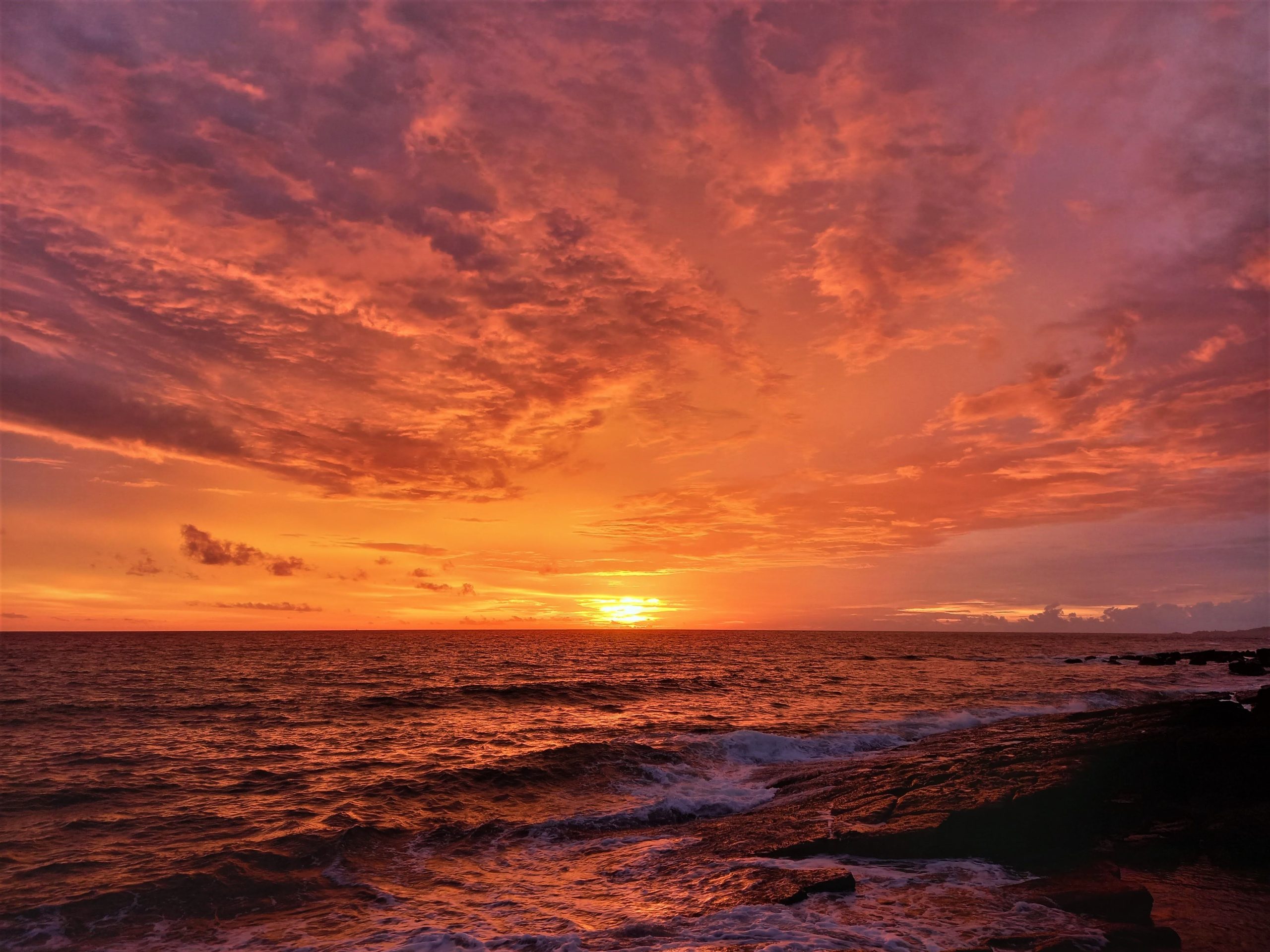

1. Ông Lang Beach:
[View Map]
- Location: central north-west coast
- See & Do: sandy & rocky beaches, low-key vibe, lots of good accommodation, drinking & dining, temples & plantations
- Where to Stay: Mango Bay ($$$), Ocean Bay ($$$), Chen Sea ($$$), The Shells ($$$), Camia ($$), Ancarine ($$), Coco Palm ($$), Coco Garden ($), Island Lodge ($), Ninila Fruit Farm ($)
Description: Peaceful, calm, low-key and low-rise, Ông Lang is a series of connected mini-bays, coves and beaches just 15 minutes north of Dương Đông, the island’s main town. Taking everything into consideration – natural beauty, range and quality of accommodation, drinking and dining options, proximity to conveniences and transportation, the balance of development and the natural environment – Ông Lang is the best overall beach for travellers on Phú Quốc Island. Rather than a long, unbroken beach, Ông Lang is a mixture of soft sand punctuated by slabs of black rock and small jungle-clad bluffs that meet the clear, calm, vivid-blue sea. Being on the west coast, Ông Lang boasts some of the best sunset views on the island. The beach is backed by coconut palms, casuarina trees and tropical fruit orchards along most of its length. Inland, between the beach and the main road, a leafy network of paved lanes and dirt alleyways was, before the pandemic, a thriving tourist enclave of boutique stores, organic-produce shops, hipster cafes, smooth bars and Western restaurants. Today, many of the businesses have closed, but there are signs of a return to the vibrancy of the pre-pandemic period.
Unlike other popular beaches on the island, most of the development on Ông Lang has been low-rise and relatively low-impact. Despite being one of the best-known and popular beaches on Phú Quốc, Ông Lang has somehow managed to retain a low-key atmosphere and it remains an extremely attractive place to stay for a few days on the island. Whether you’re a family, a couple, or a group of backpackers, Ông Lang Beach has got you covered. The general level of accommodation across all budgets is excellent. Luxury and mid-range resorts are along the beachfront, while most of the cheaper options are inland, just a few minutes’ walk from the sea. Mango Bay is quite simply one of the most atmospheric resorts in Vietnam, but Camia, Ancarine, Coco Palm, Ocean Bay, Chen Sea and The Shells are also very nice indeed. Excellent budget options include Island Lodge, Ninila Fruit Farm, and Coco Garden.

Photos of Ông Lang Beach:
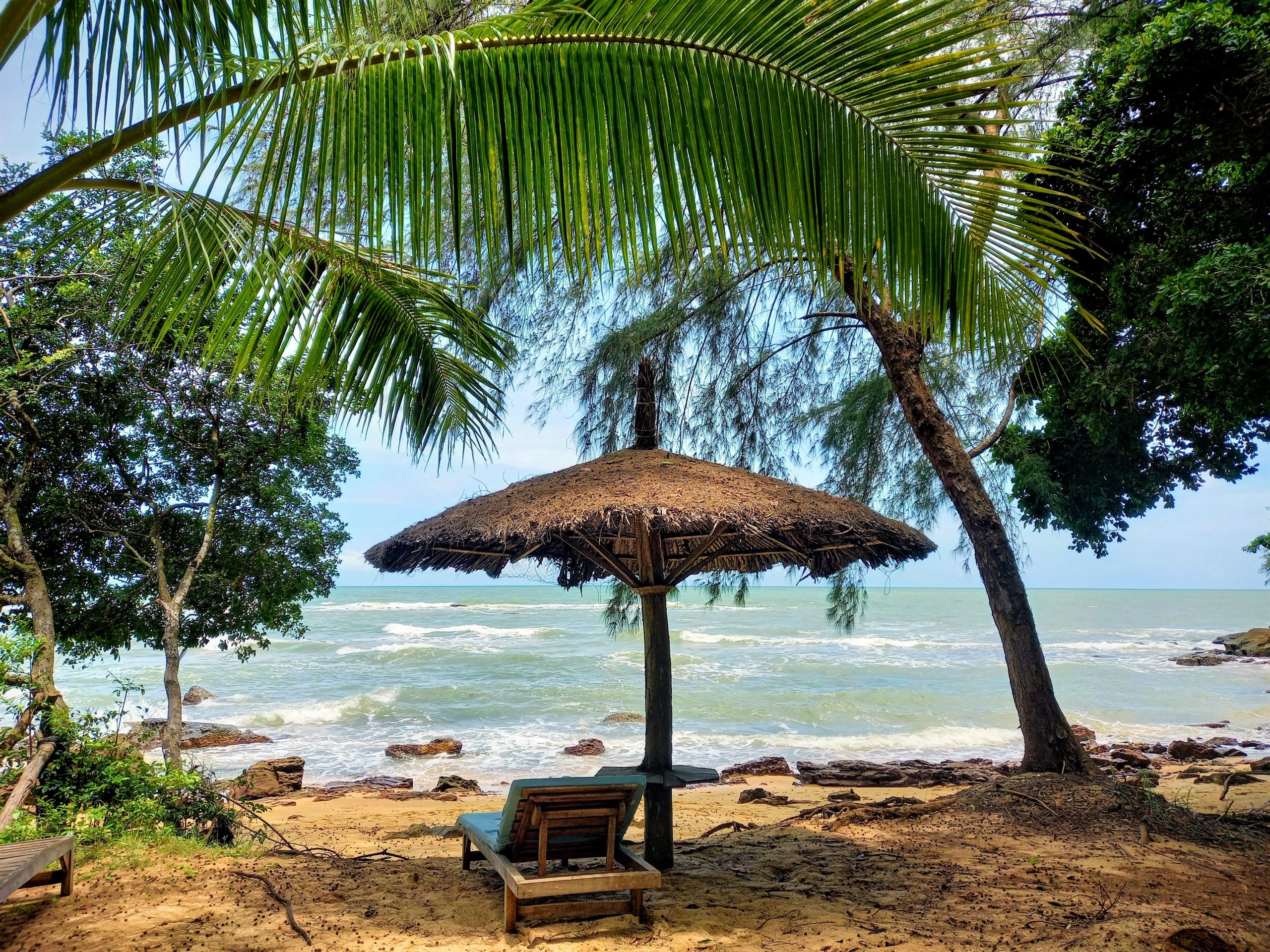
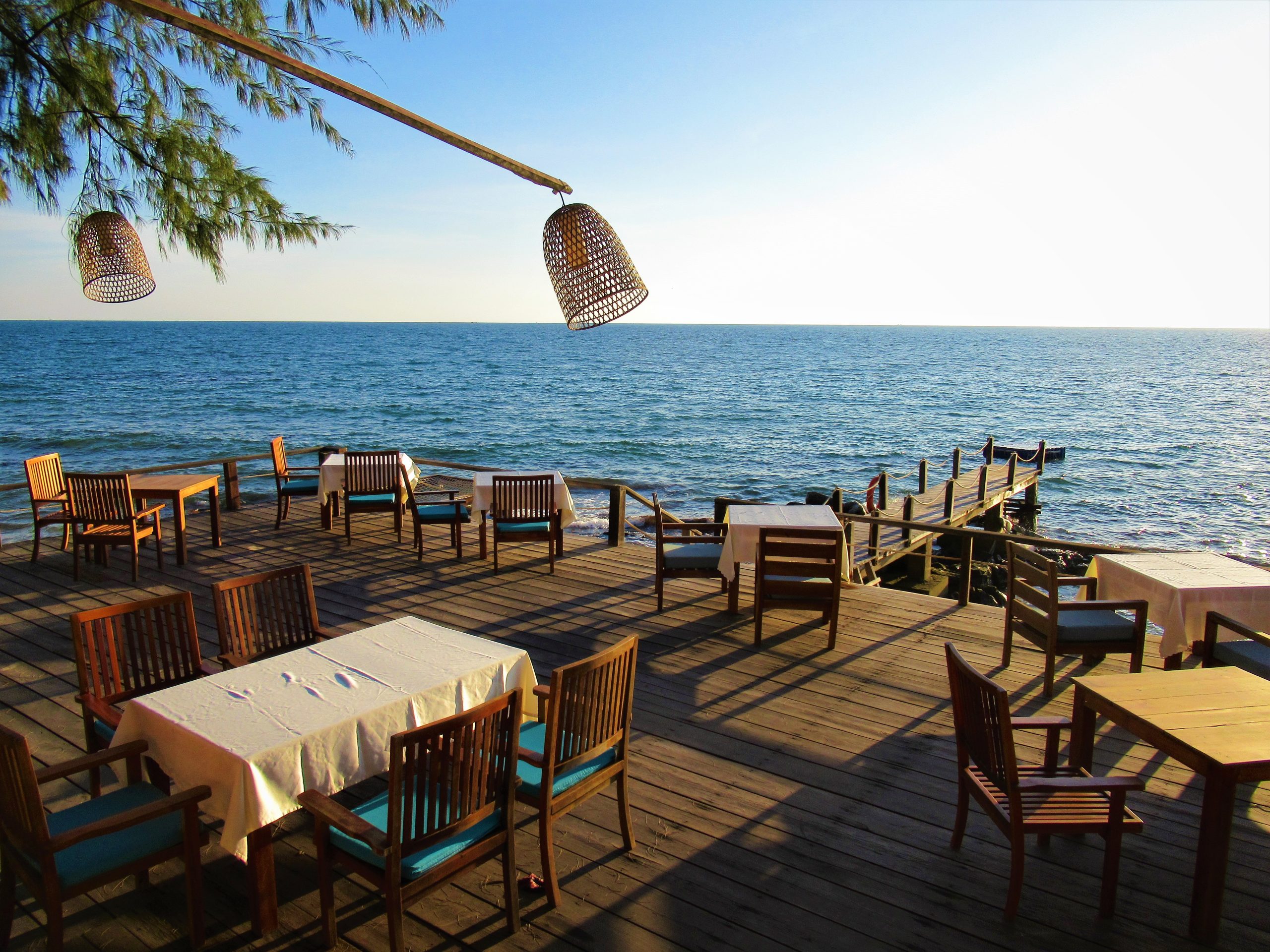

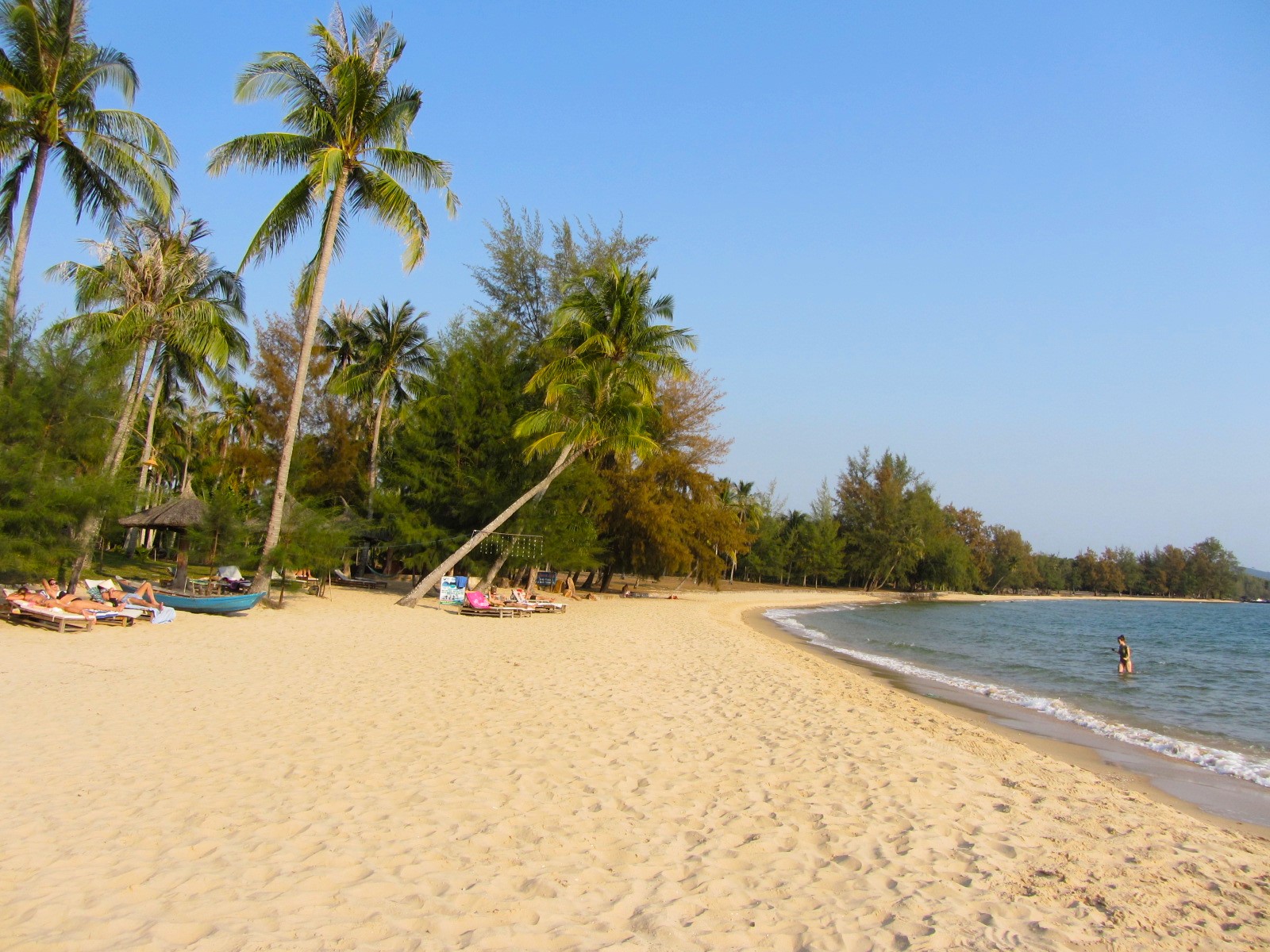
2. Rạch Tràm Beach:
[View Map]
- Location: north coast
- See & Do: long, empty, beautiful beach, swimming, camping, remote fishing community
- Where to Stay: wild beach camping
Description: Right at the northern tip of the island, Rạch Tràm is by far the most remote and least-visited of all the beaches and bays on Phú Quốc Island, and yet it is also one of the most beautiful. Completely undeveloped, Rạch Tràm features kilometres of fine white sand beneath arcing coconut palms lining a calm, clear, turquoise sea. Rạch Tràm fishing hamlet, at the southern end, is a scruffy-looking collection of corrugated-iron dwellings and wooden fishing boats. While there’s some trash from the village in the sea and on the sand, the further north you go along Rạch Tràm, the cleaner it gets. The 10km branch road to the beach is now wide and paved, making access easier than ever before. At the end of the road, bear right along a hundred meters of dirt track, then left down a sandy path until you reach the sea. From here, head north along the sands and enjoy the completely empty beach and wonderful sea swimming. There are plans to make the area into an ‘eco-tourism’ site, but for now there’s no accommodation whatsoever. If you have a tent, camp out on the sands for a memorable night. Behind the beach, densely jungled hills rise into the sky where birds of prey circle; and in the distance, the silhouettes of the Cambodian mainland and islands are clearly visible.
Photos of Rạch Tràm Beach:
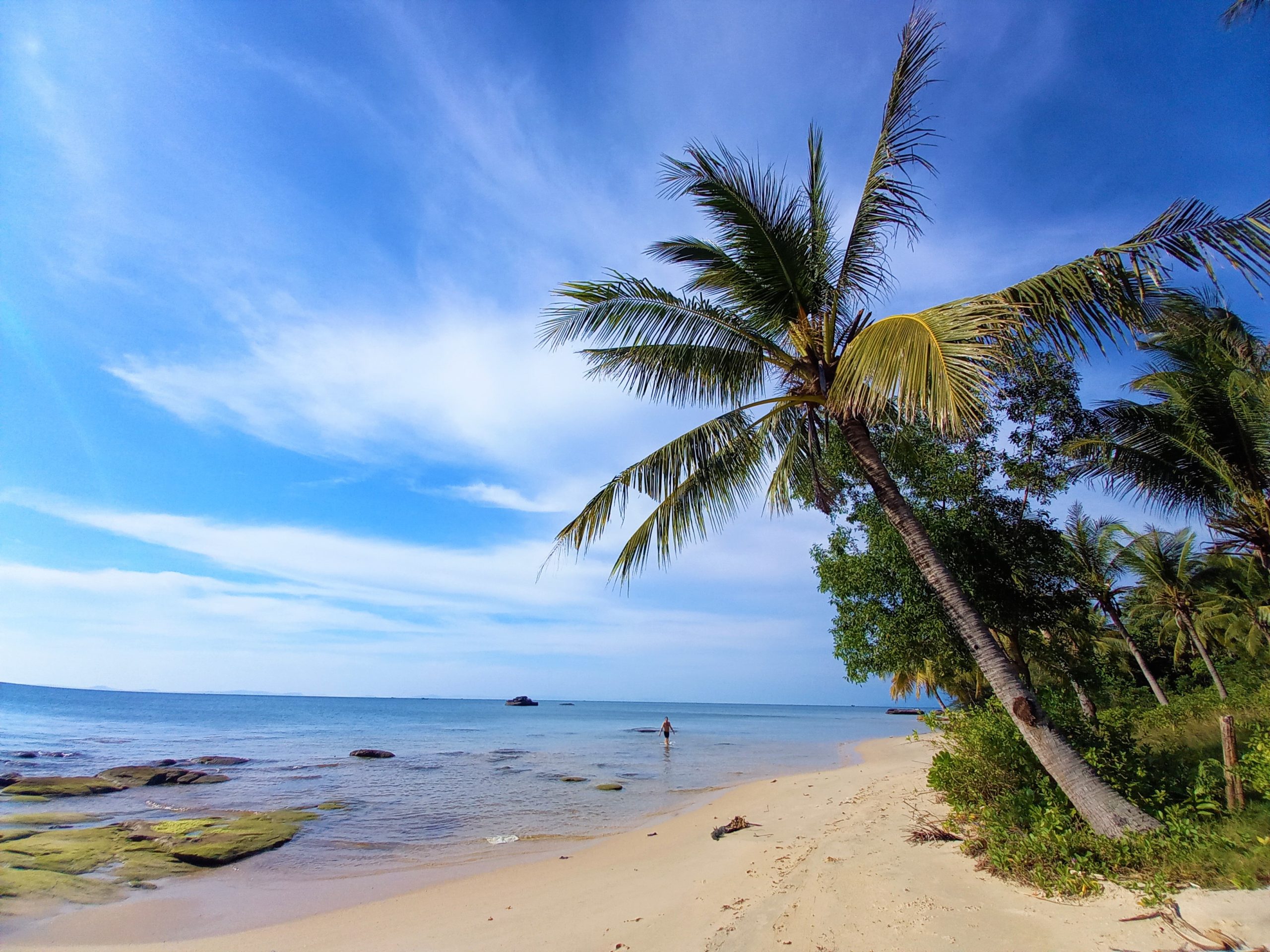
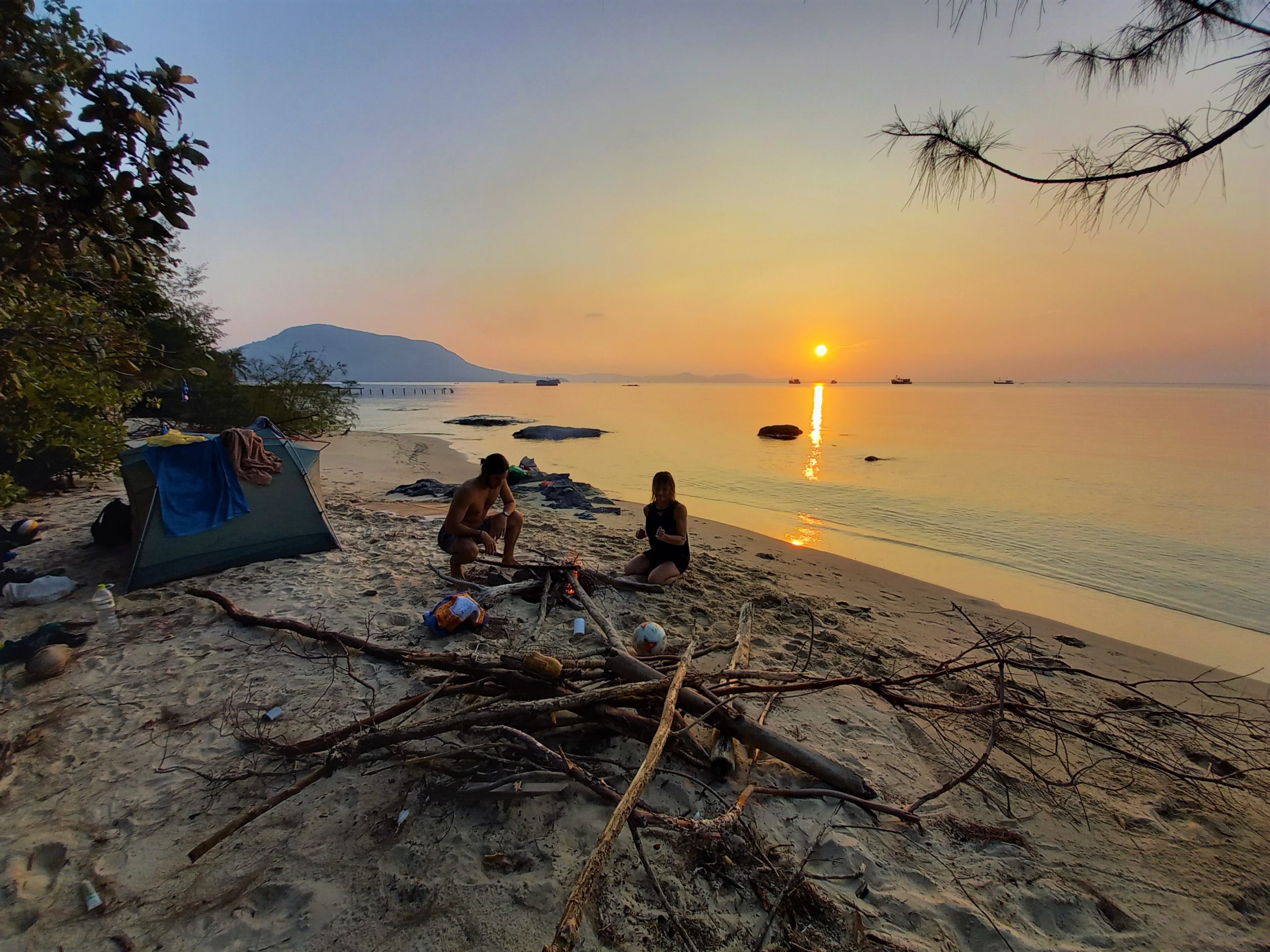
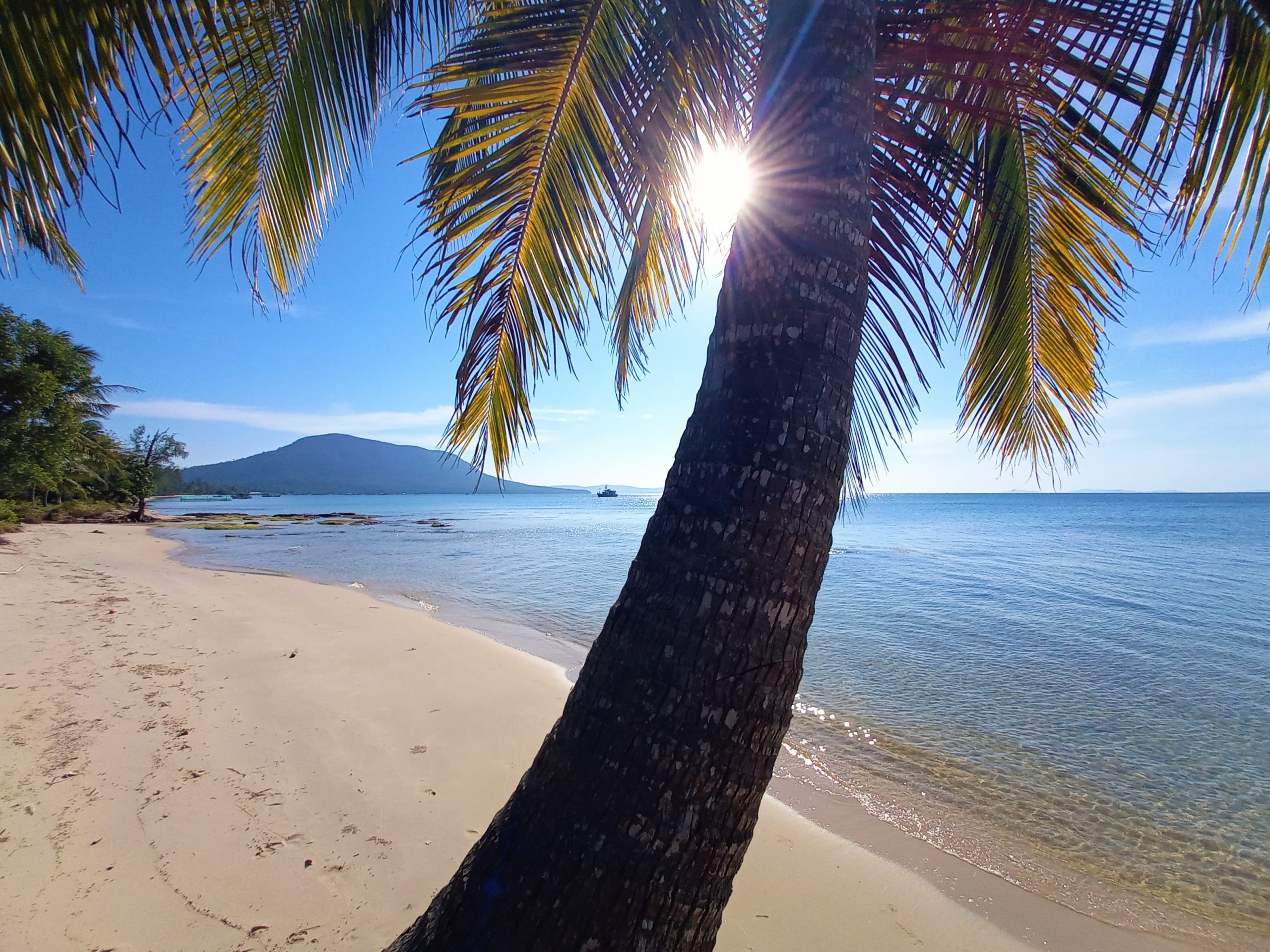

3. Gành Dầu Beach:
[View Map]
- Location: north-west coast
- See & Do: wonderful coastal vistas, watersports, good accommodation, fishing village, street food, seafood restaurants, local life
- Where to Stay: Gold Coast ($$), Peppercorn ($$$), Hula Hula ($$), Kim 2 ($), Dum Bo ($)
Description: On the remote northwestern tip of the island, Gành Dầu is a fascinating little corner of Phú Quốc. Gành Dầu is a rocky, jungle-clad cape within just a few of kilometres of Cambodia, whose forested islands and rugged mainland can be seen across the glistening sea. Gành Dầu is a bustling fishing village with an active and interesting market, a harbour full of wooden boats, an ornate temple, and lots of street food and local life. Either side of the village there are short, sandy beaches and coves which are very pretty and good for swimming. The western beach is close to the village and lined with some good seafood restaurants, such as Biên Hải Quán, a couple of great beachside bars with sea views (check out Chill Bistro and 40six Beach Haus, which are perfect for cocktails and a swim as the sun sets behind the Cambodian islands), and a waterfront raised wooden walkway leading along the rocks to the south.
But, the best way to experience Gành Dầu is to take the paved lane east of the village, through the market and out to a collection of good, small, beach resorts. Here, coconut palms grow tall over spits of white sand, and the sea is calm and blue. By far the best place to stay (and eat and drink and swim) is Gold Coast with it’s lovely little beach, wooden house restaurant by the sea, and great cocktails served on a pier with sunset views. If you’re looking for something cheaper, Kim 2 is a good option. There’s also a range of watersports available at Gió Biển.
Photos of Gành Dầu Beach:
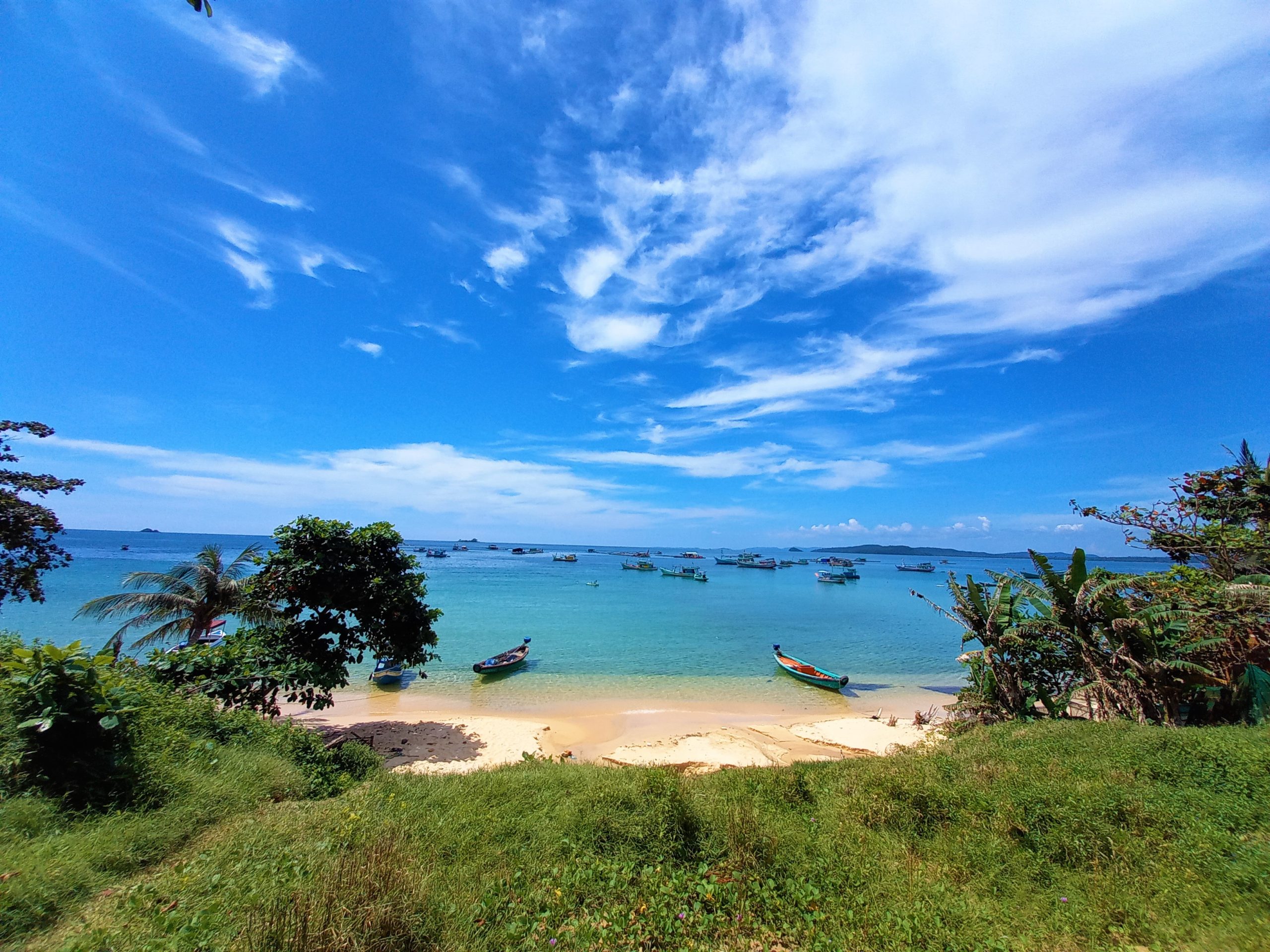

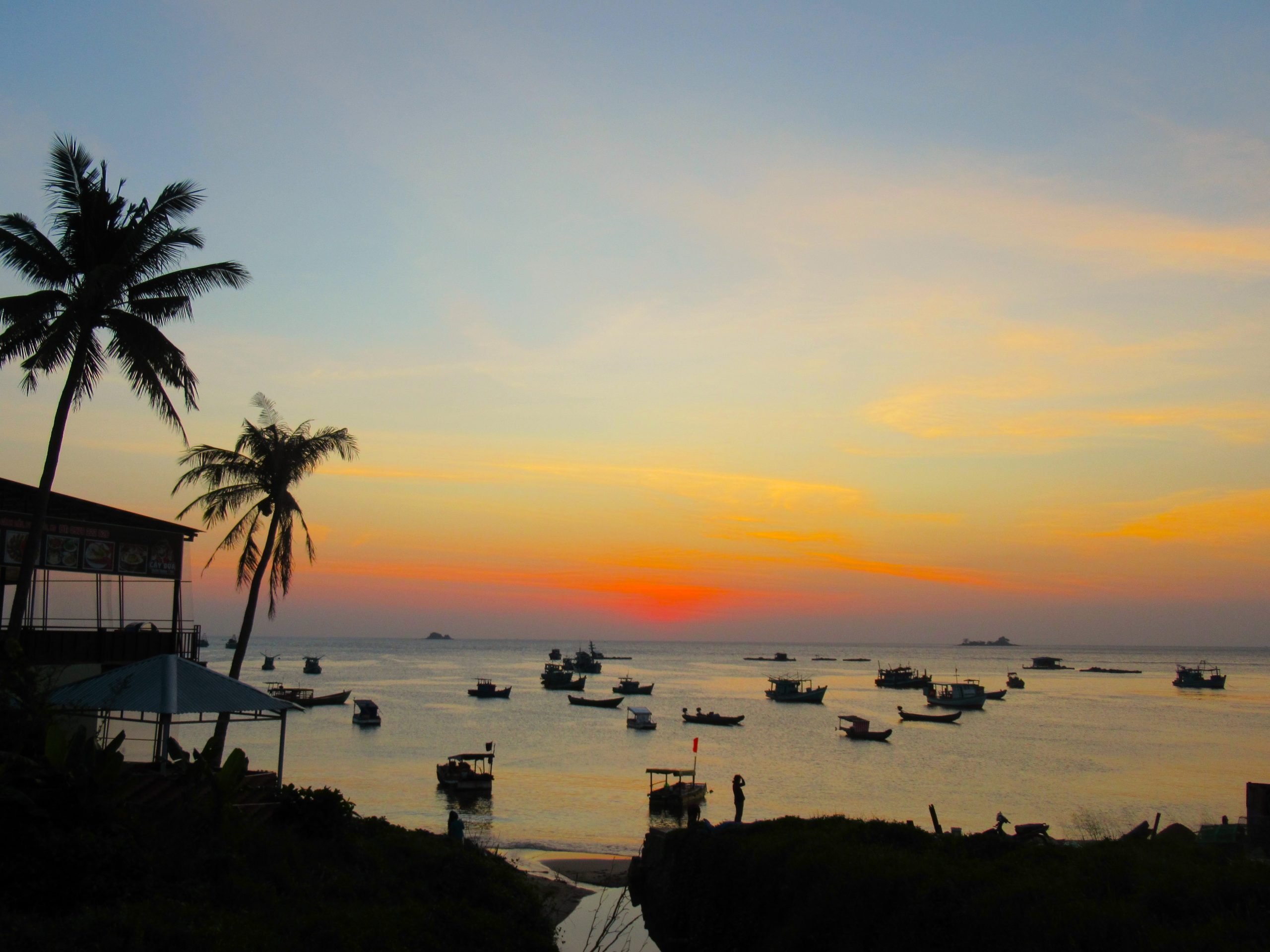
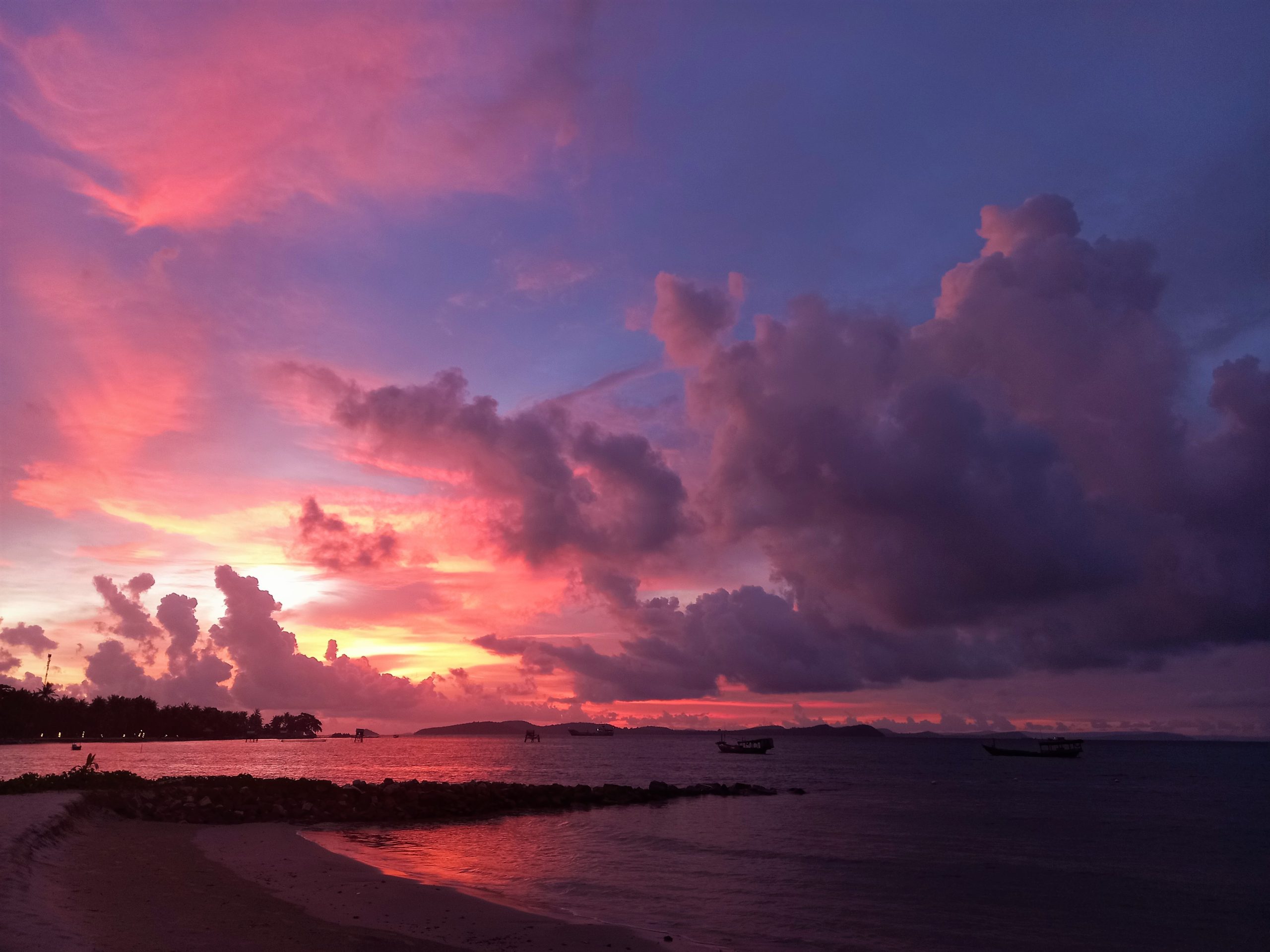
4. Hàm Rồng (Dragon) Beach:
[View Map]
- Location: north coast
- See & Do: beautiful beach only accessible by boat, excellent swimming, beach camping, watersports
- Where to Stay: wild beach camping
Description: Only accessible by boat, Hàm Rồng (Dragon) Beach is a long, narrow lip of white sand sliding into shallow, turquoise water backed by dense jungle with dramatic hills rising behind. The location is beautiful. There’s no development here apart from some wooden platforms for daytrip picnics and group camping, and a boat house for watersports equipment and a small homestay hut. The stunning 10-minute boat ride can be arranged from any of the seafood restaurants on neighbouring Rạch Vẹm (Starfish) Beach, just to the south. With some negotiating, you should be able to get the price down to a reasonable 100,000vnd per person for a group of at least four people. Dragon Beach has two rickety wooden piers at either end, but the boat can drop you anywhere you like along the sand. The northern end is popular with day-trippers and it looks like there’s going to be some small development here, so if you want a peaceful, quiet and isolated patch of sand, stick to the southern end. Out in the distance, you can see the jungle-covered hills of Gành Dầu, the northwestern-most point of Phú Quốc, beyond which the Cambodian islands and mainland are clearly visible. There’s currently no accommodation on Dragon Beach, but this may change soon. However, wild camping on the beach is a magical experience if you have your own equipment.
Photos of Hàm Rồng (Dragon) Beach:
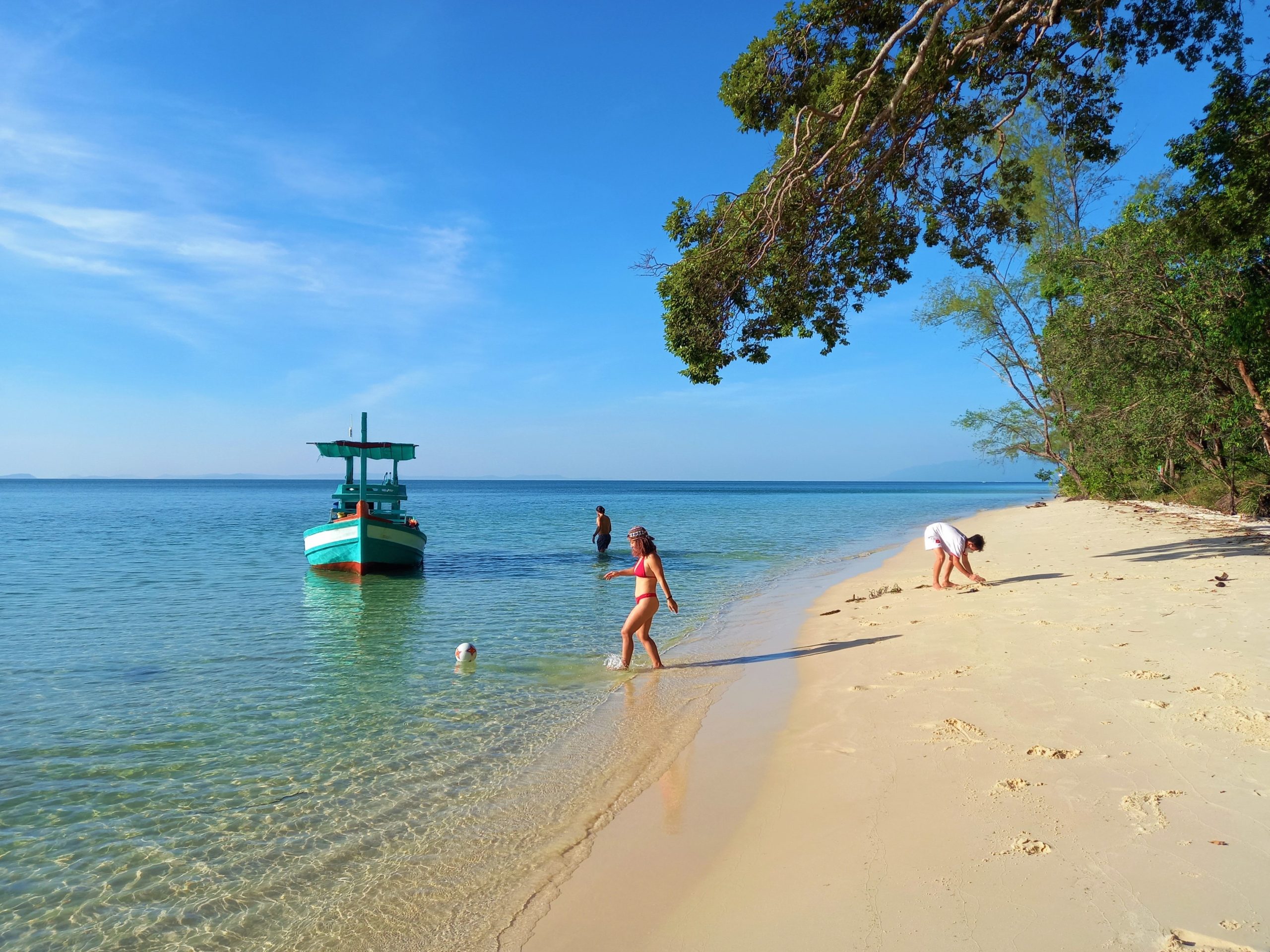

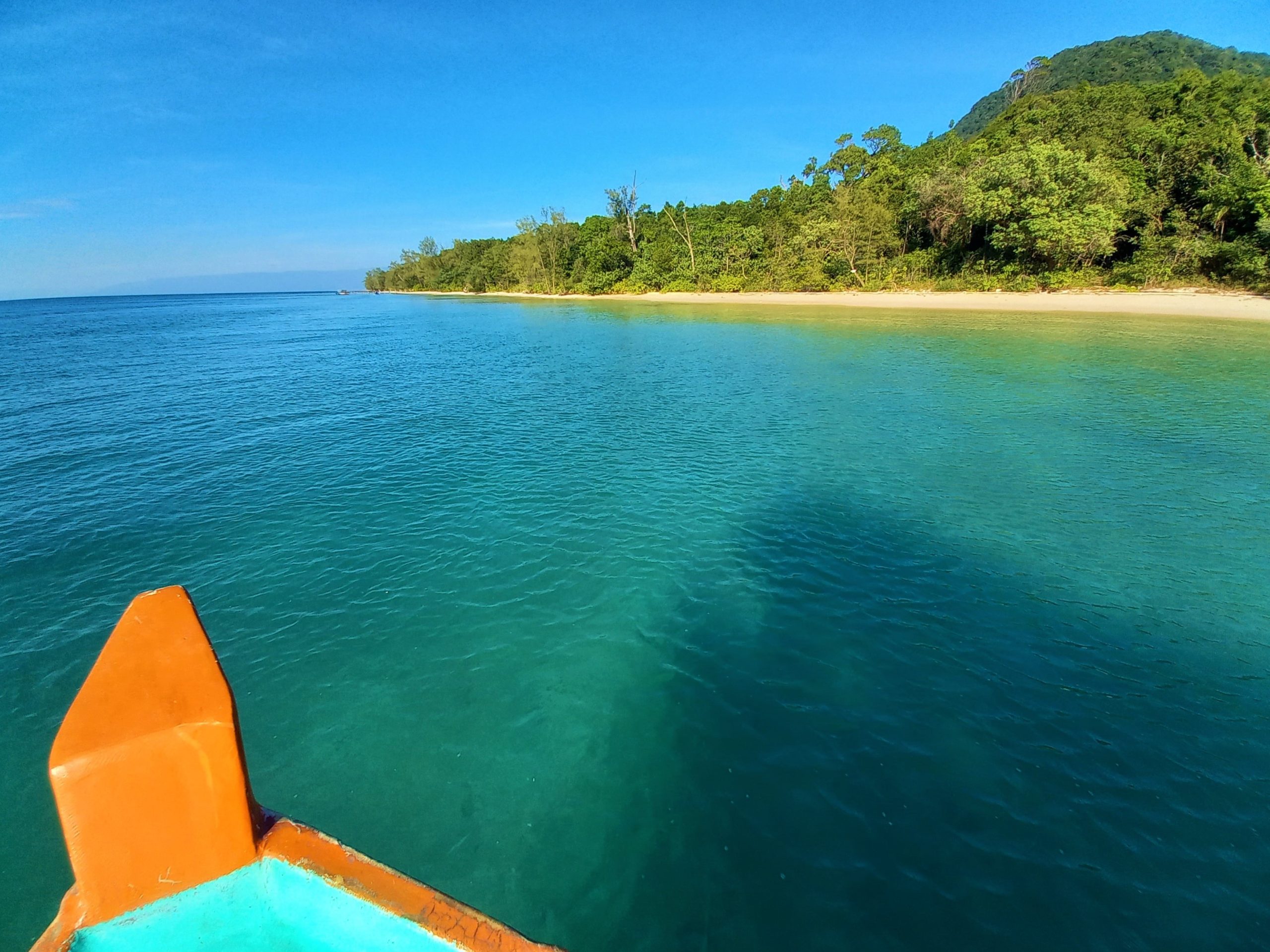
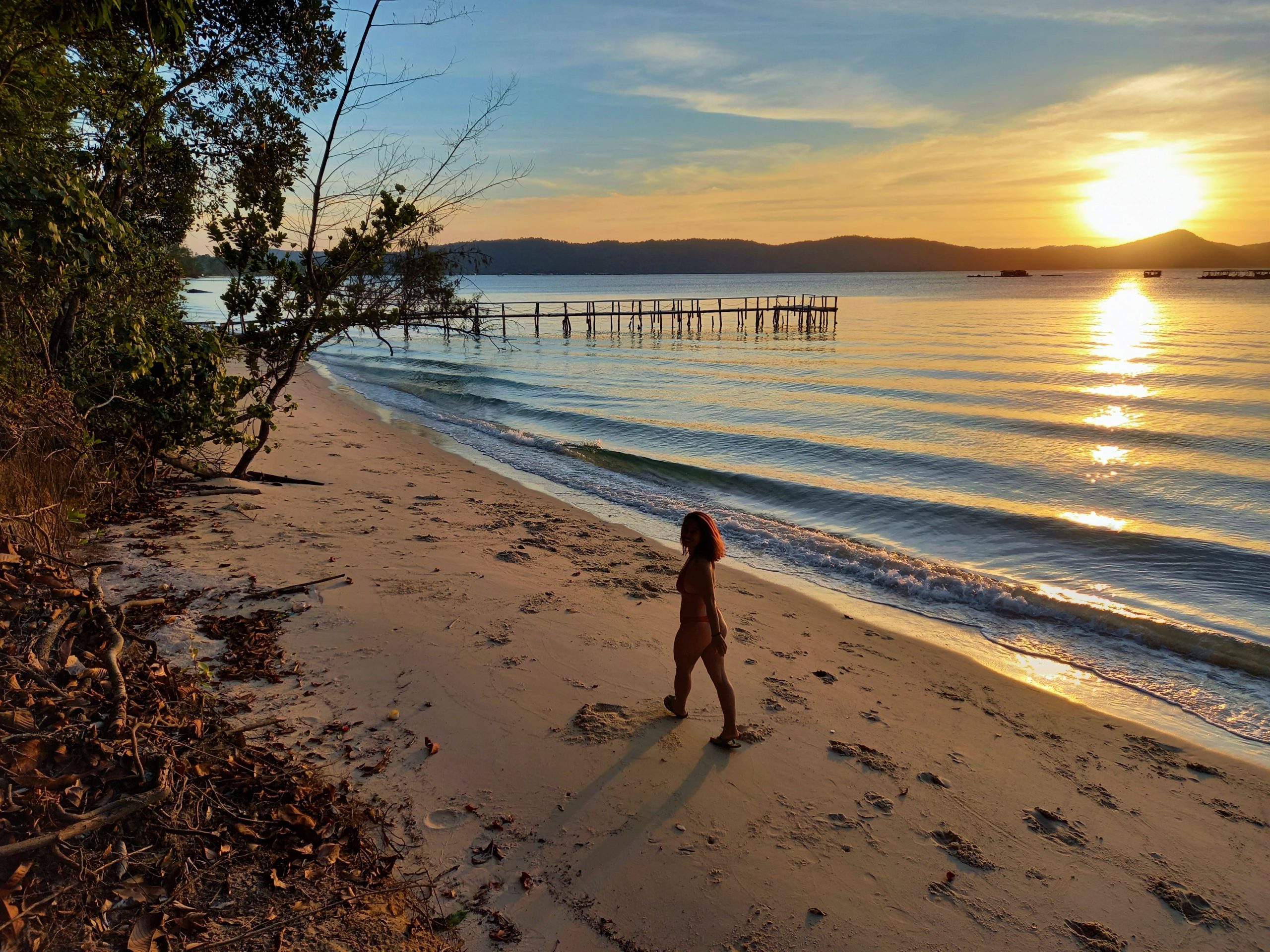
5. Vũng Bầu Beach:
[View Map]
- Location: north-west coast
- See & Do: long, beautiful beach, quiet, green, modest development, great swimming
- Where to Stay: Nam Nghi ($$$), Bamboo Cottages ($$), Gold Sand ($$), Wild Beach ($$), Vung Bau Resort ($), Mai Phuong ($)
Description: One of the most attractive bays on the island, Vũng Bầu is a long, arcing stretch of sand on the north-west coast. Development has been very slow and most of the beach is still empty. There are a handful of mostly low-key resorts at the northern end, but the south remains untouched. However, much of the central and southern section are roped off to visitors and there are rumors that Vingroup has acquired the land, which usually heralds the beginning of gigantic resort construction and the destruction of all trees. But, for now, travellers can enjoy the lovely sands and sea of the northern bay, particularly at Bamboo Cottages, Gold Sand, and Wild Beach, which are all quiet, small, low-rise mid-range properties. The classy Nam Nghi Resort, which occupies the beautiful northern cape, was under renovation at the time of research, but promises to reopen with a new ‘island bar’ on the little islet just offshore. Access to Vũng Bầu is easiest from the north via the paved road to Nam Nghi and then the dirt road to the small resorts. It’s also possible to take the dirt road from the south, past Green Bay Resort, and through the jungle to a small section of beach right at the southern end. The centre of the bay is off limits.
Photos of Vũng Bầu Beach:

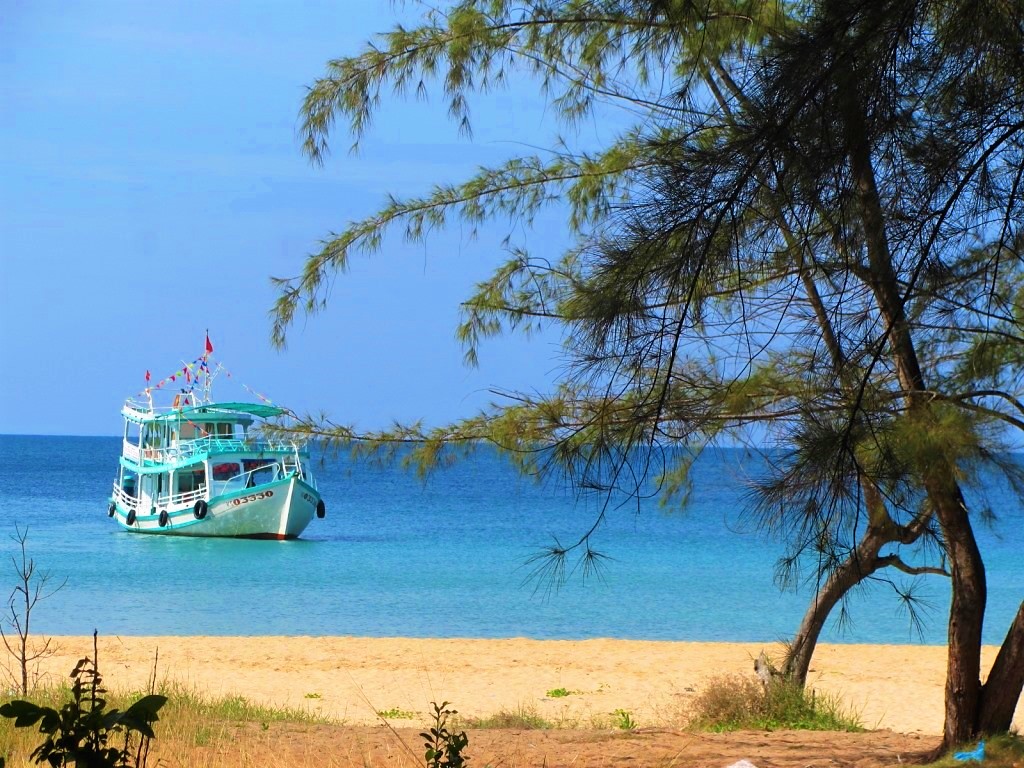
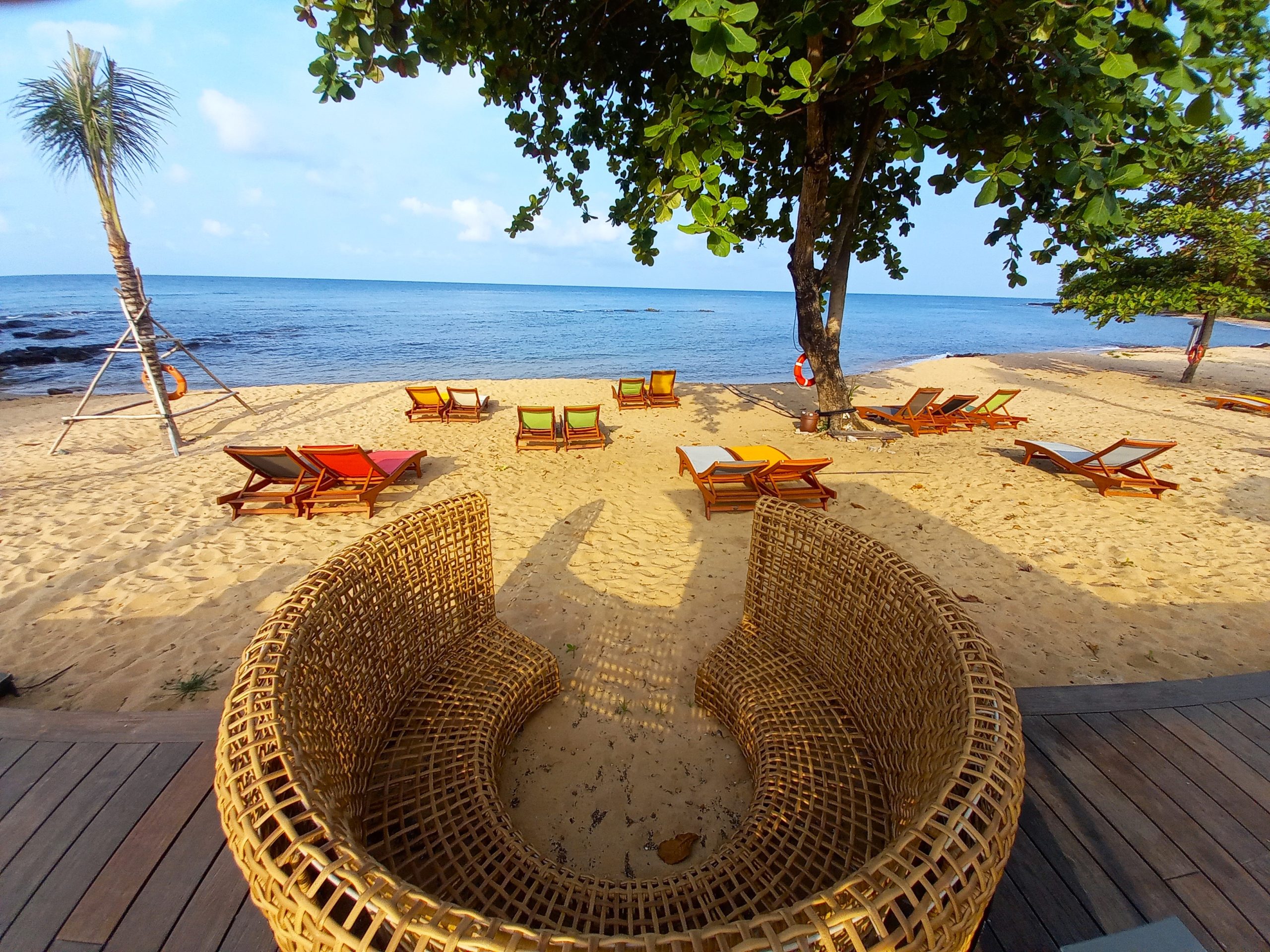
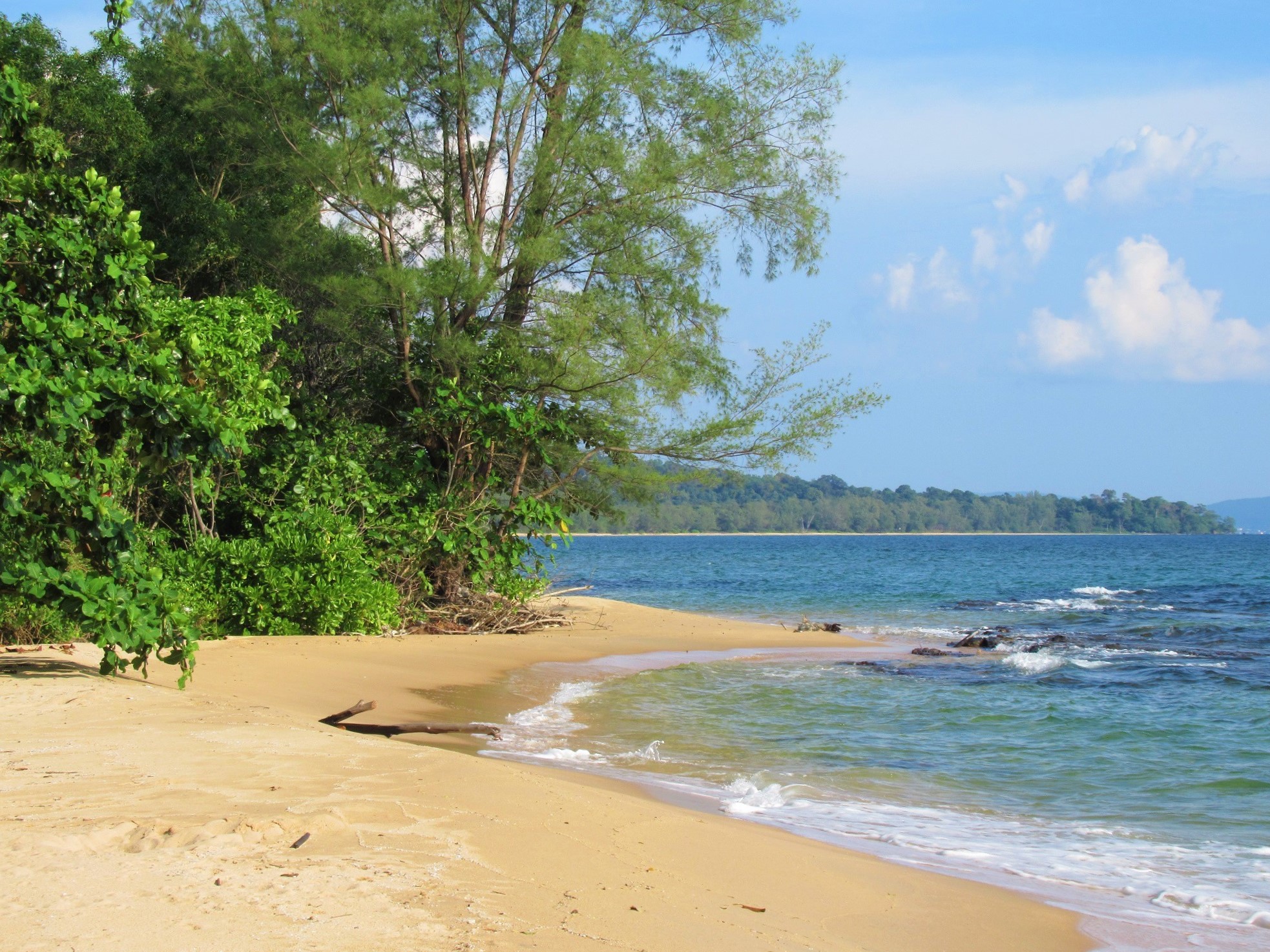
6. Cửa Cạn Beach:
[View Map]
- Location: north-west coast
- See & Do: long, local beach, fishing village, temples, riverside restaurants, good accommodation, watersports, low-key vibe
- Where to Stay: Green Bay ($$$), Movenpick Waverly ($$$), Chez Carole ($$), Phu Quoc Eco Lodge ($), Eco Lagoon ($), Rain Forest Resort ($)
Description: Mellow, slow-paced and yet to be developed, Cửa Cạn is a small settlement in the north-west of the island, situated at the point where a clear-flowing river empties into the sea. As it drains into the Gulf of Thailand, the river creates a long sandbar lined with casuarina trees, with the sea on one side and the river on the other. The village is a bit run-down, but it’s a friendly place with some street food and several tiny alleyways leading onto the beach. It’s a lovely spot under the casuarina trees with Dinh Bà Thủy Long temple facing the ocean. The sea is good for swimming, but the beach suffers from trash: it functions as an informal dump for the village. There are two excellent resorts at the northern end of Cửa Cạn Beach: Green Bay and Chez Carole. Much cheaper but still very atmospheric accommodation can be found just back from the beach, overlooking a lagoon formed by the river: Eco Lodge and Eco Lagoon. There’s also a good local seafood restaurant here, called Huỳnh Bình. To the south of the river mouth, although not technically Cửa Cạn Beach, the Mộ Bà Lê Kim Định shrine is an OK place to swim and the enormous, very well-equipped and well-run (if a bit characterless) Movenpick Waverly Resort has a great stretch of beach too.
Photos of Cửa Cạn Beach:



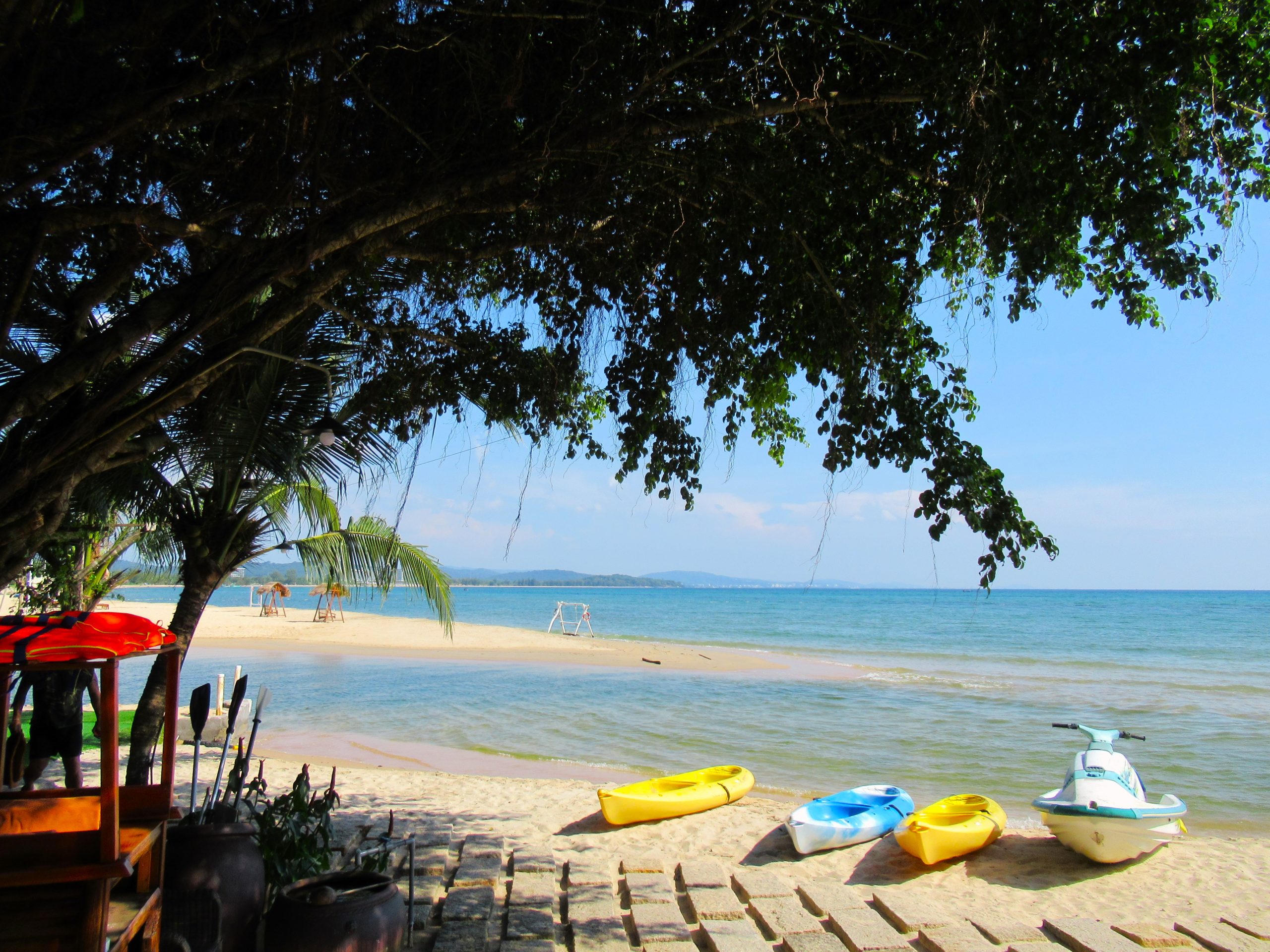
7. Rạch Vẹm (Starfish) Beach:
[View Map]
- Location: north coast
- See & Do: good beach & bathing, snorkeling with starfish, excellent floating seafood restaurants
- Where to Stay: wild camping, hammocks
Description: Reached via a sandy lane, which itself is off a long red-dirt road traversing the densely forested northern coast, Rạch Vẹm (better known as ‘Starfish Beach’) is remote, and this has so far kept development away. Over the last few years, Rạch Vẹm has become a popular day/lunch trip (especially for domestic tourists) due to its abundance of floating fish farms (which double as excellent seafood restaurants) and the hundreds of red starfish that live in the shallow water here. It’s a very beautiful location: the sand is backed by coconut palms and the water is blue and clear. The southern section is scruffy and suffers from litter, but the further north you go, the cleaner and more beautiful it gets. As everywhere else on the island, resort development is on its way, but as yet there’s no large-scale tourist development at all. At present, there’s nowhere to stay on Starfish Beach, although camping is possible if you have your own equipment or you can ask to rent one of the many hammocks on the sand for a night. Don’t miss a seafood lunch or dinner at one of the many waterside restaurants, particularly Nguồn Sống and Ngàn Sao Biển. In the high-season months, inflatable slides float offshore for children (and adults) to enjoy.
Photos of Rạch Vẹm (Starfish) Beach:

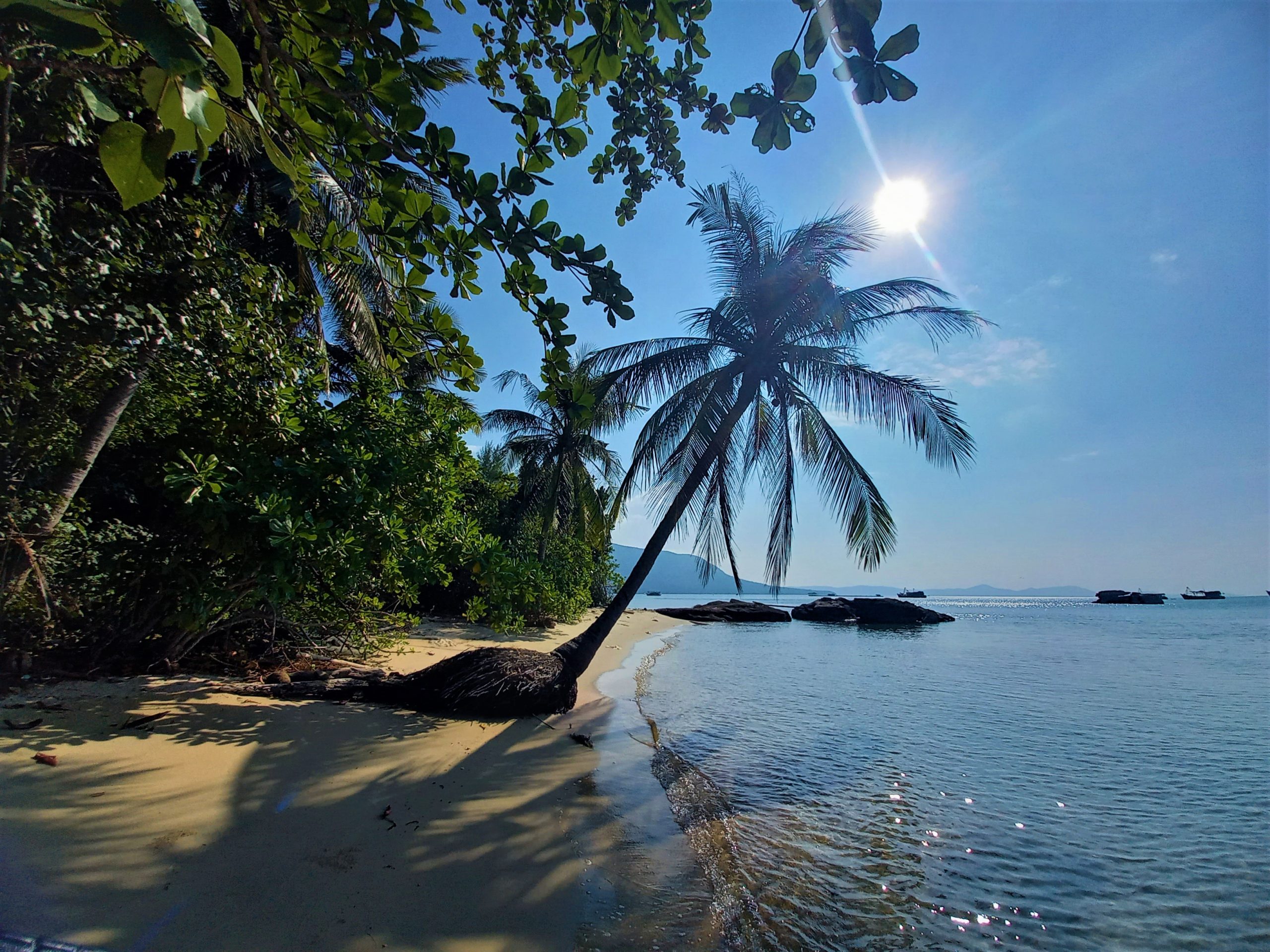

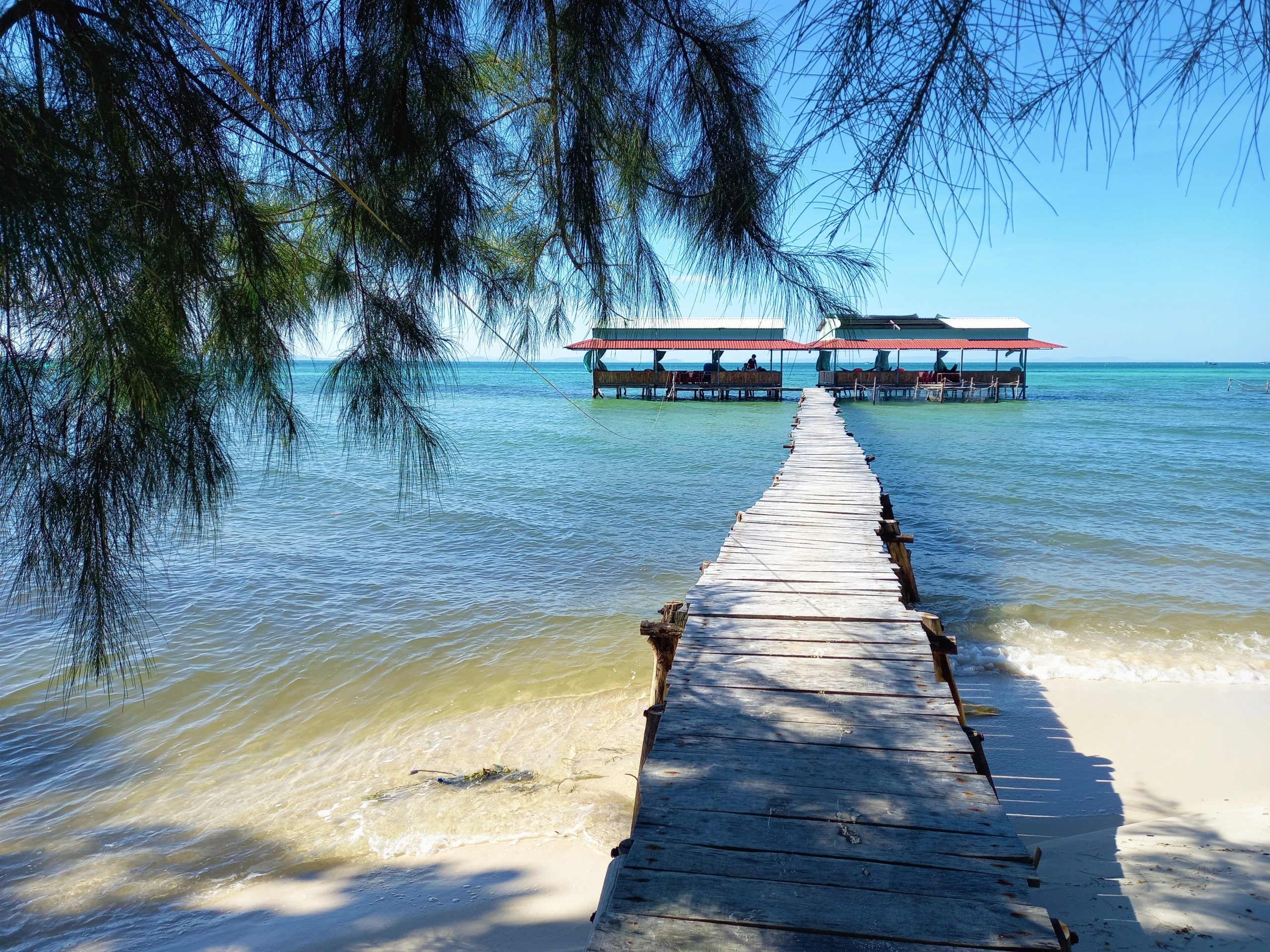
8. Cây Sao Beach:
[View Map]
- Location: east coast
- See & Do: serene coastline, very green & dramatic scenery, up-and-coming beach area, good accommodation, beach bars, seafood restaurants
- Where to Stay: The Pier ($$), Kiki Coconut ($), Cây Sao ($$), Jade Mountain ($), Mango Beach ($$), Cosiana ($$), Rory’s ($$)
Description: Only in the last few years, since the east coast road was paved, have visitors started to flock to the alluring coastline of Cây Sao. This long, enchanting section of the east coast is one of the most up-and-coming beaches on the island right now. In large part this is due to the laid-back vibe, quiet setting and beautiful natural surrounds of Cây Sao. But it’s also because Rory’s Beach Bar relocated here from the west coast several years ago, suddenly shining a light of this part of Phú Quốc and giving travellers a reason to visit. Rory’s is a popular long-running island establishment and the new location is an oasis of trees, pools, rocky coves, wooden decks, treehouses, bungalows and, of course, the bar and restaurant itself. To the north and south of Rory’s several very good small resorts dot the rocky coastline, including The Pier, Kiki Coconut, and Cây Sao Beach Resort, among others. These are all great places to soak up the tranquil atmosphere and paddle in the shallow waters of the east coast. Though it may lack the long sandy beaches of other parts of the island, Cây Sao has a charm and isolation that’s more and more appealing to me with each passing year, especially as construction, crowds, and the general paraphernalia of mass tourism continue to take over much of the rest of the island.
Photos of Cây Sao Beach:

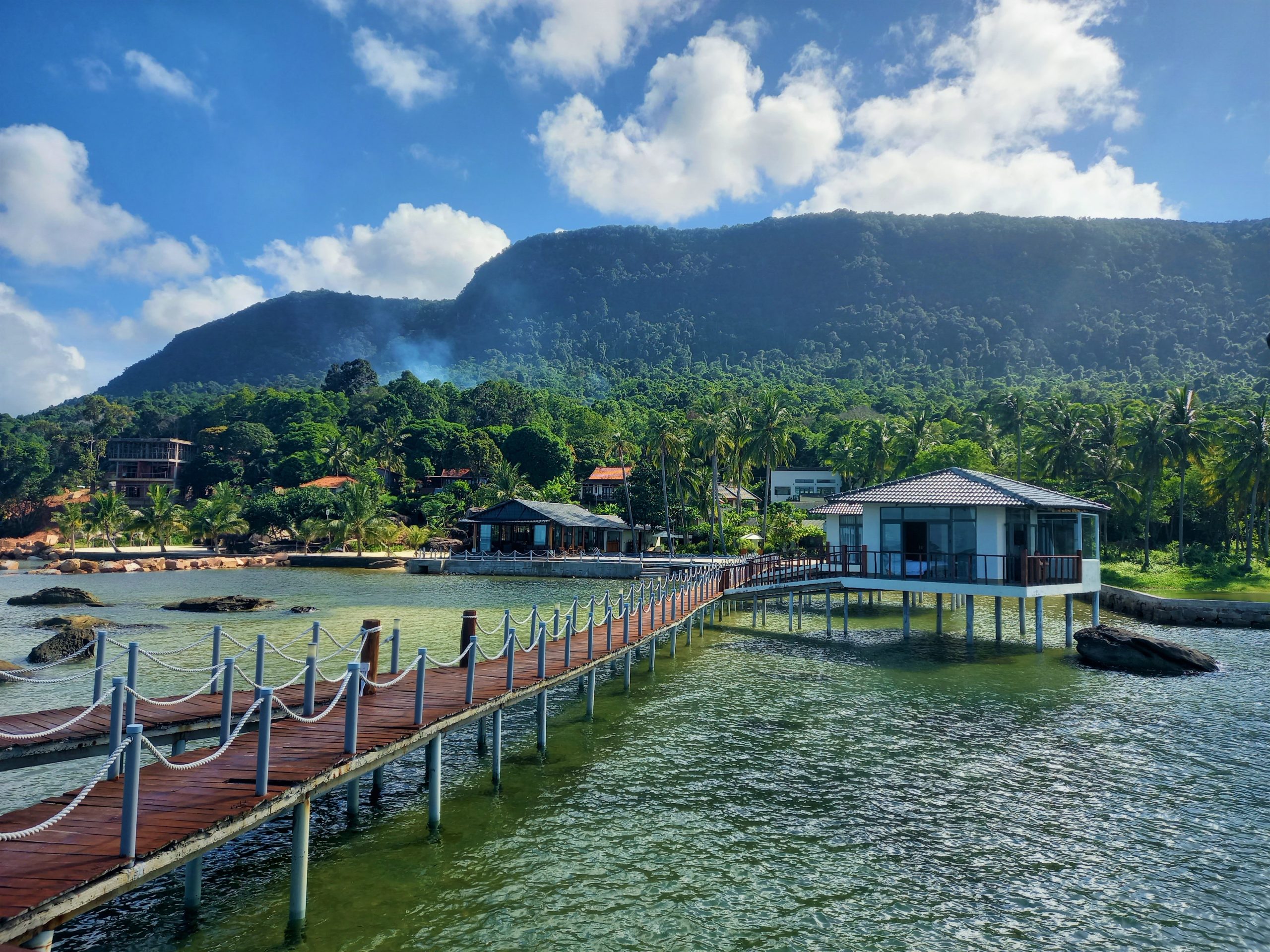

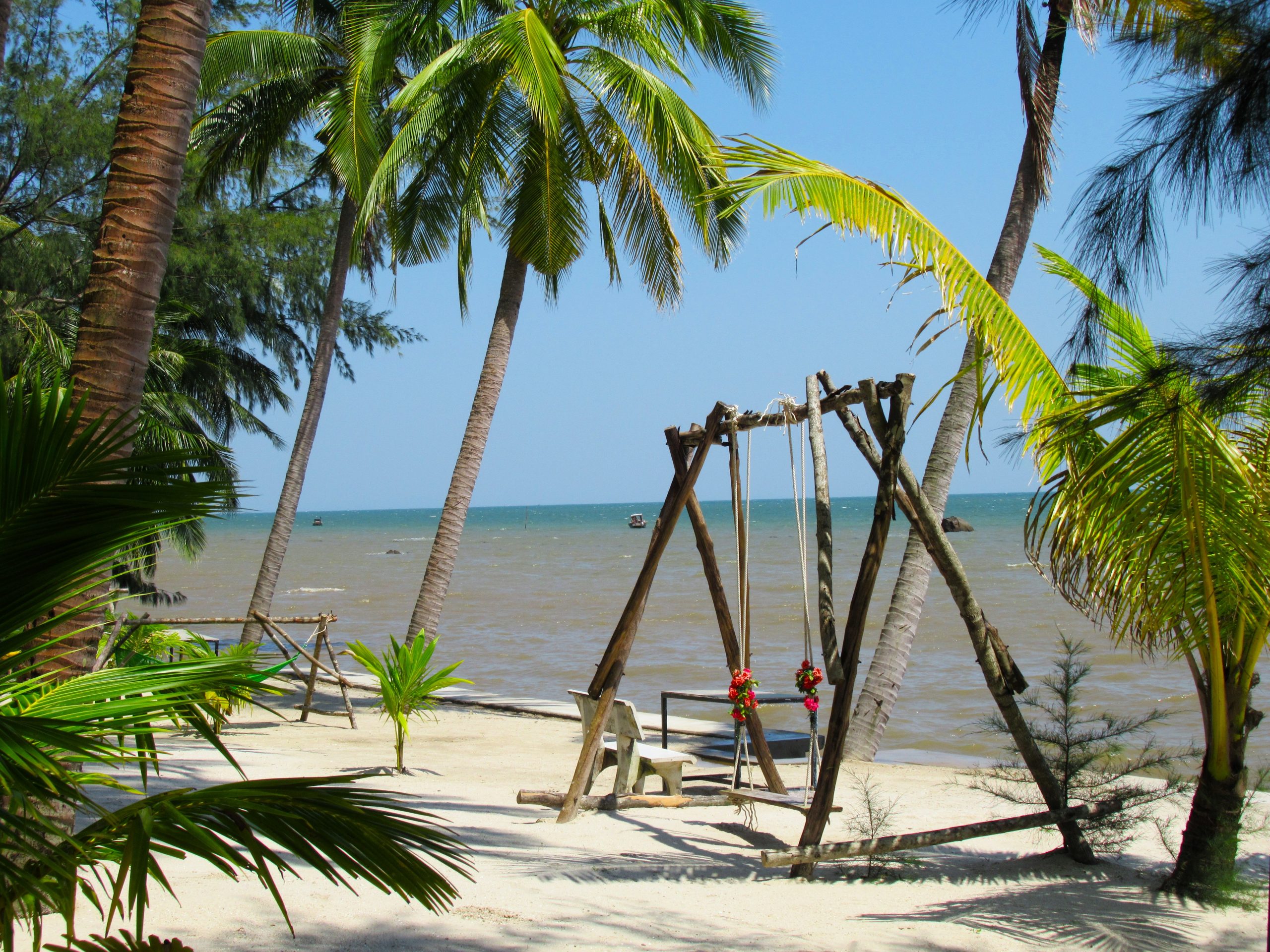
9. Trường (Long) Beach:
[View Map]
- Location: central & south-west coast
- See & Do: long stretch of sand, good swimming, loads of accommodation, bars, restaurants, partying, shopping, watersports, selfie-parks
- Where to Stay: Thanh Kiều ($$), Lahana ($$), Cassia Cottage ($$), 9Station Hostel ($), Freebeach ($), Salinda ($$$), Dusit Princess ($$$), SOL ($$$), InterContinental ($$$), Sailing Club ($$$), Regent ($$$)
Description: Aptly named, Long Beach (Bãi Trường) stretches for almost 20km along the southwestern coast of Phú Quốc. Beginning just south of Dương Đông town and stretching almost as far as An Thới on the southern-most tip of the island, the beach’s yellow sand is backed by rows of coconut palms, and the sea is placid and clean for much of the year (November-May). Long Beach is by far the most developed on the island, boasting hundreds of places to stay, drink, dine and shop for all budgets. However, this also means that it is the most densely populated beach on the island, and the central and southern sections are the scene of some of the most intense and large-scale development on Phú Quốc. Long Beach can be roughly divided into three sections: the north (from Dương Đông down to the airport), the centre (from the airport to the Intercontinental), and the south (down to the cape near Đất Đỏ Beach):
The northern section of Long Beach is the original Phú Quốc tourist strip. This is where the majority of visitors to the island stay, in one of the many good budget, mid-range, and high-end accommodations available. In general, the mid- and high-end resorts are on the beach side of the road, while the budget guest houses, hostels, restaurants and bars are on the other side. These days, the road is pretty busy and unpleasant. But, head down any of the smaller lanes to the seaside resorts, and the beautiful, palm-studded beach reminds you why all this development is here in the first place. However, it’s getting pretty cluttered along the beach, and noise pollution can be an issue at night. But, providing you’re staying in good, beachside accommodation, the northern section of Long Beach is still a very satisfying place to spend a few days on the sand. I love the lush, calm oasis of Thanh Kiều right on the beach or the beautifully judged Lahana Resort which is on a hillside away from the beach and is also home to one of the best backpacker digs, 9Sation Hostel. Salinda is a solid luxury option. The northern section is also the drinking and partying capital of the island: check out Bittersweet, OCSEN and Chuồn Chuồn for a start.
The central section of Long Beach begins south of the International Airport, where huge chunks of beachfront are portioned off to different international resort developers: Pullman, Novotel, Hyatt, Intercontinental etc., each have giant slabs of land featuring huge resorts, many of which are still under construction. This area is generally referred to as Dương Tơ. If you’re not staying at one of the large resorts, you can still enjoy the beach here by visiting places like Sunset Sanato Beach Club where there are creative sculptures by the sea designed for selfies, or the Sailing Club for good food and drink, or INK 360 rooftop bar at the InterContinental for extraordinary views.
The southern section of Long Beach stretches beyond the Intercontinental, where yet more enormous resort developments are underway. But, even further south, construction dissipates a bit, leaving the old red dirt road to plough its course along the serene coast all the way to Mũi Xếp Cape. Here, there are still a couple of deserted stretches of beach to bathe in the calm, clear sea. Unfortunately, trash and construction debris are a problem.
Photos of Trường (Long) Beach:
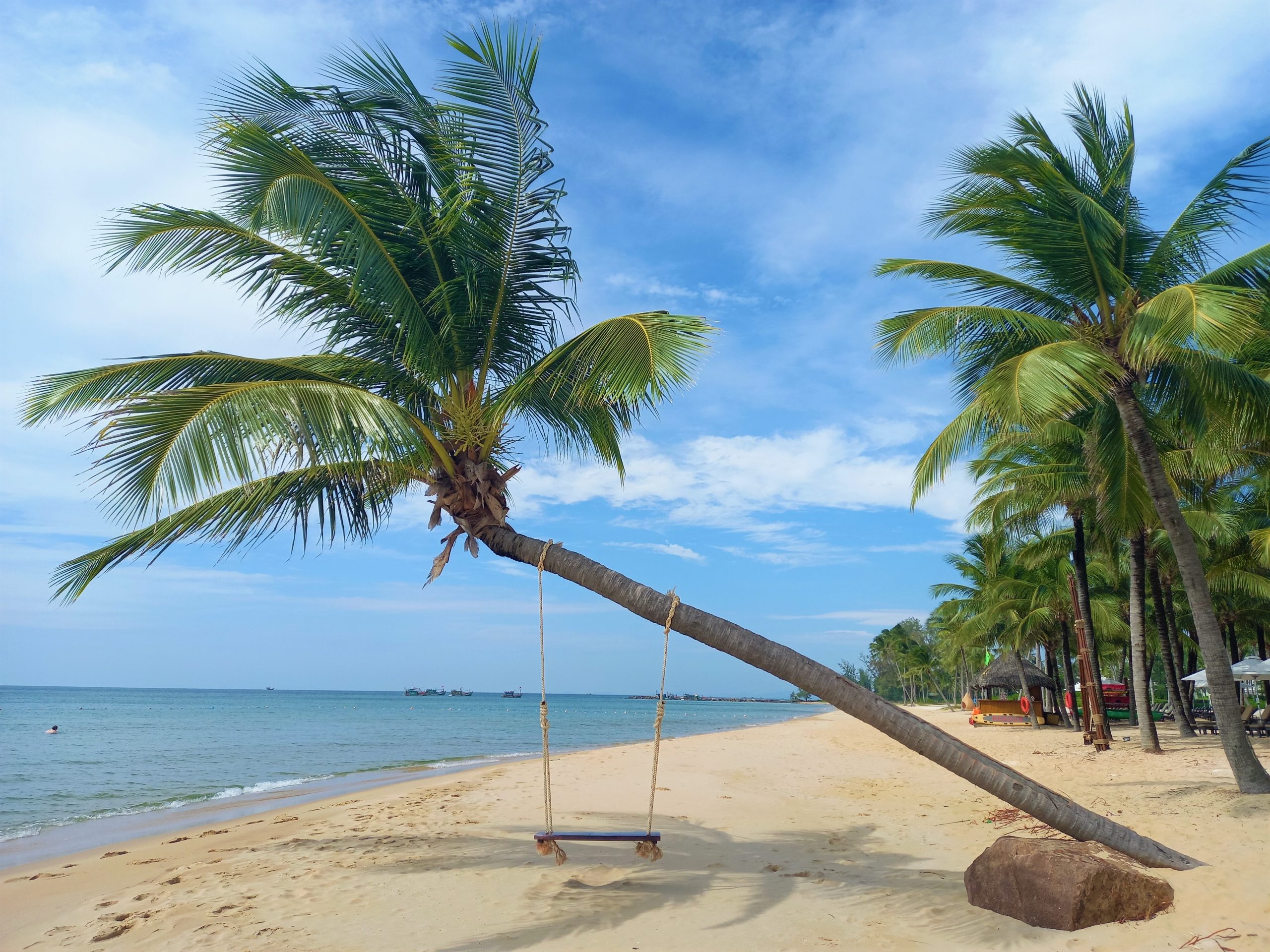
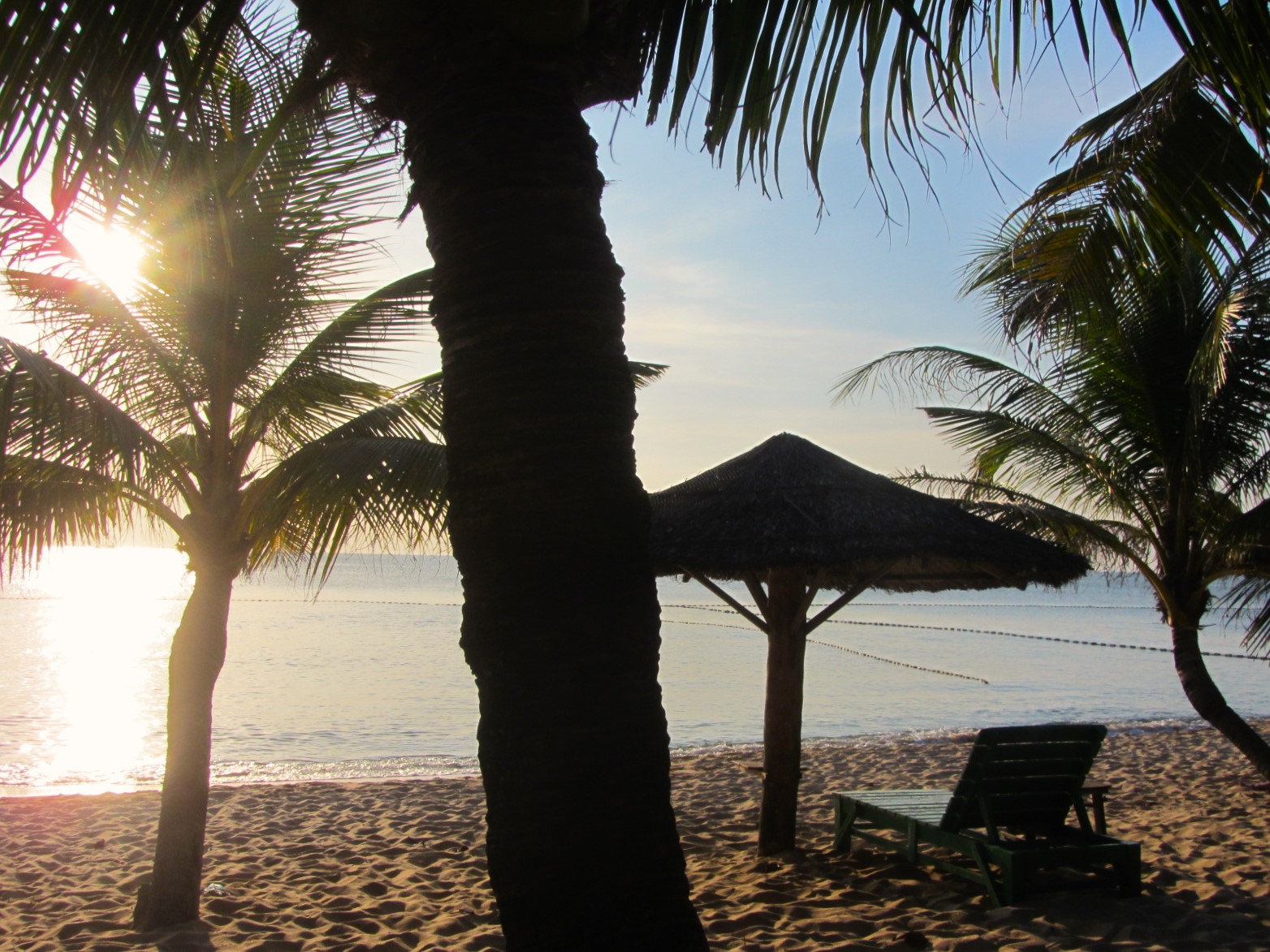
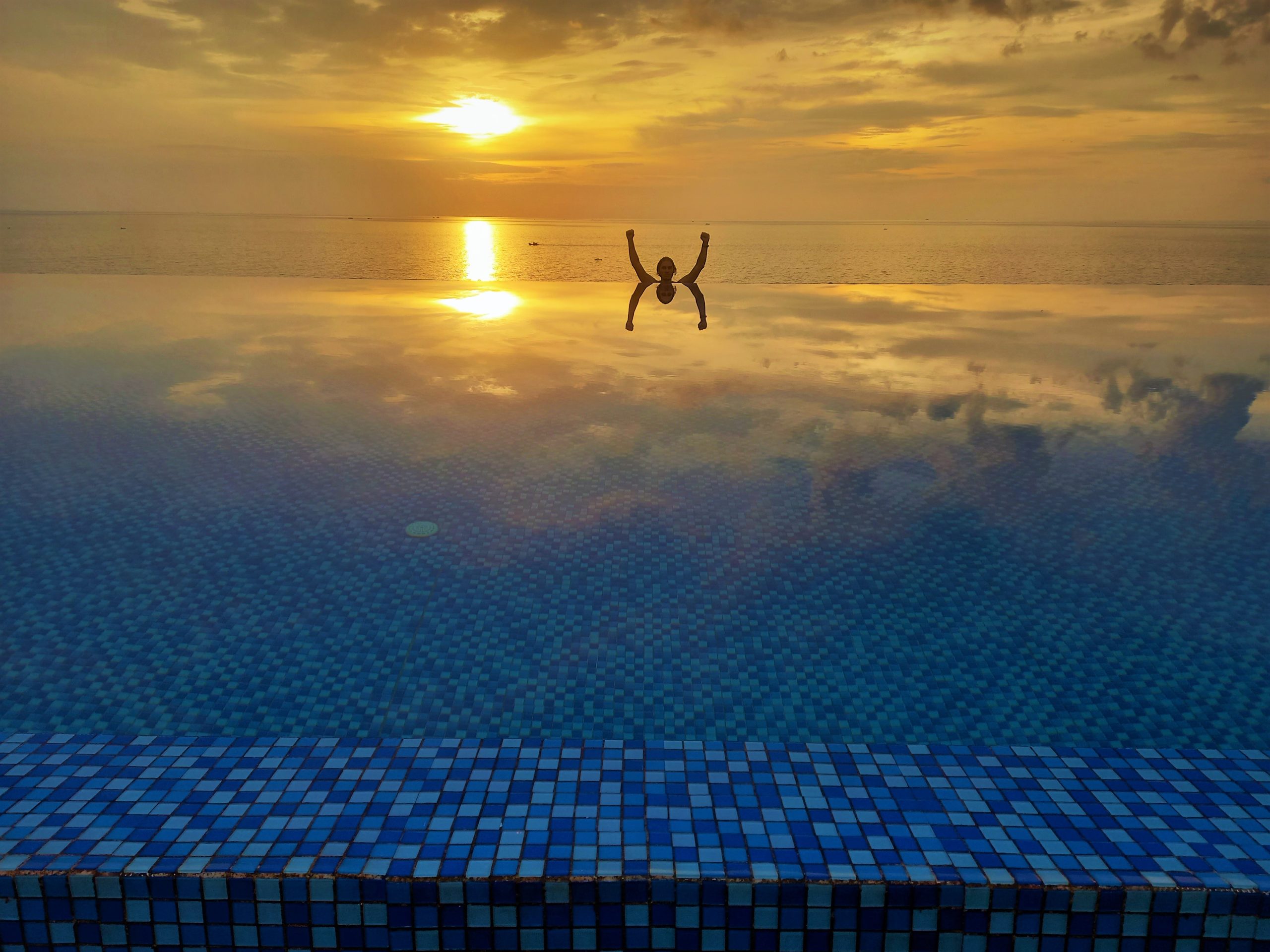
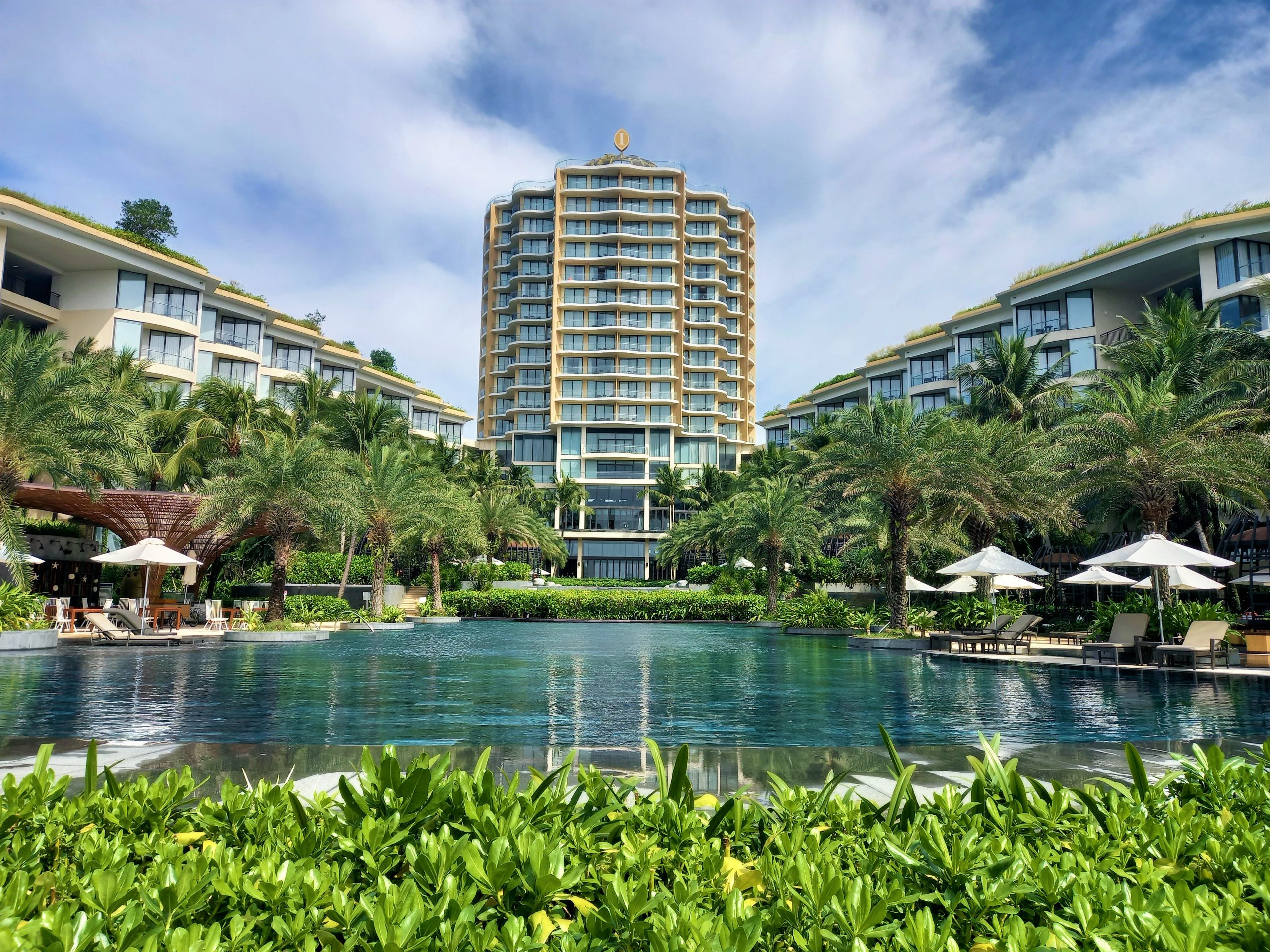
10. Thơm Beach:
[View Map]
- Location: north-east coast
- See & Do: exploring a large, empty coastline, beach-hunting, seafood restaurants, camping opportunities, small islet, local hamlets
- Where to Stay: Local Beach ($), Phu Quoc Camping ($), Luna Beach ($), wild camping
Description: Thơm Beach has a stark beauty. Silent, still, hot, sparsely populated and filled with the scent of cashew fruit and the sound of midday cicadas, there’s something beguiling about this remote northeastern coast of Phú Quốc Island. The sandy, pebbly, rocky beaches are mostly hidden from view – reached via dirt tracks off the main road – and the water is very shallow and tidal. At the northern section of Thơm Beach is a fishing hamlet consisting of just a few local shops, a couple of seafood restaurants, fishermen’s houses and a school. Local Beach is a good place for a drink or a quiet night by the sea. South of the village is the central section of Thơm Beach, characterized by charming, tranquil stretches of sand beneath tall tropical trees, many of them with informal local seafood restaurants, such as Hương Biển Quán. The southern section of Thơm Beach stretches from the tiny green islet of Hòn Một all the way down to Đá Chồng port. Hòn Một islet is worth visiting by crossing the rickety wooden bridge, and there are good beachside restaurants near here too. Phu Quoc Camping and Bãi Thơm Retreat is a lovely location for a meal and a swim or a night under the stars. Overall, Thơm Beach is a quiet, undeveloped coast perfect to exploration, but sometimes litter can be an issue.
Photos of Thơm Beach:
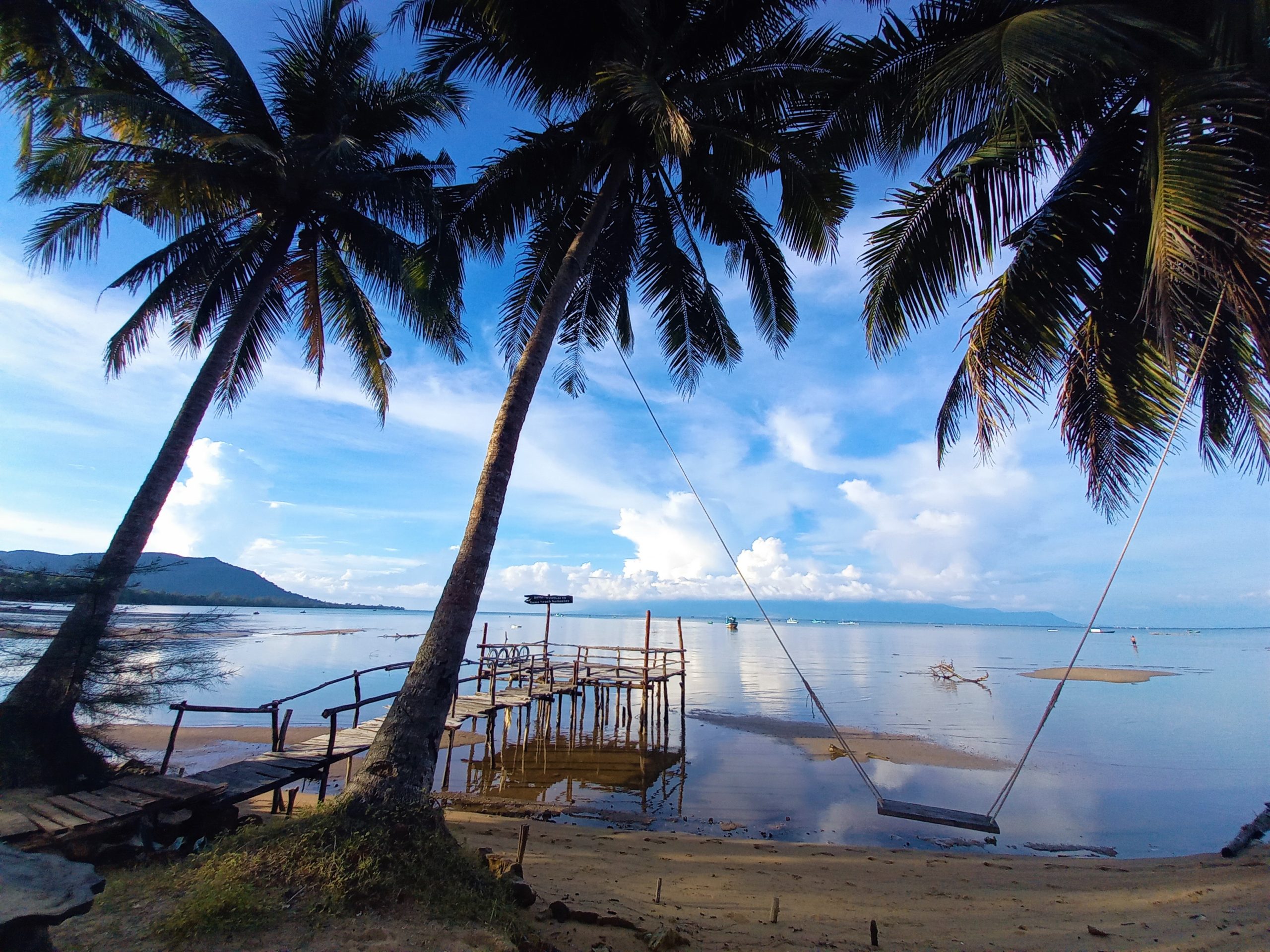
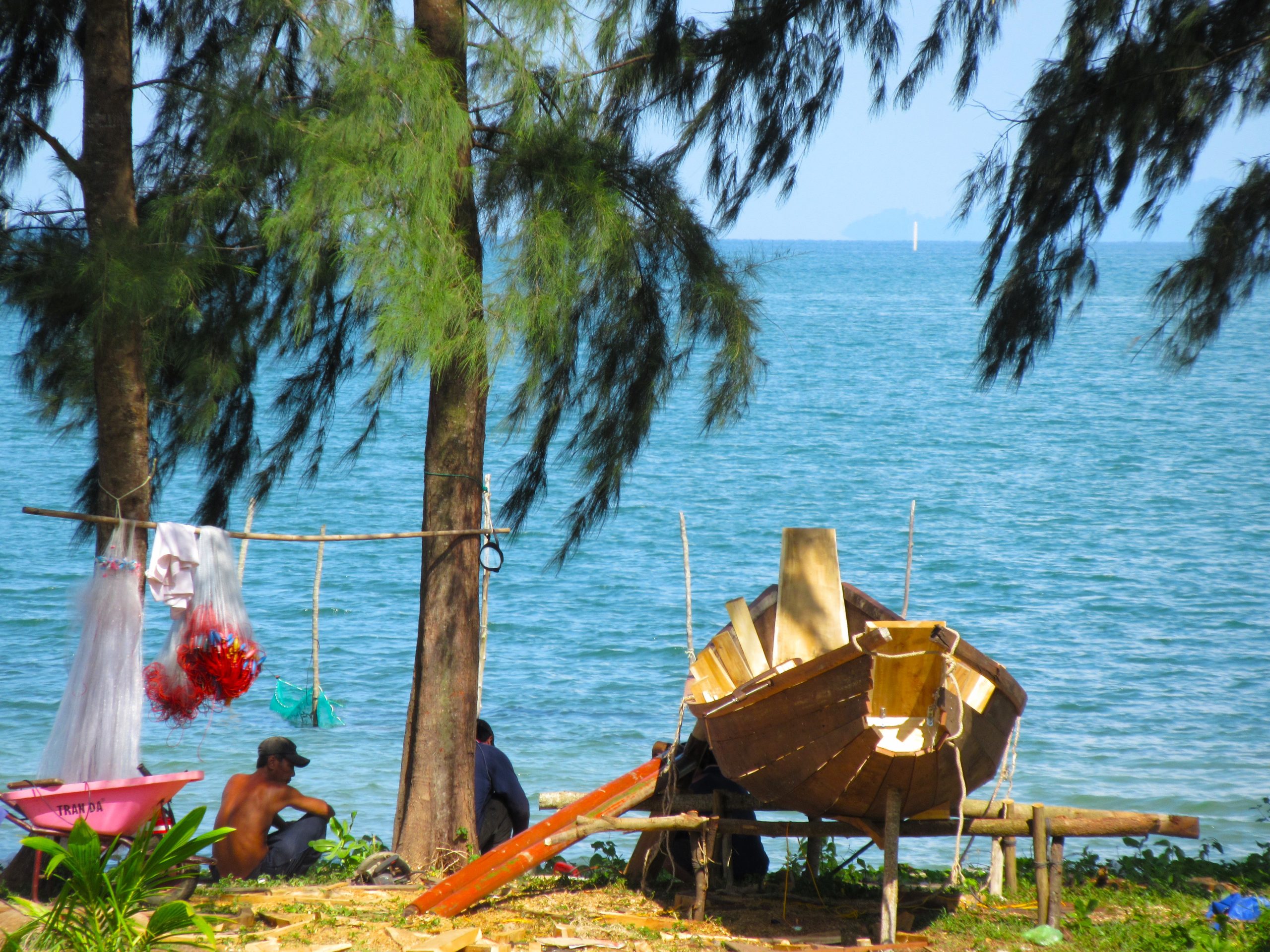
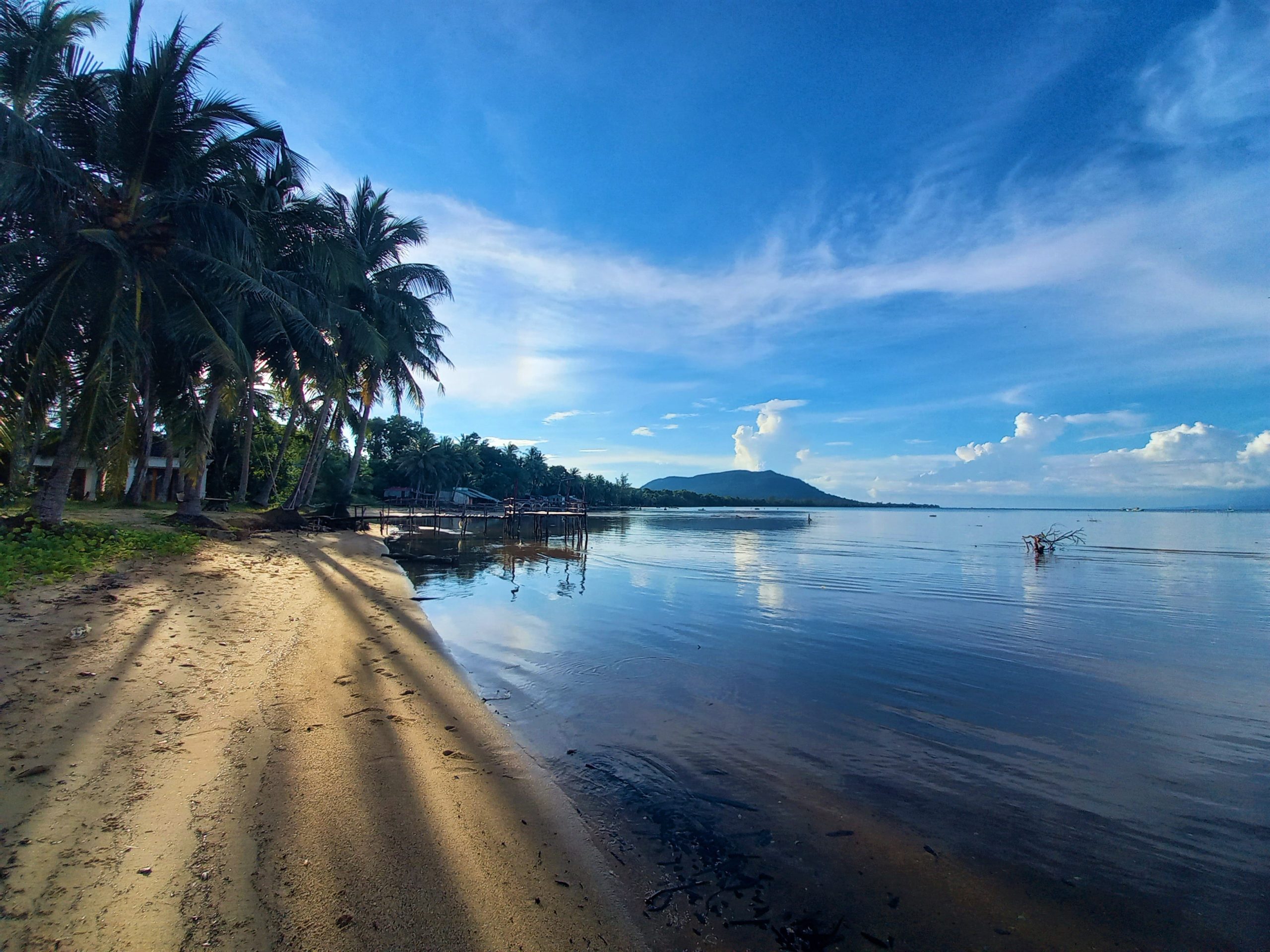
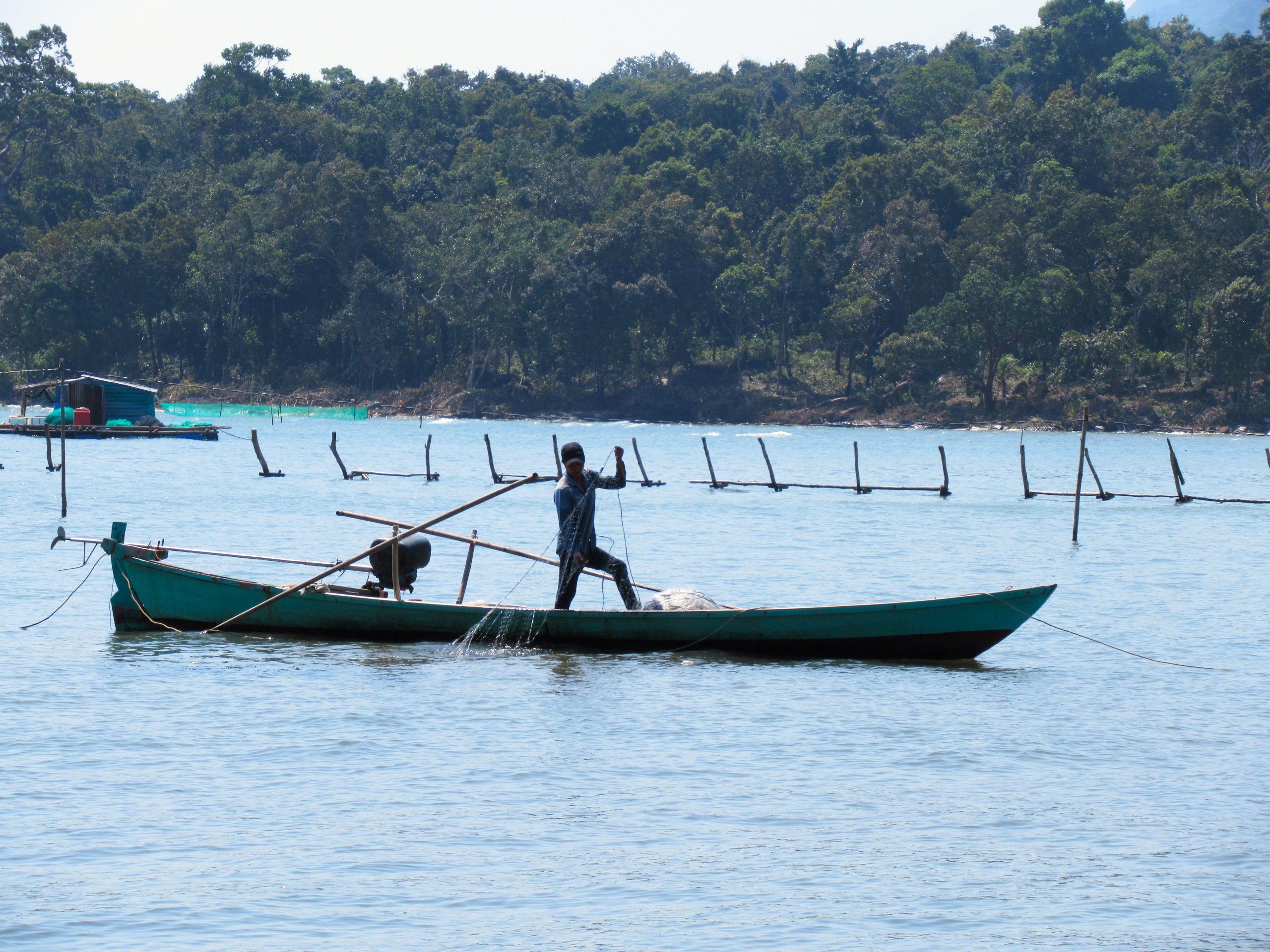
11. Sao (Star) Beach:
[View Map]
- Location: south-east coast
- See & Do: good white-sand beach, seafood restaurants, watersports, cafes, beach bars
- Where to Stay: My Lan Guest House ($), DAD Resort ($), Xuân Hiền Resort ($)
Description: Sao Beach, with its leaning coconut palms, snow-white sand and distinctive butane-blue water, is one of the most popular and striking beaches on the island. Once touted (optimistically) as the ‘Best Beach in Vietnam’, Sao is still a very attractive stretch of sand to walk along and swim. By far the most beautiful part of the beach is at the northern end, where the excellent Paradiso Restaurant & Bar has a wonderful breezy terrace beneath tall palms and loungers on the sand. But, sadly, for the rest of the beach, the writing has been on the wall for several years, and there are many reasons for this. Its increasing popularity has led to haphazard, temporary construction of small resorts, bars, cafés and restaurants; trash has built up – squeezed into the narrow freshwater creeks that feed onto the beach and into the sea; and jet skis fill the water with gasoline, break the silence and pollute the air. Today, I personally find Sao Beach quite a sad place and a sad sight. Even though the dirt road to the beach has finally been paved and people still flock to Sao by the thousands each day, it’s a shadow of its former self. And it’s no surprise that massive resort development – which was always inevitable and surely part of the reason why the temporary structures were of such low quality – is now on the way. It’s going to take a lot of work to reinvigorate Sao Beach for the future. (There’s another beach just to the south of Sao, called Bãi Giữa, hidden down a paved lane, which is worth a visit, although trash is a problem.)
There are a couple of places to stay right on Sao Beach, including My Lan which offers simple, clean but soulless rooms. Better accommodation is found inland on the road leading to the beach, such as DAD Resort and Xuân Hiền, which are both good, small, modern resorts with swimming pools.
Photos of Sao Beach:
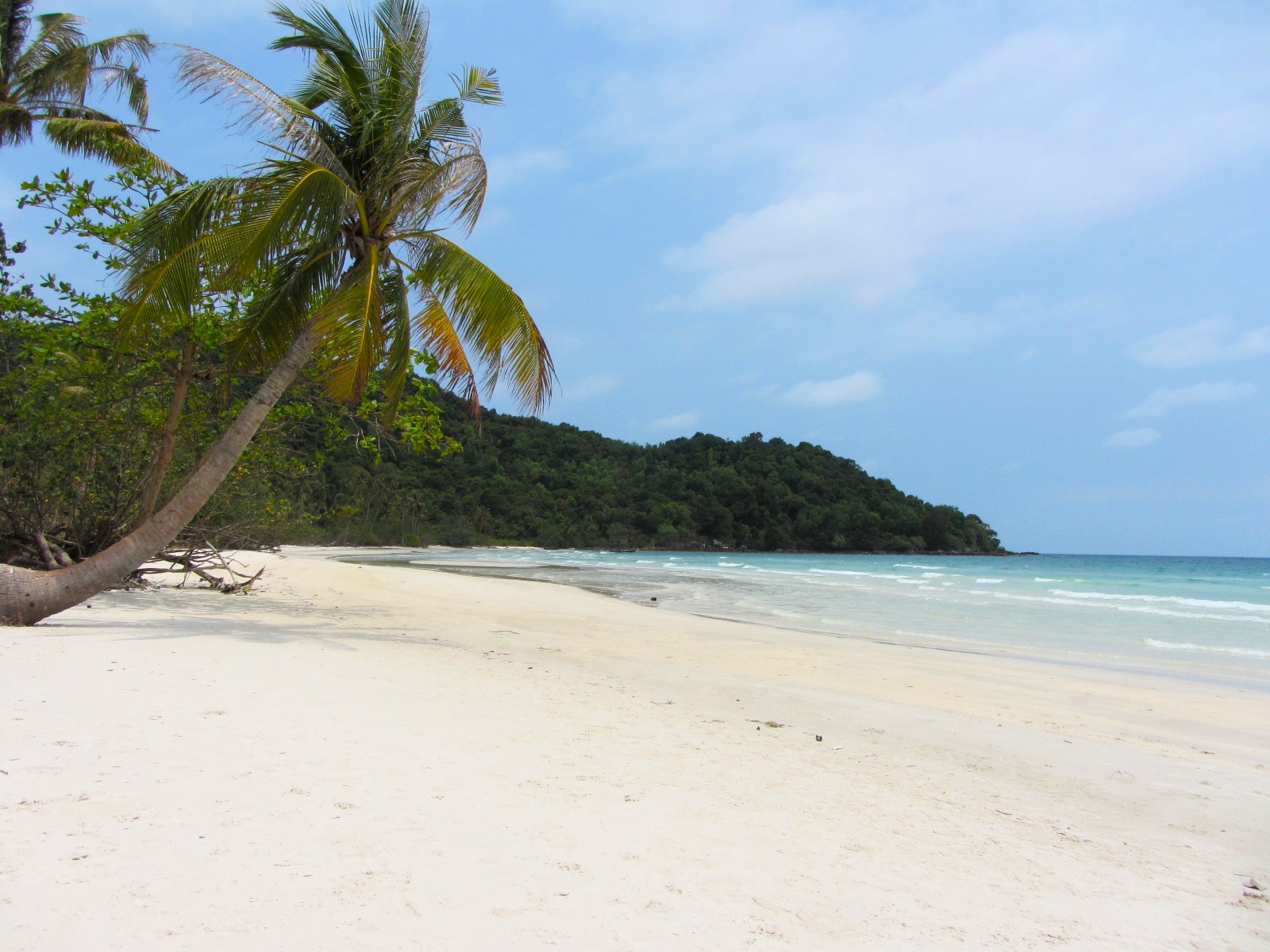


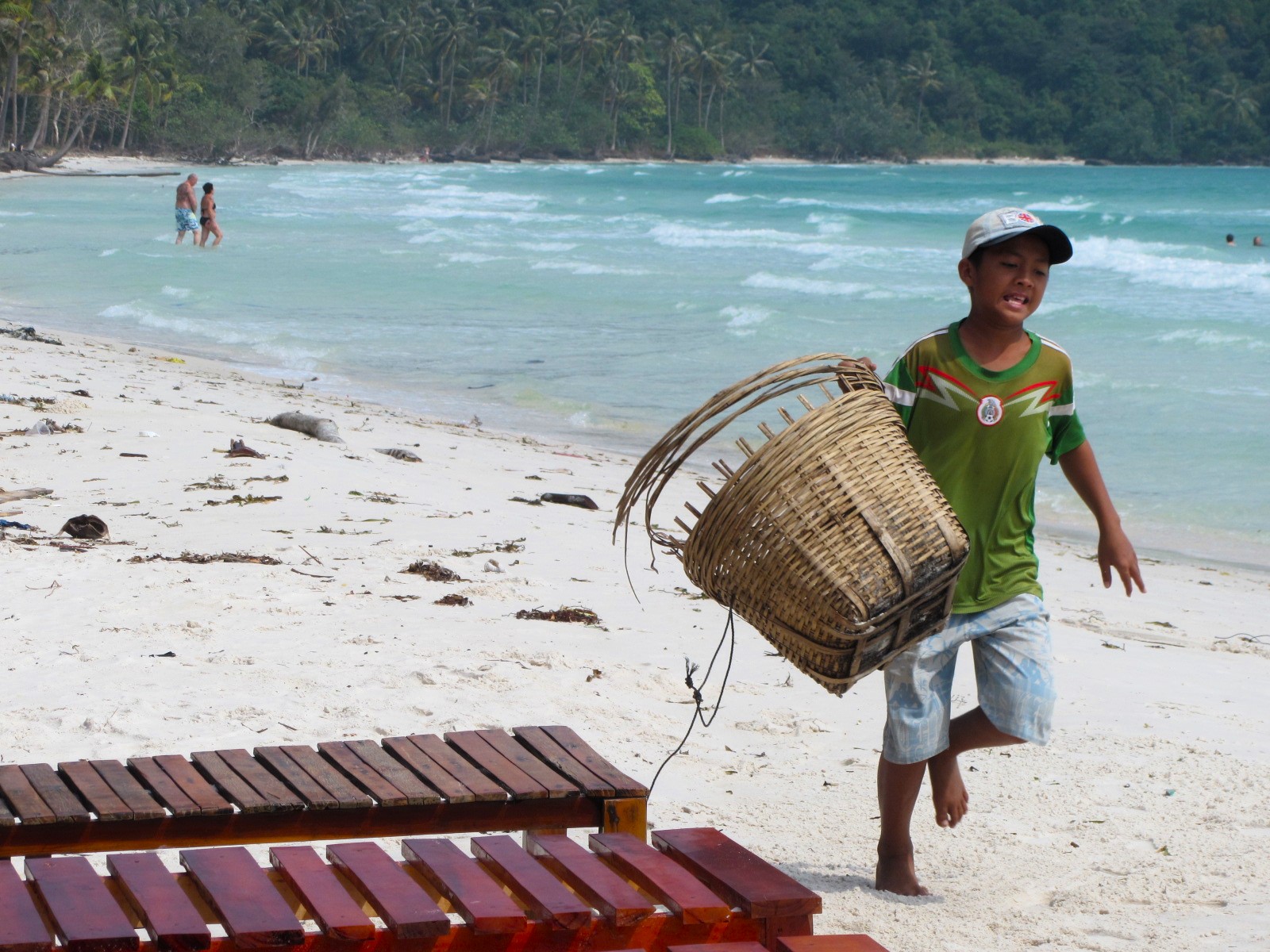
12. Bãi Bổn Beach:
[View Map]
- Location: north-east coast
- See & Do: quiet, serene, green area, scenic drive, local hamlet, remote port, beach-hunting opportunities
- Where to Stay: Hideaway Beach Glamping ($$), Mũi Dinh Resort ($)
Description: Bãi Bổn is the name of a small, sleepy hamlet on the lovely East Coast Road. North of the hamlet all the way to Đá Chồng port is a long stretch of coast with hardly any development on it whatsoever. The sea can be reached via narrow sandy lanes leading through tropical foliage to the beach. The water is very shallow and, although there are some sections of sand, much of the coastline is pebbly. Take your time and explore until you find a good spot. There’s something calm, serene and charming about the coast here, especially with the sea breeze rustling the palms, eucalyptus and mango trees, the silhouettes of the Cambodian mainland on the horizon, and the thick jungles of Phú Quốc National Park in the background. So far, there are only a couple of places to stay, the best of which is Hideaway Beach Glamping, with safari-style tents on a shady beach. A short detour to Đá Chồng port is worthwhile to see the eerie passenger terminal for the ferry to Cambodia, which has long since ceased to operate, and the small fishing fleet. In Bãi Bổn hamlet you’ll find a couple of stores and street food vendors, but there’s nothing much else around: this is one of the most tranquil parts of the entire island.
Photos of Bãi Bổn Beach:
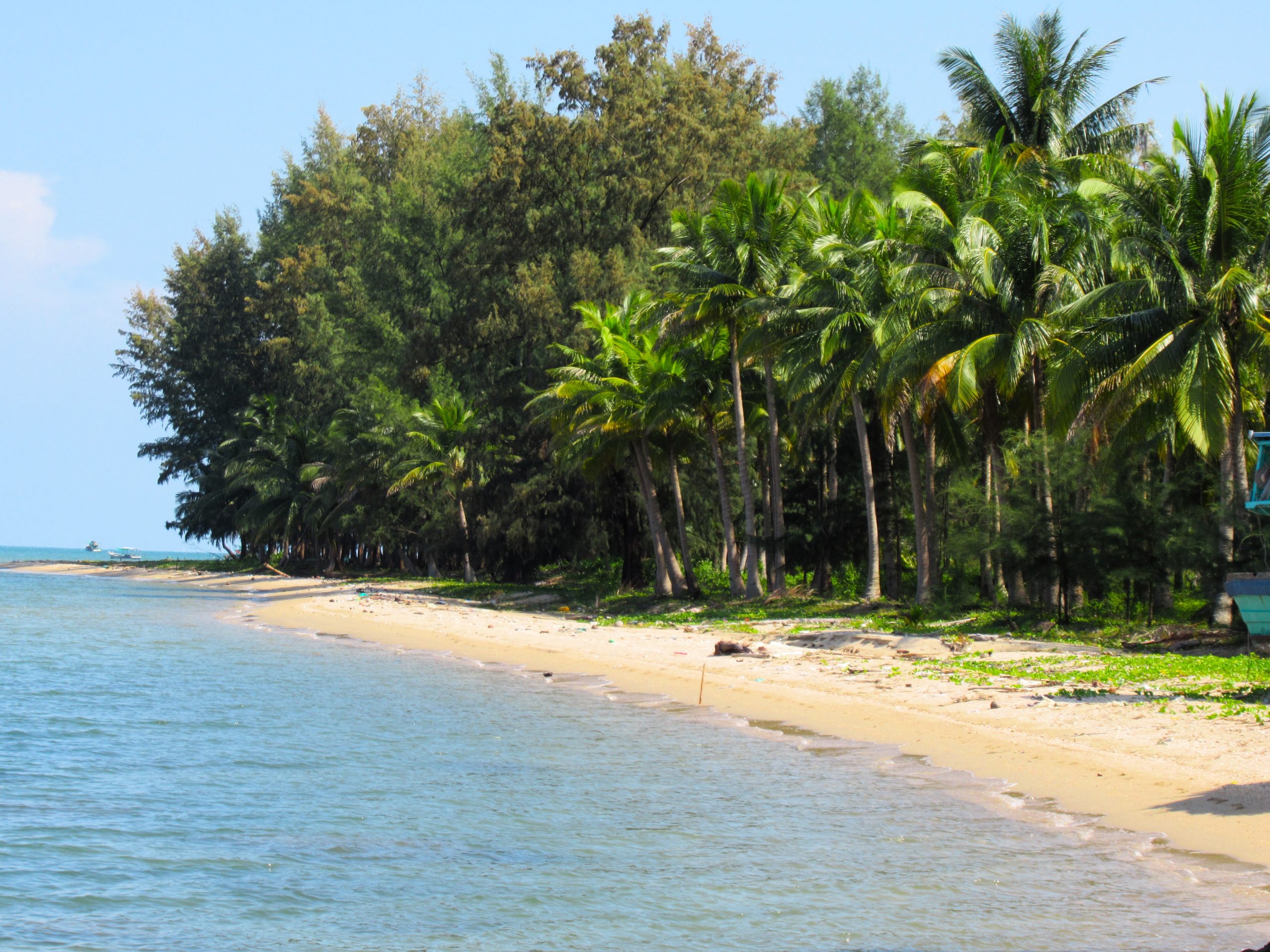


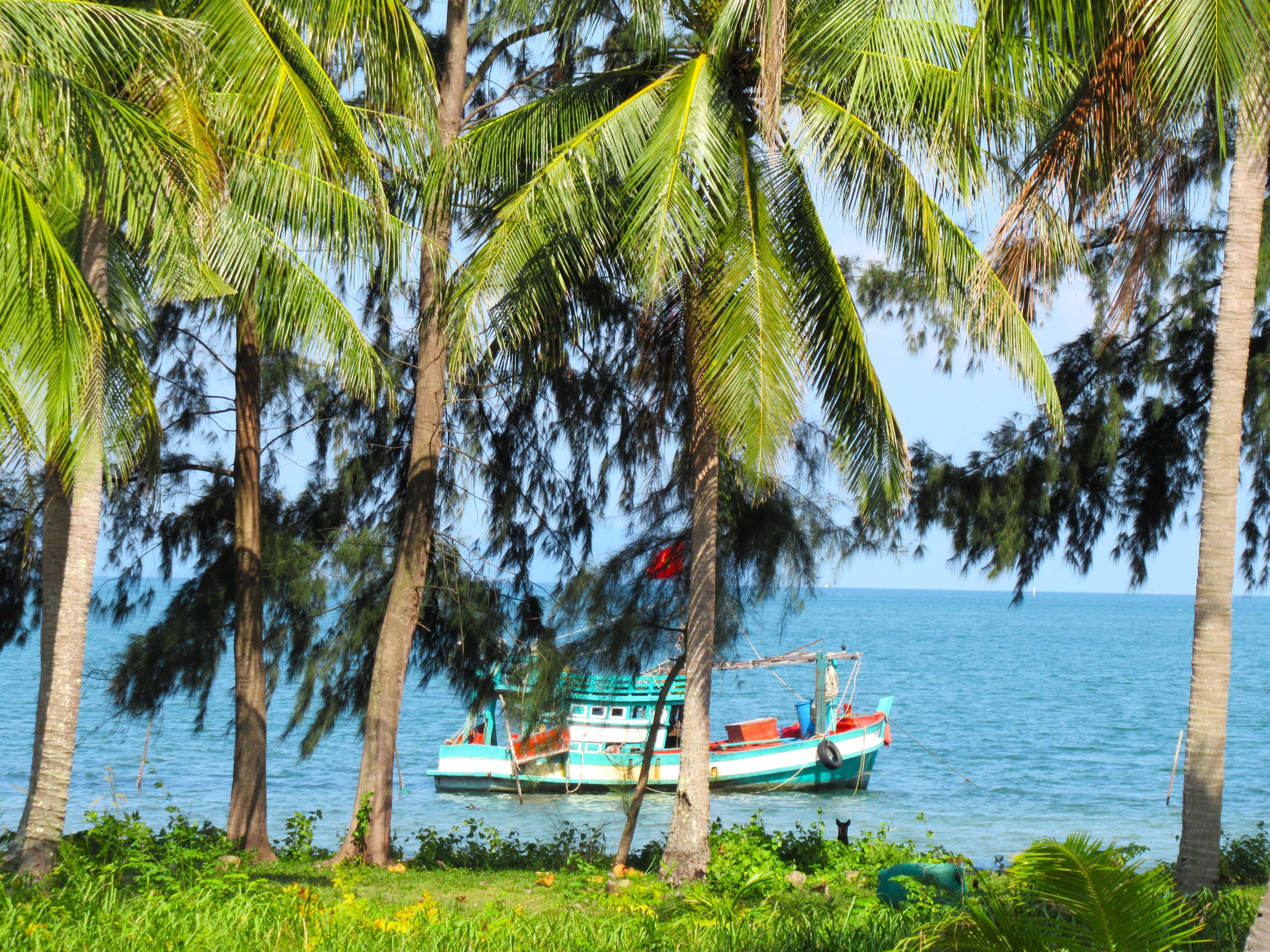
13. Khem & Ông Đội Beach:
[View Map]
- Location: south-east coast
- See & Do: scenic drive, massive luxury resort complexes, beach bars, seafood restaurants, good beach
- Where to Stay: Premier Village ($$$), JW Marriott ($$$), JM Boutique Hotel ($$)
Description: At some time, in between restricted access due to military control and the development of the absurd luxury resort JW Marriott Emerald Bay, there was a brief period – probably less than a year – when the snow-white sands of Khem Beach were quiet, clean and undeveloped. But that time has long since gone. The central and southern portions of the bay are taken up entirely by luxury resorts and residences, although it is still possible for non-guests to drink and dine at some of the beachfront restaurants and bars, such as Istanbul Beach Club, among many others. There are also watersports and beach activities available to the public. There’s a tiny slither of beach at the northern end that still maintains a local feel, where there’s a decent Vietnamese seafood restaurant on the sand. Other than that, these days Khem Beach is a beautiful but overdeveloped arc of sand that can get crowded with visitors during the high season. Branching south of the beach, a paved lane leads along a steep and jungled hillside by the sea, all the way to Ông Đội Cape. It’s a beautiful little ride but dead-ends at the entrance to the upscale property Premier Village. This luxurious resort consists of white villas built on stilts over the rocky bay and sandy coves of the entire cape. It’s a luxurious and secluded place to stay, especially with a group, if you can afford it. Just west of Ông Đội Cape is Cây Dừa Beach, which looks enticing but is off limits due to a naval base.
Photos of Khem & Ông Đội Beach:

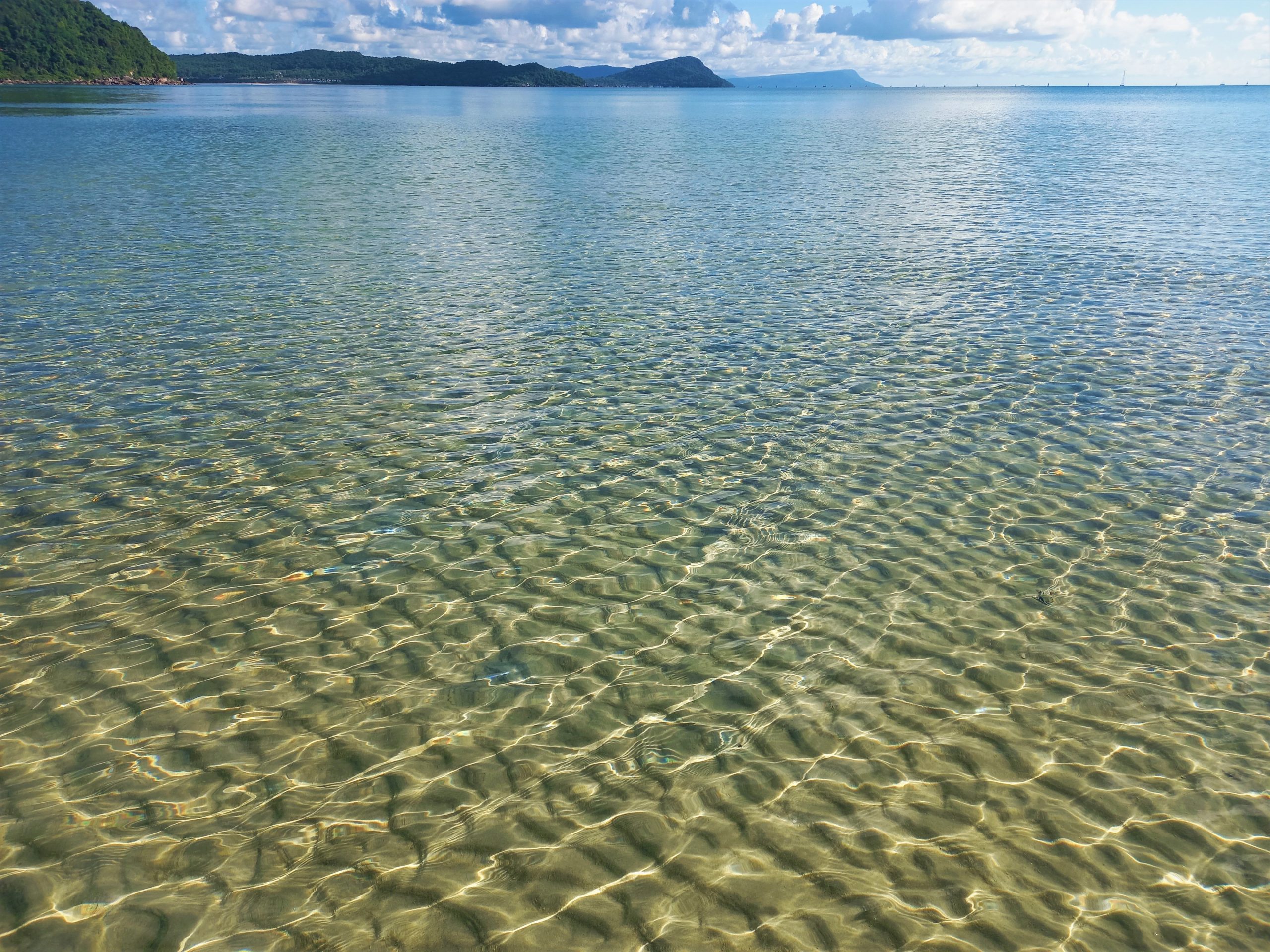
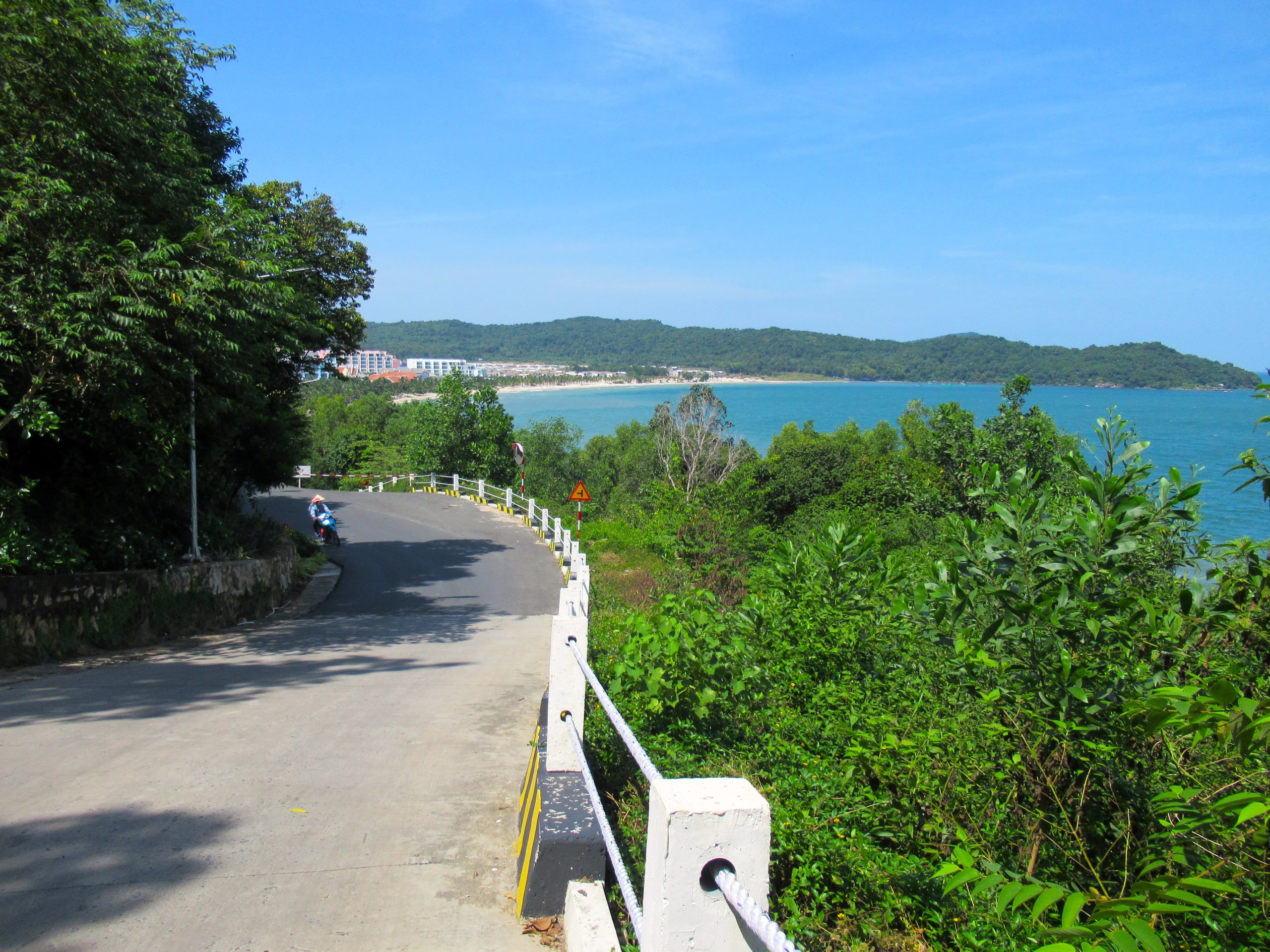

14. Đất Đỏ Beach:
[View Map]
- Location: south-west coast
- See & Do: excellent beachside local seafood restaurants, fish sauce factory, fishing scenes, decent beach
- Where to Stay: none
Description: Accessed via a bumpy dirt road from the south or the north, Đất Đỏ Beach is a pretty bay bookended by two small headlands that frame an attractive stretch of sand and calm waters in the south-west of the island. The bay is nice enough (although the surroundings are quite scruffy) and there are a handful of very good local seafood restaurants (try Quán Ngọc Đông) right on the sand at the northern end of the beach. The swimming is pretty good if you want to work up an appetite before a seafood feast. But the beach’s primary focus is the production of cá cơm khô – dried anchovies – which are laid out to dry in their hundreds of thousands on wooden trestles on the sloping beach to be used in the production of the island’s famous fish sauce. It’s quite a sight. There’s no development on Đất Đỏ Beach yet: it is still a working beach, rather than a leisure beach. At the moment, there’s no accommodation here, but there’s lots of rooms to the south at the gigantic, hideous Sun Group resort-theme park-cable car monstrosity.
Photos of Đất Đỏ Beach:
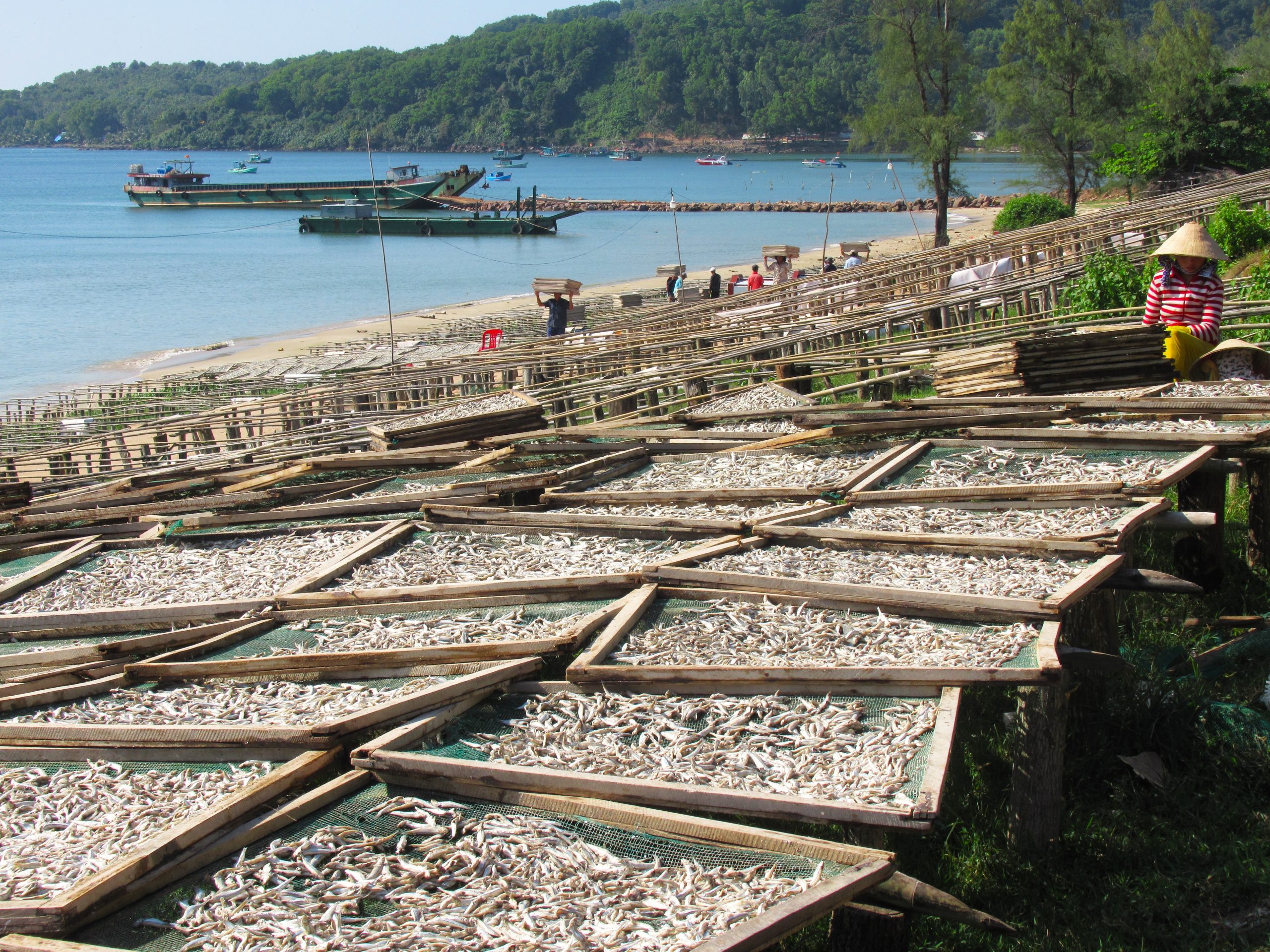
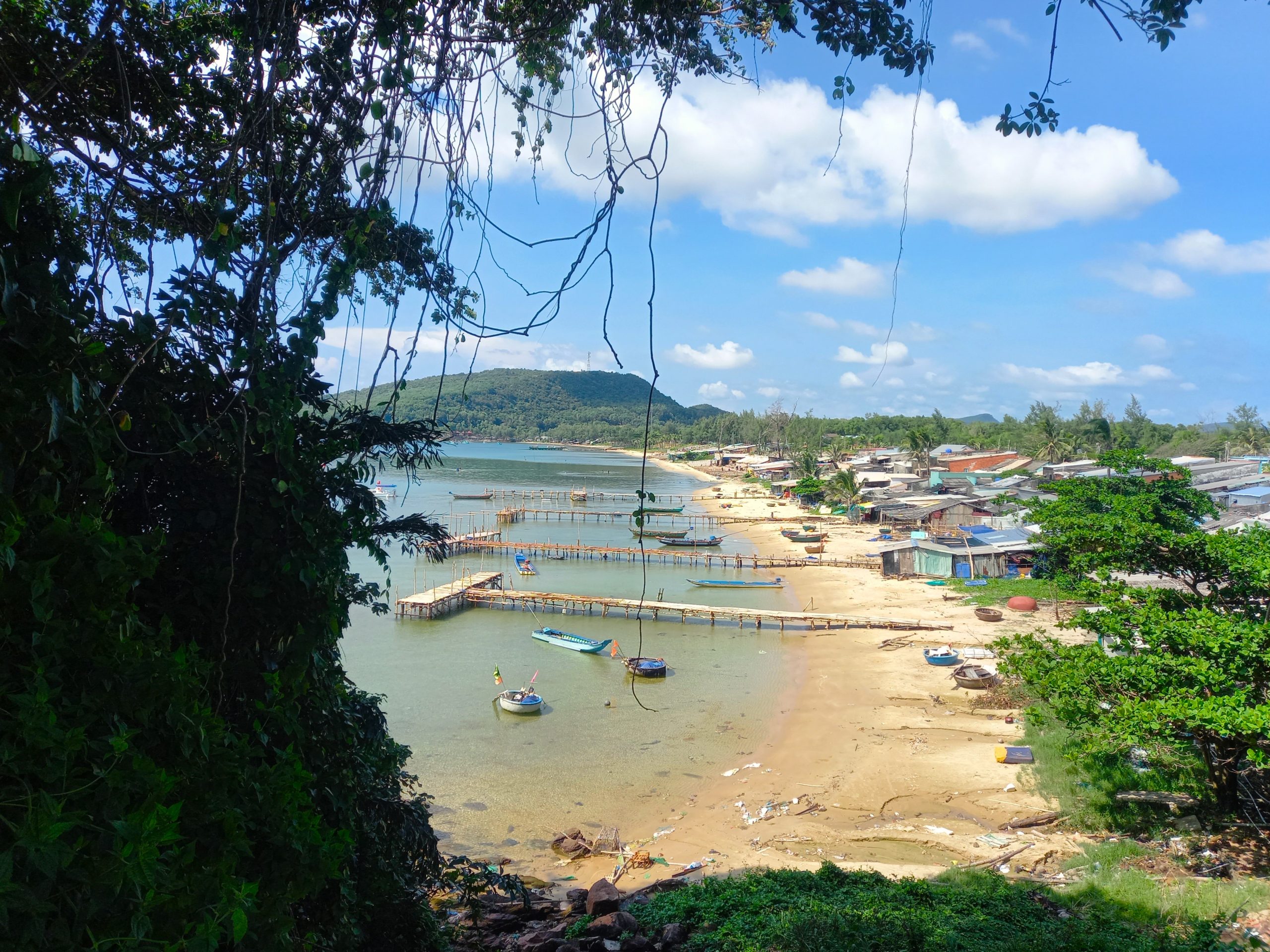
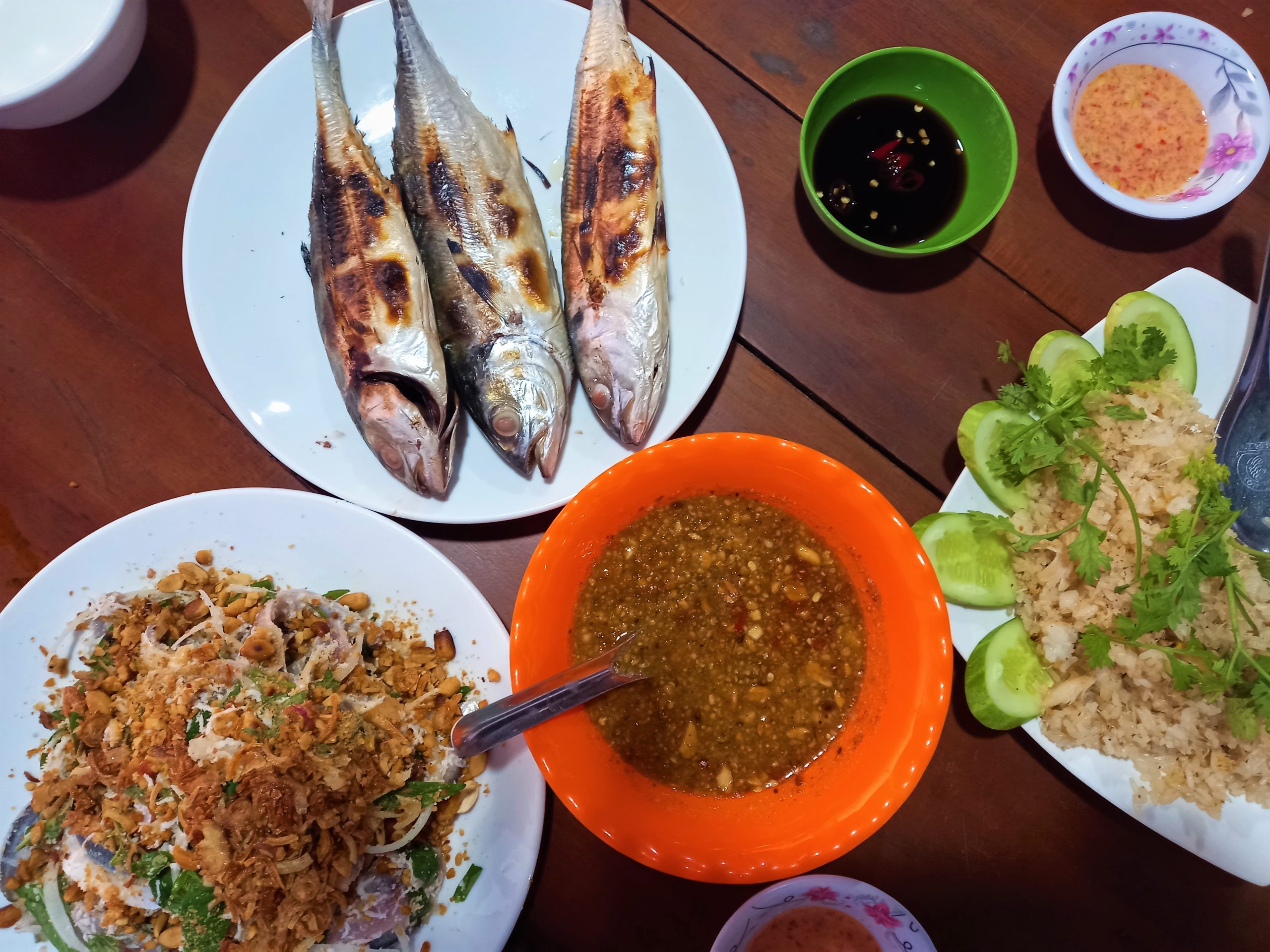
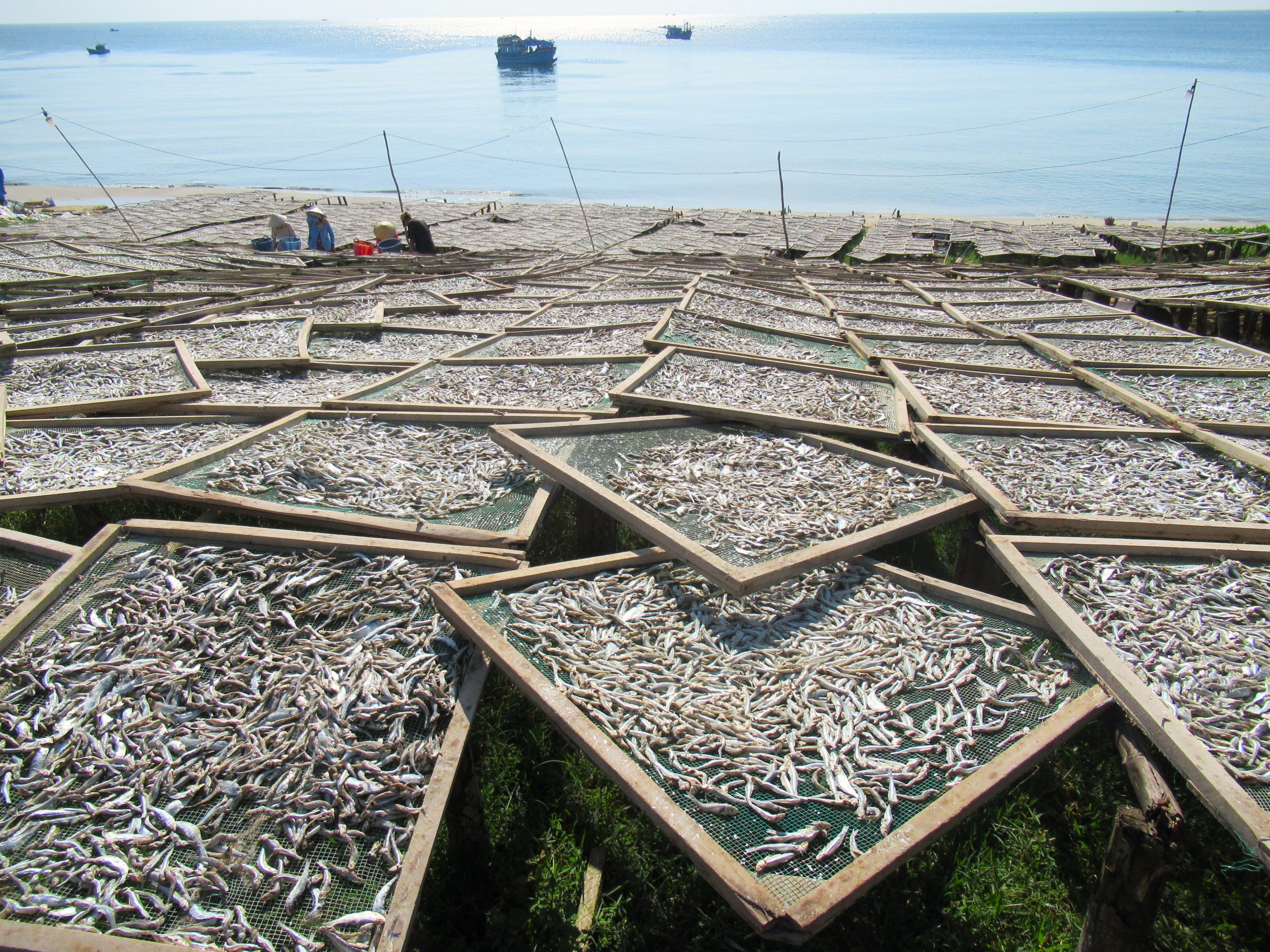
15. Dài Beach:
[View Map]
- Location: north-west coast
- See & Do: good beach, waterpark, safari, aquarium, golf, casino, shopping malls, big resorts
- Where to Stay: Melia ($$$), Sheraton ($$$), Vinpearl ($$$), Radisson ($$$), Crowne Plaza ($$$)
Description: This long stretch of fine sand beach with turquoise water used to be one of my favourite beaches in Vietnam. Just a few of years ago, Dài Beach was completely undeveloped, save for a handful of seafood shacks dotted on the grass beneath the shade of large tropical trees. However, that changed dramatically when Vingroup moved in (as they always do) to build a mega-resort complex, including theme parks, aquariums, safaris, waterparks, casinos, golf courses, enormous hotels, and rows upon rows of luxurious faux-Roman villas. Collectively known as Vinpearl, this development now sprawls along the entirety of Dài Beach. To make way for this, thousands of old-growth tropical trees were cut down. Today, Dài Beach is a entertainment complex which many visitors enjoy, but it’s not my thing. If you’re staying at one of the many big hotels here, the swimming is still fine and the bay is still quite beautiful.
Photos of Dài Beach:
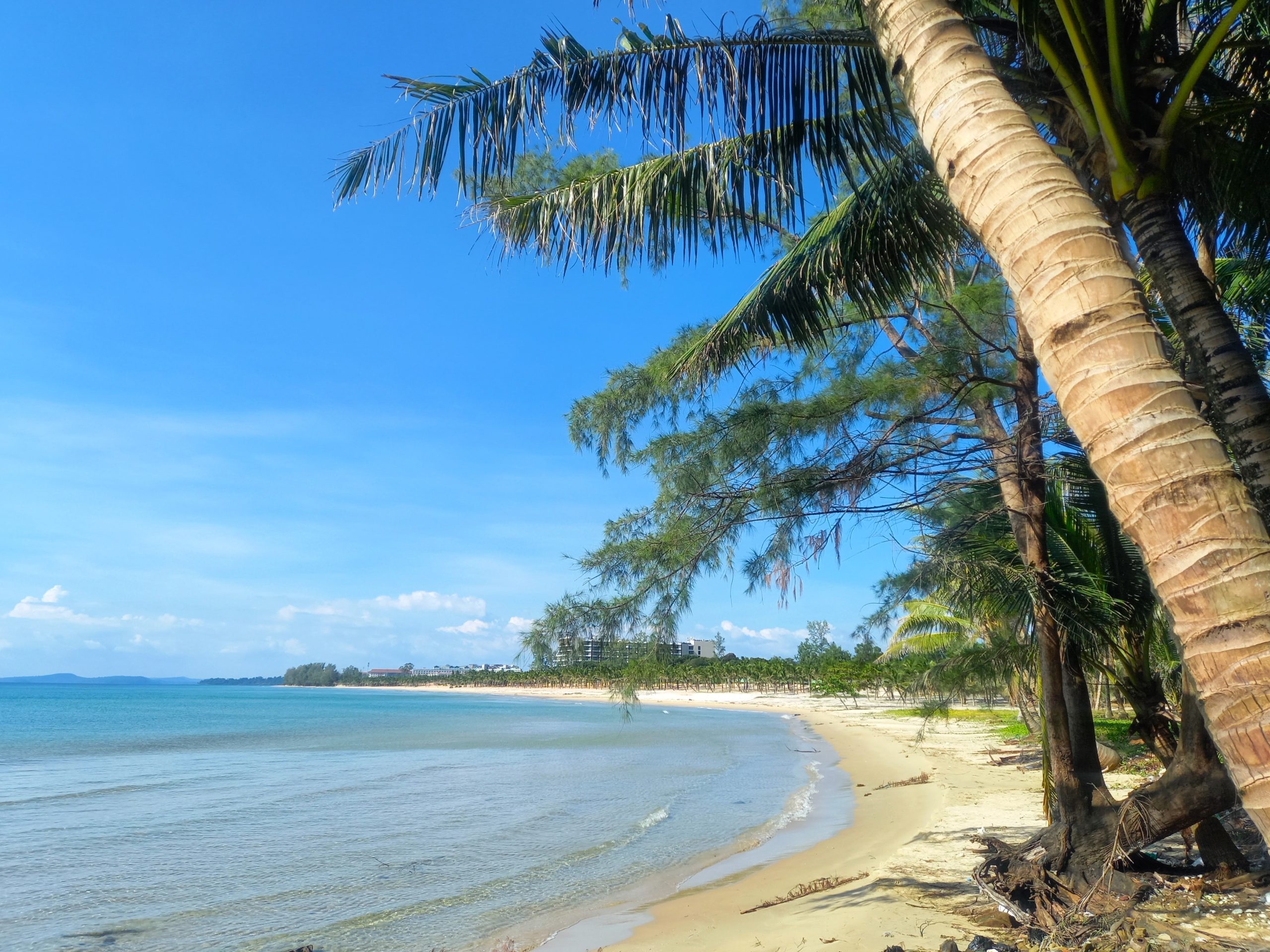


16. Dăm (Pagoda) Beach:
[View Map]
- Location: south-east coast
- See & Do: large & ornate pagoda complex, scenic drive, decent beach, wild honey farm, vegetarian restaurant
- Where to Stay: small resorts
Description: Accessed via a scenic, concrete road curling along the south-east coast, Bãi Dăm is a wide, mostly rocky bay, where dense jungle meets the sea from the hills behind. I’ve given it the name ‘Pagoda Bay’ because of its most famous attraction, the recently completed Hộ Quốc Temple, with its colossal sculpture of Quan Âm (the Goddess of Mercy) presiding over the pagoda complex and looking out to sea. The pagoda itself is impressive, serene, and very attractive, with lots of shrines, long staircases and sculptures of deities from the Buddhist pantheon. Its position looks out over the bay, across the dark blue sea and down to Vịnh Đầm port, just to the south. Visit in the afternoon (about 4pm-5pm) for the low light and a beautiful cool, scented breeze off the forested hills. The Trúc Lâm vegetarian restaurant is fine for lunch. Beyond the pagoda, where the road ends, it’s possible to find a couple of quiet, secluded spots for a waterside chill and a swim, although trash is a problem. At the southern end of the bay, near the main road, there’s another little shrine called Miếu Hoàng Tử and a wild honey farm and shop. There’s no accommodation on the bay itself, but there are a few decent small resorts at the beginning of the entrance road.
Photos of Dăm (Pagoda) Beach:
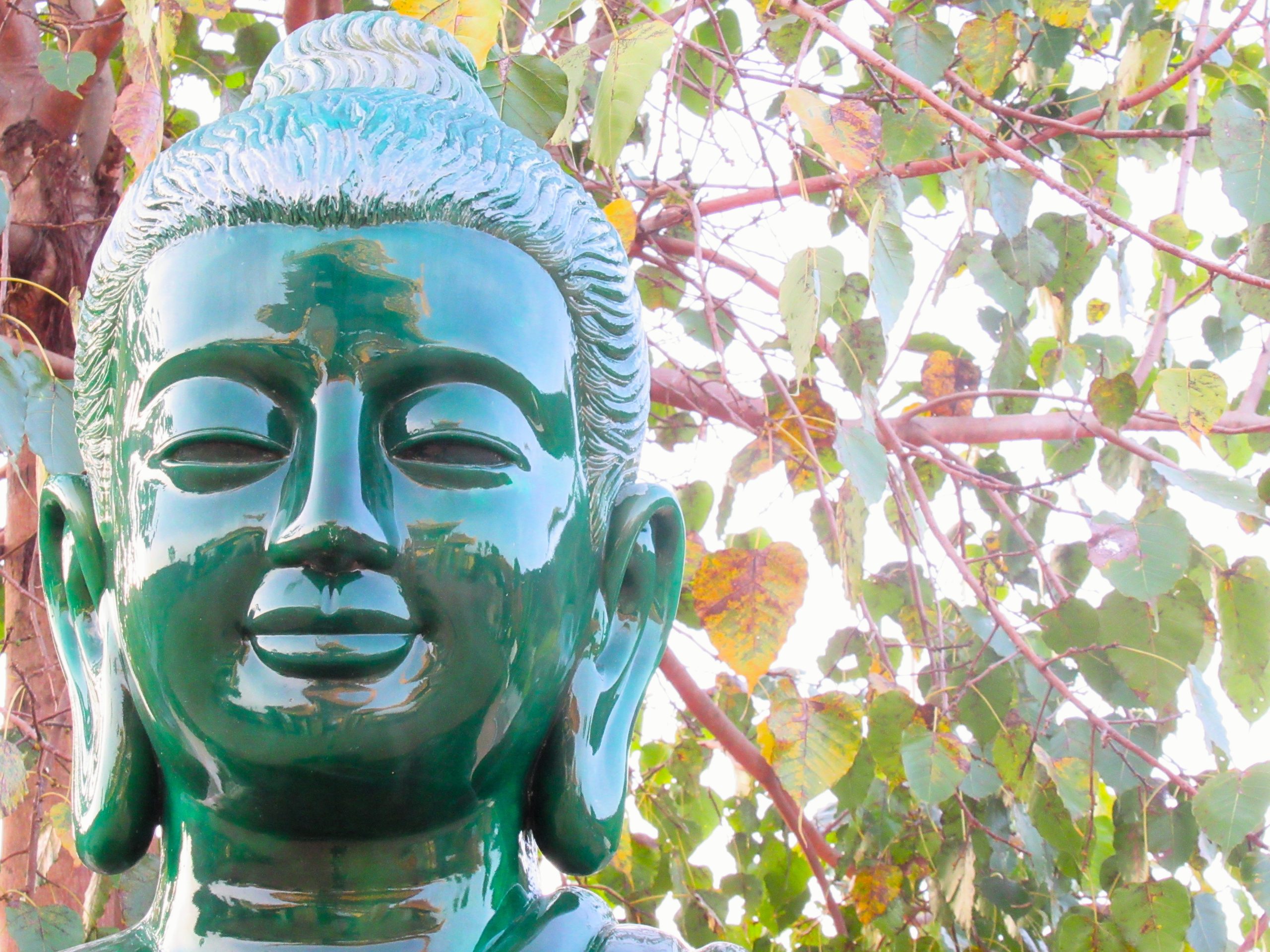
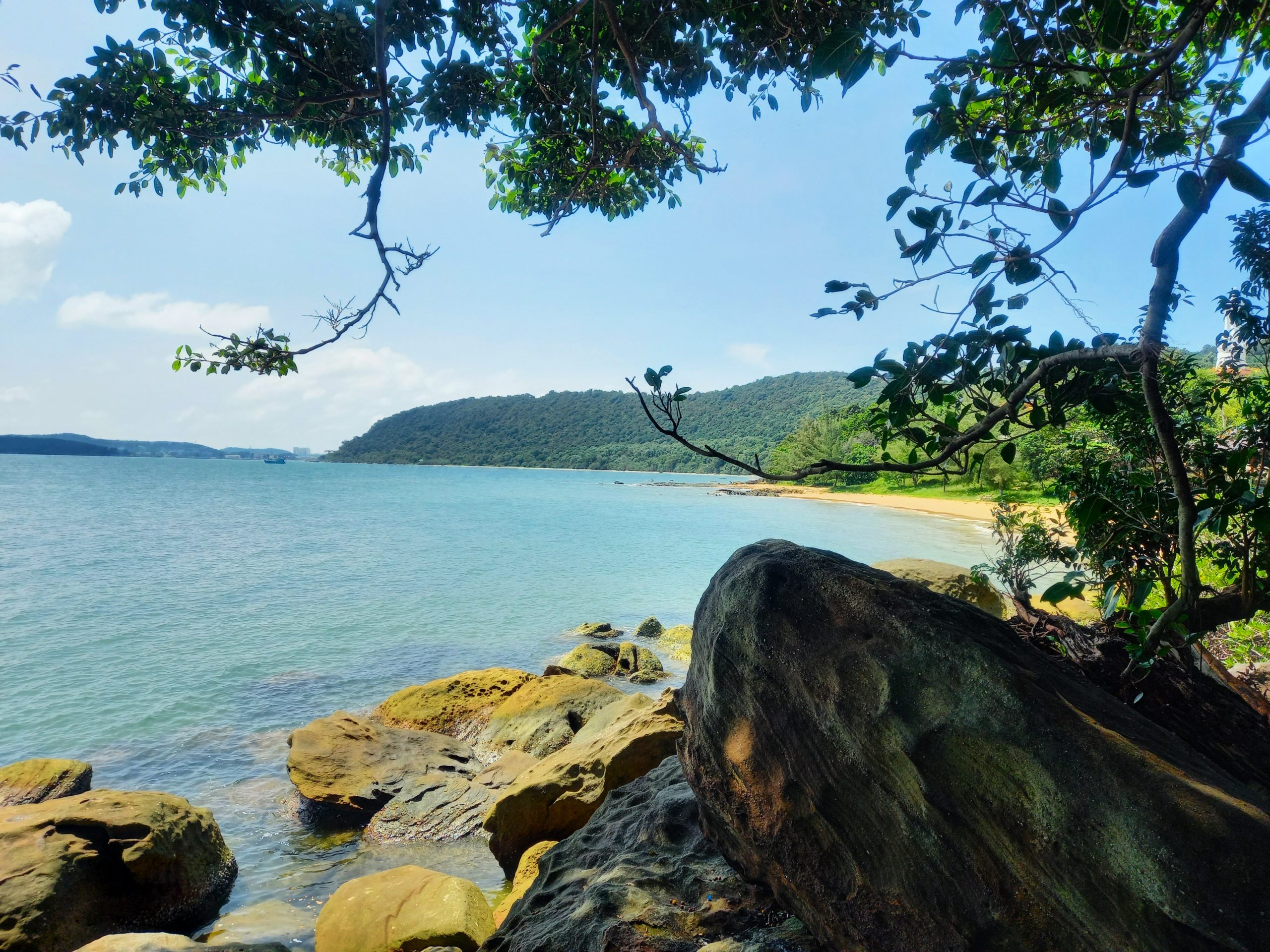

17. Dương Đông Beach:
[View Map]
- Location: west coast
- See & Do: local market, night market, small beach, fishing fleet, seafood restaurants, street food, local life, temples
- Where to Stay: Seashells ($$), Chill House ($), Nipola ($), local guesthouses & hotels ($)
Description: Right in the middle of the west coast, Dương Đông is a sprawling, bustling town of the sort you’d expect to find on the mainland. A massive increase in population, fueled partly by the tourism boom and partly by domestic migrants arriving from other provinces as far afield as the north, Dương Đông is a busy, frenetic place, filled with street food (don’t miss bún kèn and bún quậy, both are island specialities), beeping traffic and busy people. The main market is fascinating, as is the river which winds through town, its black waters clogged with fishing vessels and cargo barges. At its mouth is Dương Đông harbour, where a fleet of wooden tour boats lie at anchor and a slender new pier for cruise ships reaches out to sea. Riding a motorbike along the old airport runway is a lot of fun. There’s a small beach to the south of Dinh Cậu temple, a shrine to the sea goddess atop a rocky outcrop at the harbour’s entrance. Bathing here is quite nice but trash from the fishing fleet can be a problem. A sleek new hotel, Seashells, occupies a prime position overlooking the harbour and ocean. For much cheaper accommodation, there are dozens of local guest houses and mini-hotels in town, such as Nipola. Just north of the harbour are several small budget accommodations on the seafront, such as Chill House. The popular night market (chợ đêm) is a bit too touristy for my tastes, but it’s a good place to sample some seafood. Also near the night market, is Phú Quốc’s ornate Cao Đài temple.
Photos of Dương Đông Harbour:
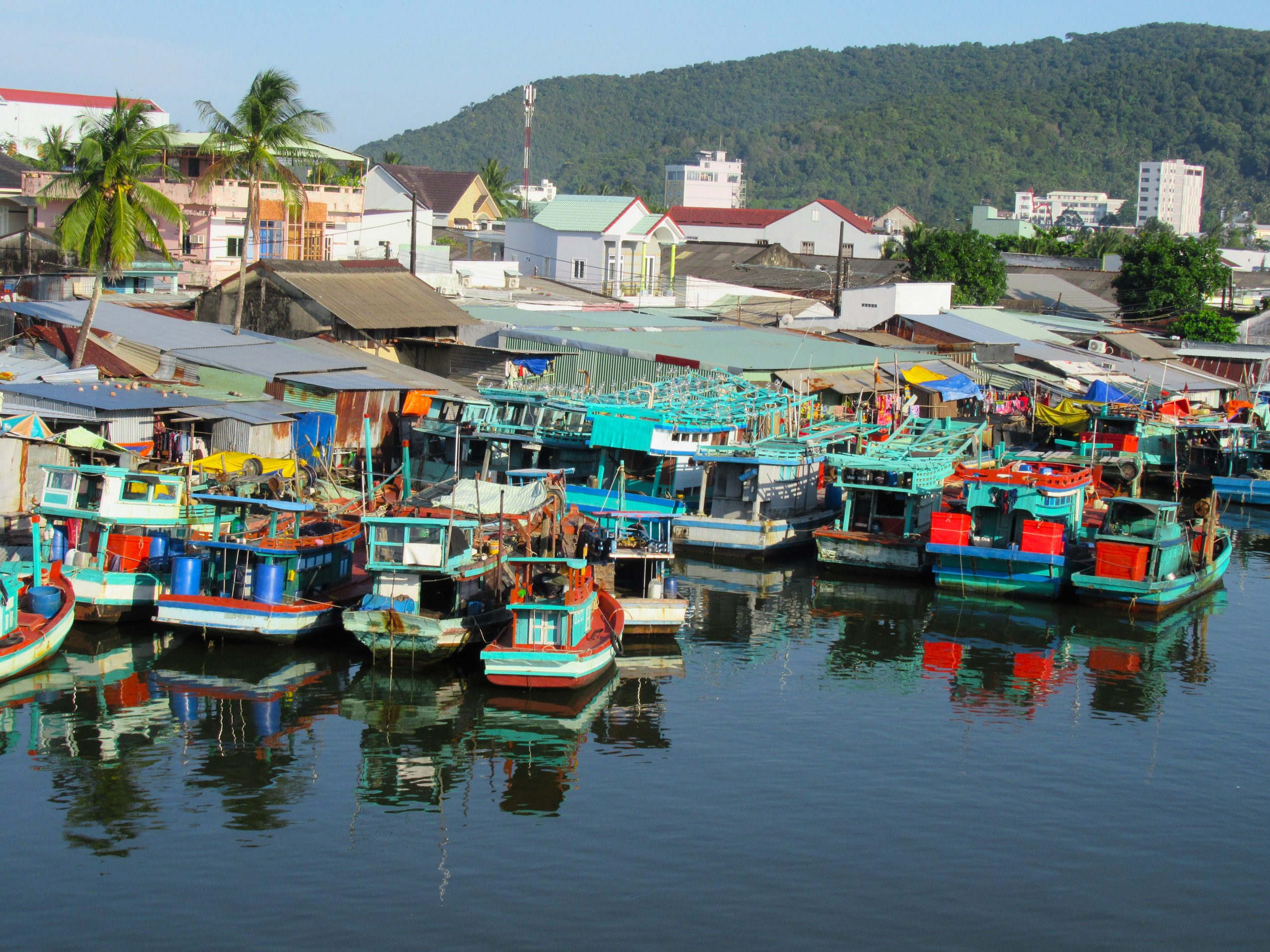
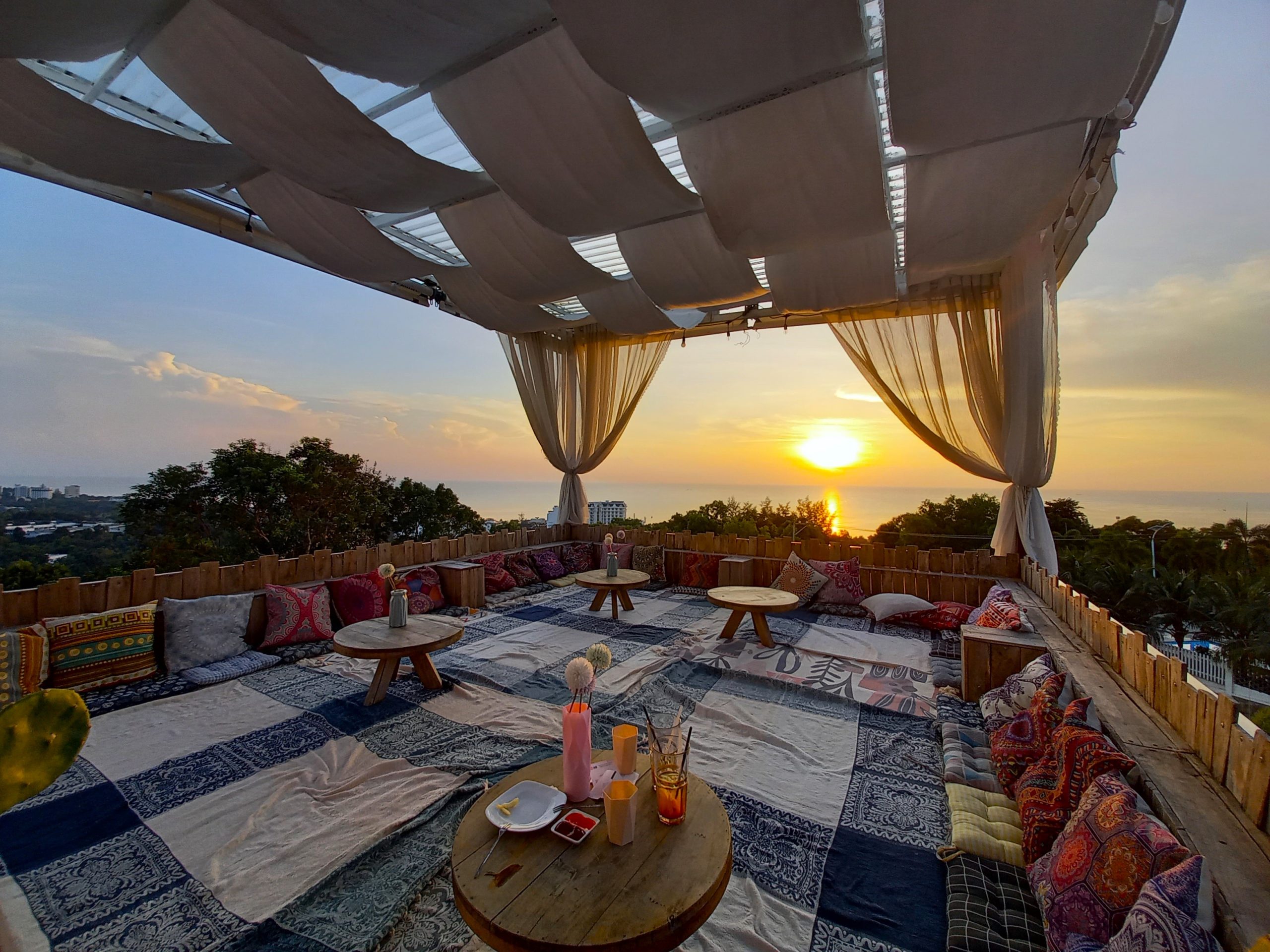

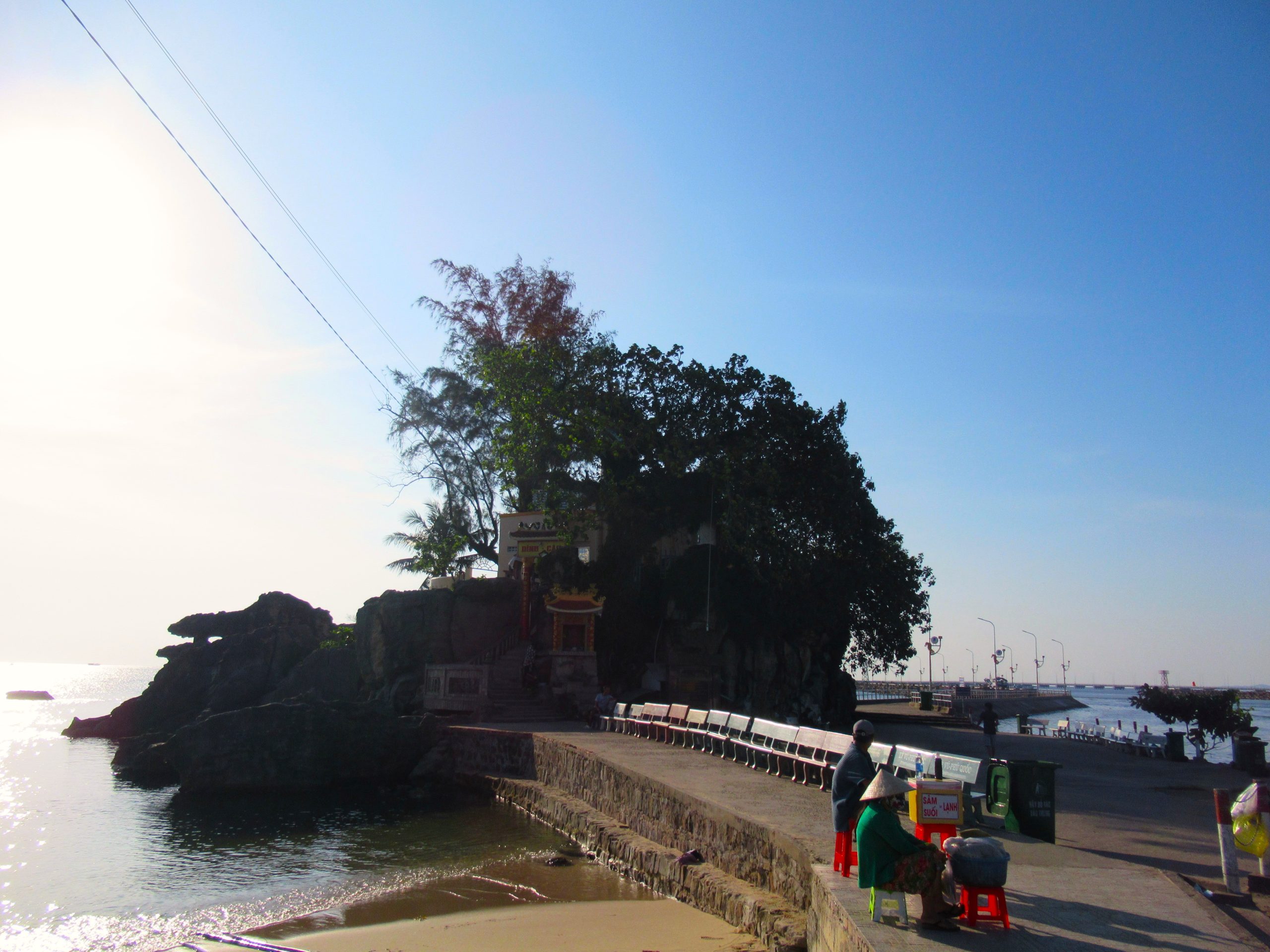
18. An Thới & Xếp Beach:
[View Map]
- Location: south-west coast
- See & Do: local market, street food, bustling port, fishing village, lighthouse, cable car & gigantic Sungroup beach development
- Where to Stay: Phung Hung Boutique ($), Hotel D’Anna ($)
Description: A lively, busy little town at the southern tip of the island, An Thới is Phú Quốc’s main fishing port. Away from its bustling main street lined with shops, markets and street food stalls, the harbour is an interesting place to explore. There’s an entrance fee (10,000vnd) for the main terminal and pier, but you can get to the habourfront just next to it, where the smaller fishing boats are moored, for free. The fishing-related activity is interesting but the water is filthy. Boat tours to the An Thới Islands (just off Phú Quốc’s southern tip) also depart from An Thới’s main terminal. There are some good, cheap hotels in town, including Phung Hung Boutique which has a rooftop bar, and Hotel D’Anna.
Around the back of town (due west), Bãi Xếp is a sheltered bay reached by a series of narrow alleyways. It’s home to a massive fleet of wooden fishing boats and quite a rough-looking fishing community, whose crumbling homes lie under the path of the Hòn Thơm cable car, the concrete pylons soaring into the sky and stretching into the distance out to sea. There’s a sandy beach here which is good to look at, but it’s a working beach and the water isn’t particularly clean. Around the back of Bãi Xếp (due south) a lighthouse stands on a rocky rise with good views over town and towards the An Thới Islands. It can be accessed via a steep and narrow concrete path.
In fact, the best view of Bãi Xếp and An Thới is from above: seen through the windows of the cabins of the Hòn Thơm cable car. The cable car station is on a bluff just north of Bãi Xếp, accessed via a separate road. The scale of the project is astonishing – it’s one of the longest oversea cable cars in the world. The concrete pylons are colossal columns that look like the legs of a Wellsian alien from ‘War of the Worlds’, traipsing across the sea from island to island. It’s impressive, but also rather hideous, as is the entire Sungroup megadevelopment attached to the cable car. It’s not my kind of thing, but it’s fascinating for its sheer scale, if nothing else.
Photos of An Thới & Xếp Beach:
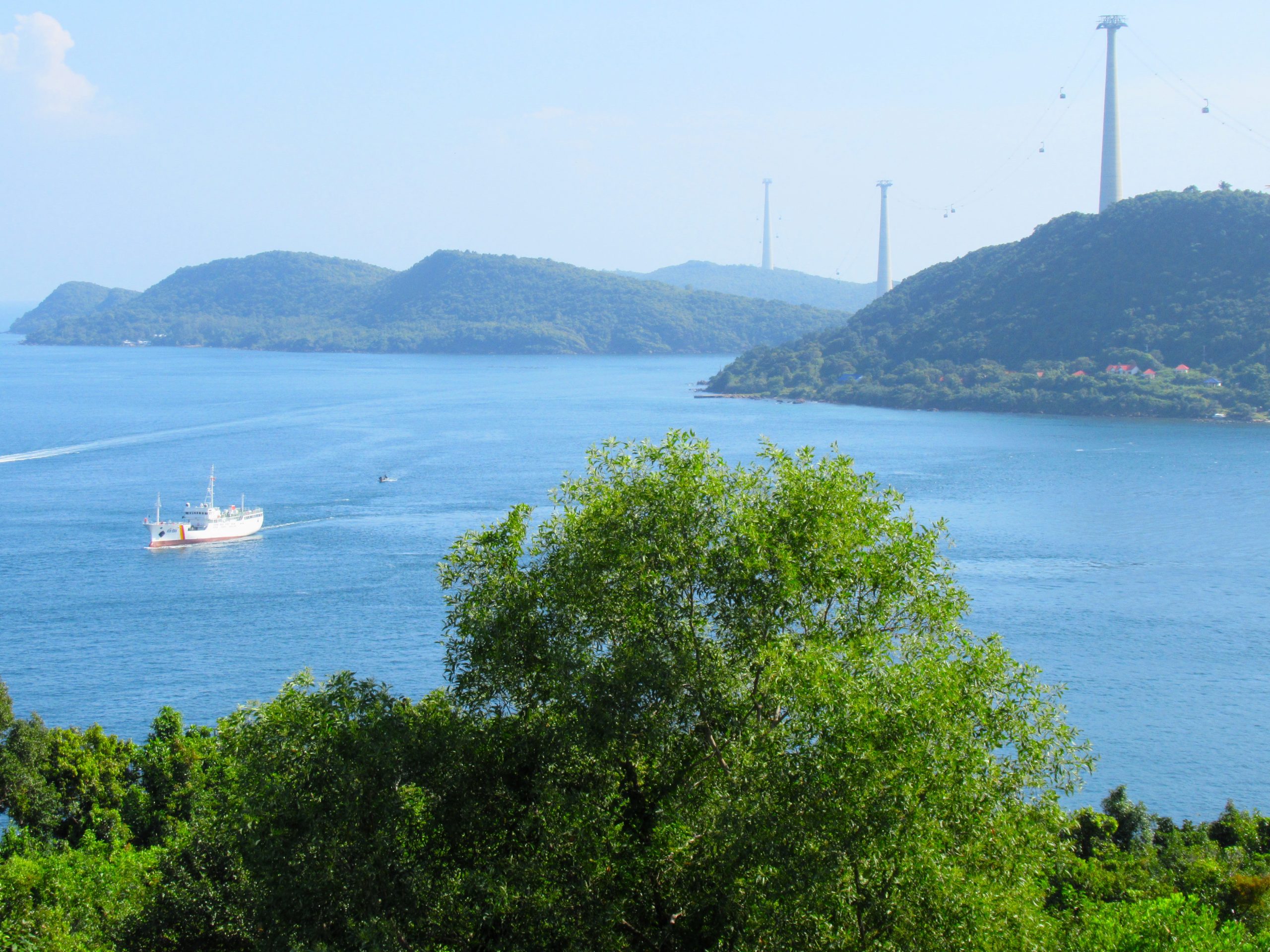

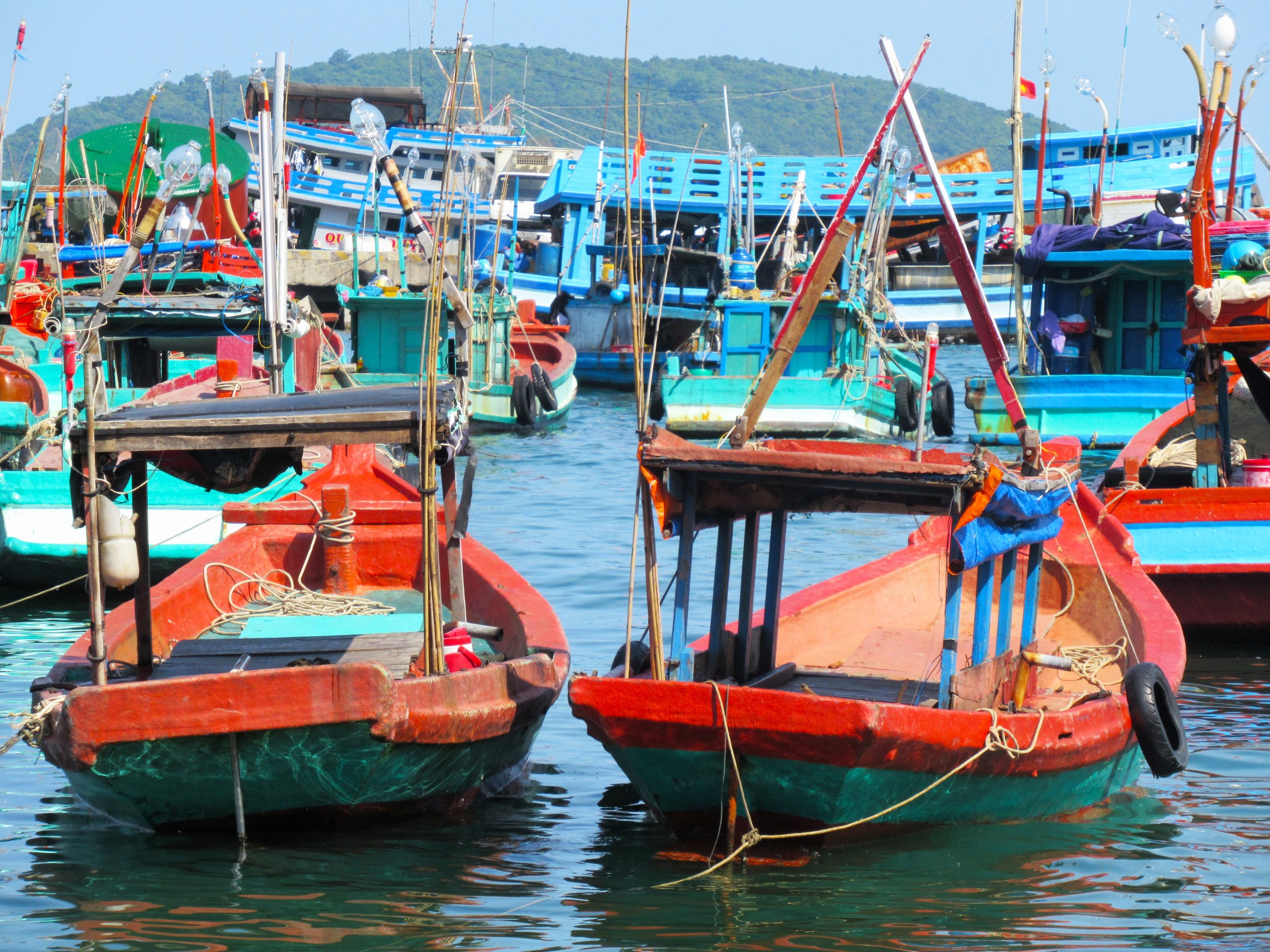
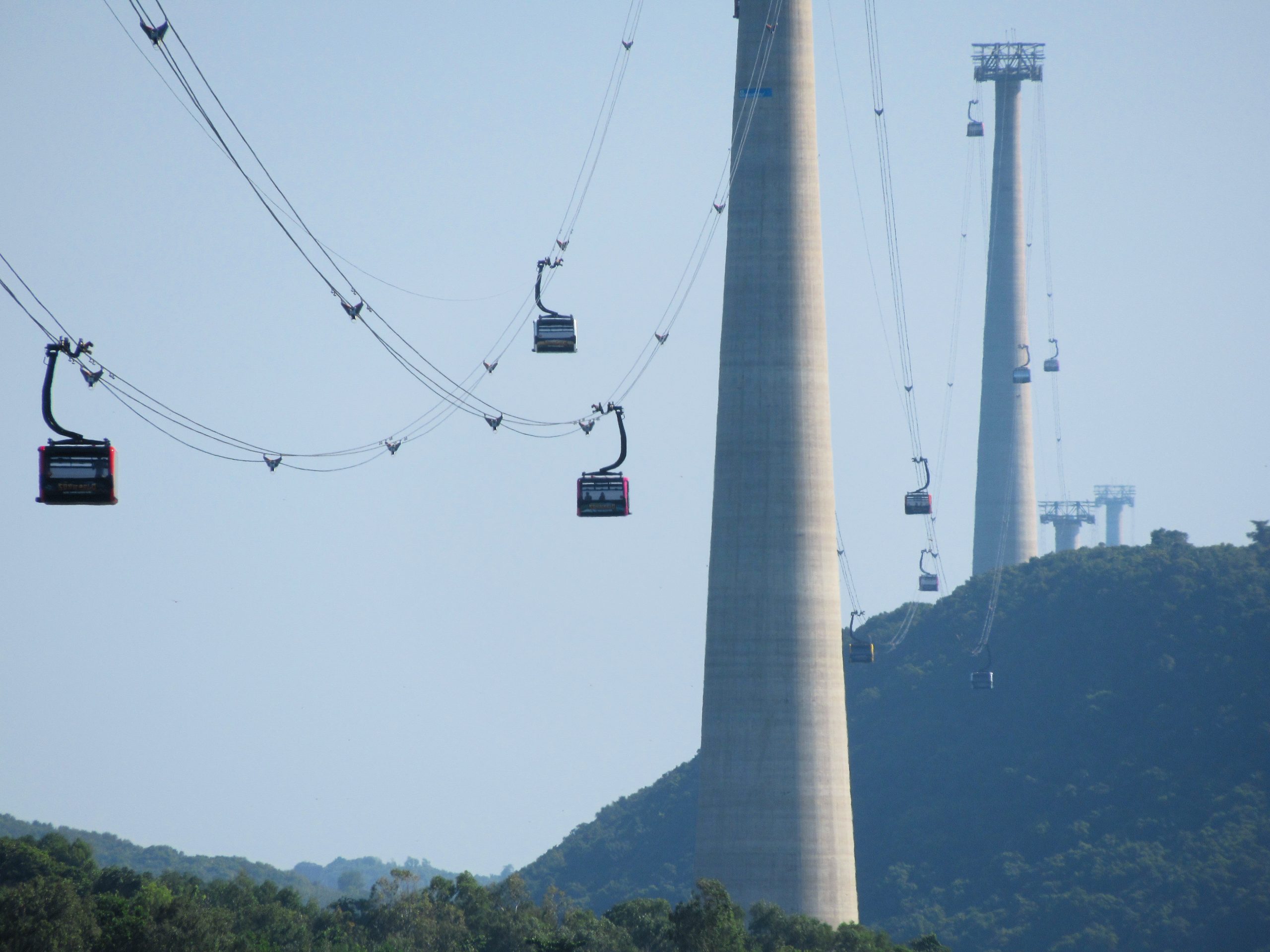
19. Hàm Ninh Beach:
[View Map]
- Location: central east coast
- See & Do: excellent local seafood restaurants, street food, markets, local life
- Where to Stay: Ngọc Trai Xanh Bungalow ($), Aurora Beach House ($)
Description: Once a thriving port, Hàm Ninh village is now best-known for its fresh seafood restaurants, which used to be clustered along a pier, until it collapsed into the sea. Now, the restaurants line the coast road due north of the village. Some of them are excellent, including Tình Biển which offers a range of fish, shellfish and crustaceans served on a wooden platform extending out over the ocean. The village itself is a small but lively fishing community on the central east coast. Hàm Ninh doesn’t really have a beach. Rather, it’s a cluster of concrete and corrugated-iron dwellings crowded around a small river mouth as it empties into the sea, where a collection of wooden fishing vessels lie at anchor in the murky waters. So, leave your swimwear at home and come with a good appetite for a seafood feast. Hàm Ninh also has a good local market with lots of street food stalls out front. It’s busiest during the mornings and late afternoons.
Photos of Hàm Ninh Beach:
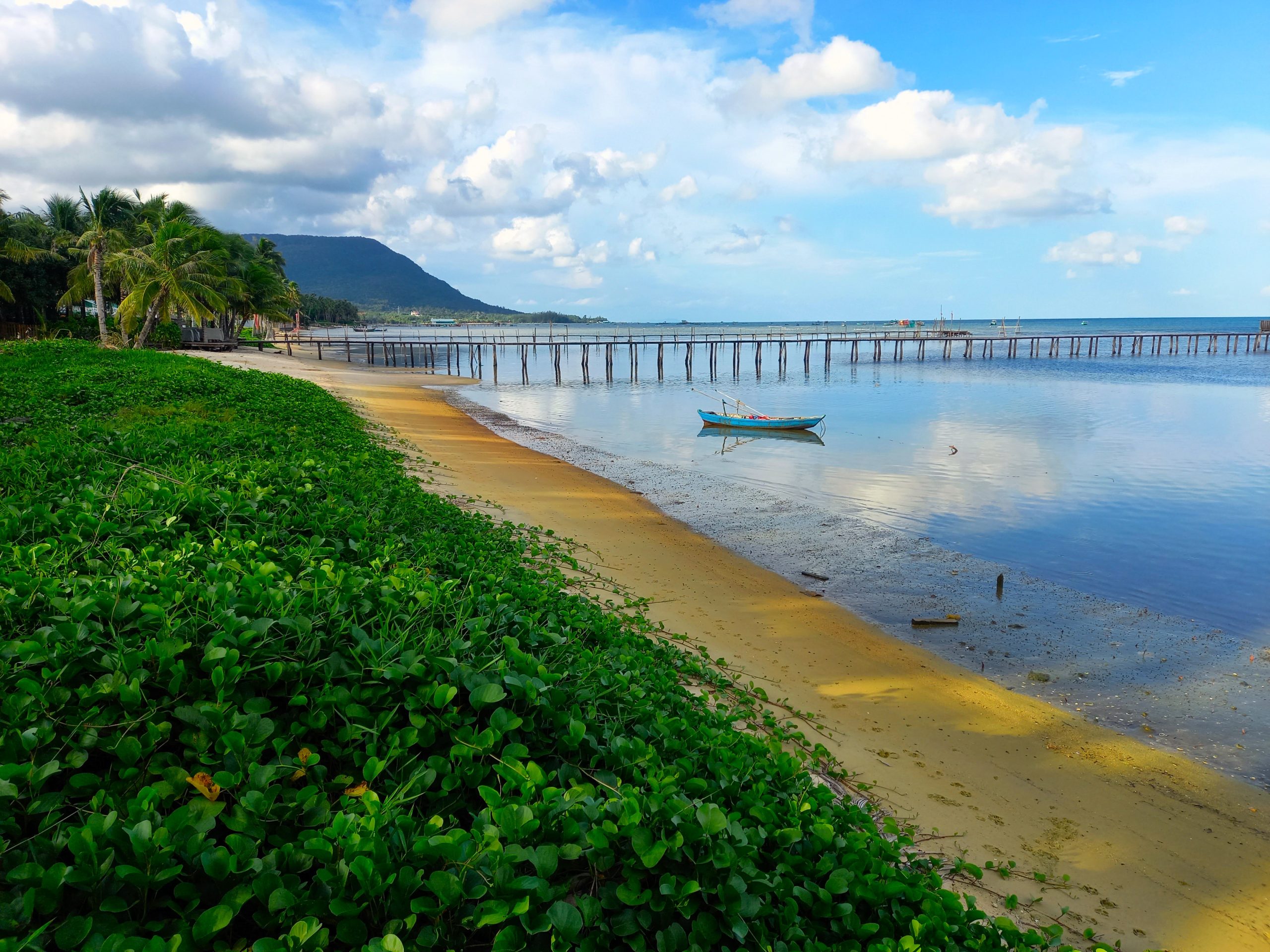
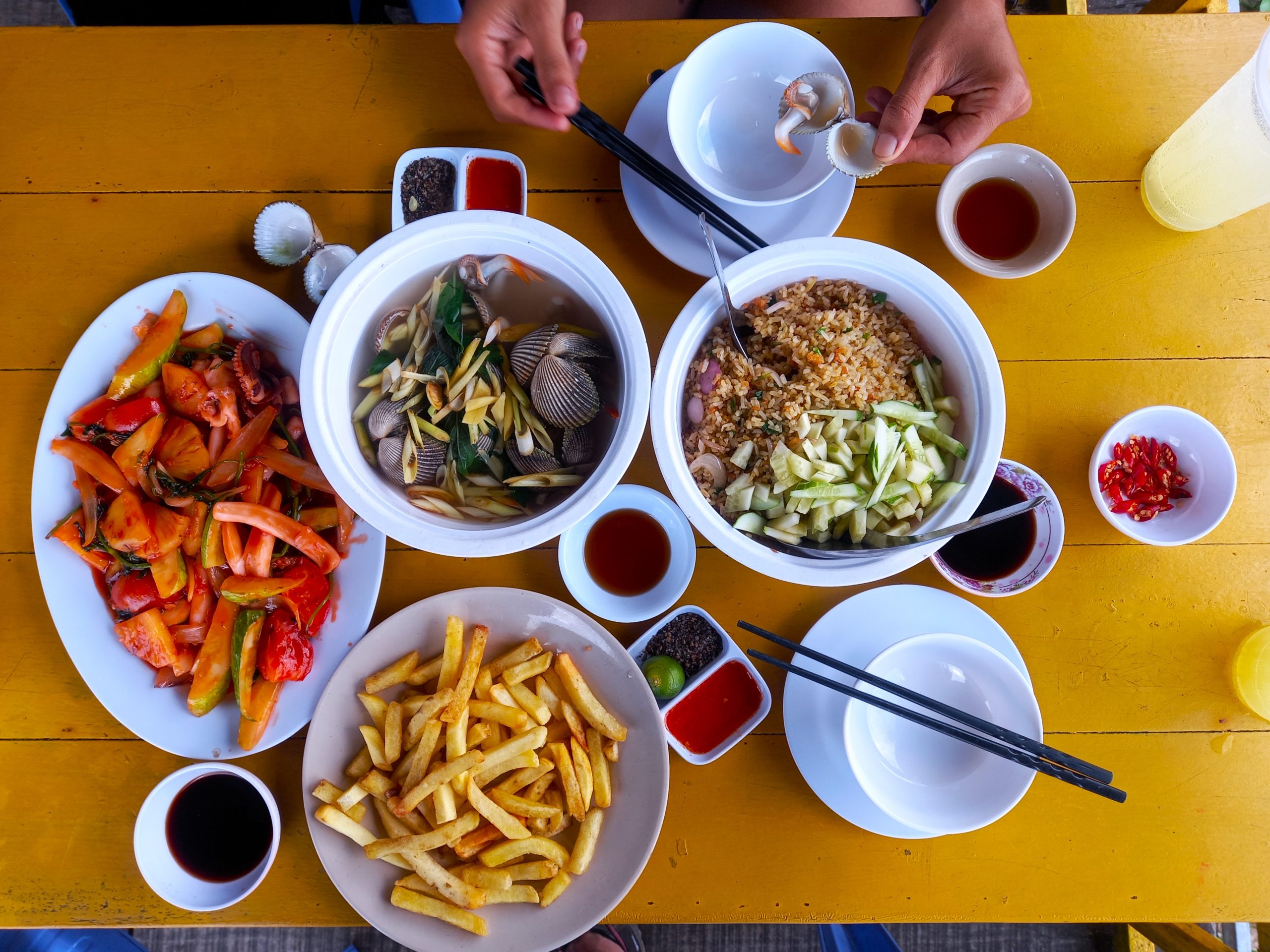
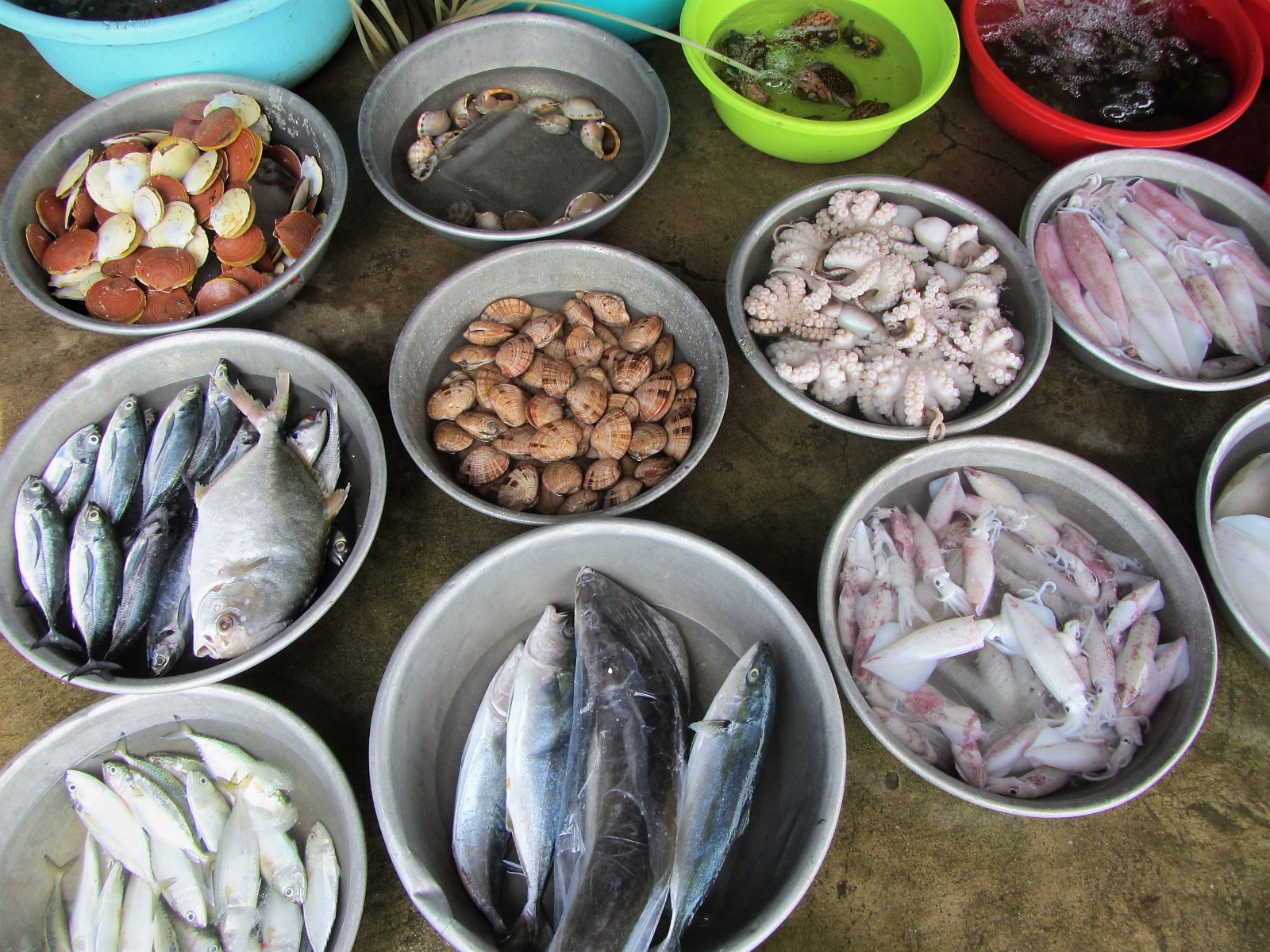
20. Bãi Vòng Beach:
[View Map]
- Location: central south-east coast
- See & Do: take/watch the ferries come & go from the mainland
- Where to Stay: a couple of budget accommodation options
Description: Bãi Vòng is a broad bay on the south-east coast. For some visitors, Bãi Vòng is their first impression of the island, because this is where all the fast boats and car ferries from the mainland arrive and depart. The wide, long bay is impressive enough when seen from the boats as they approach the island, especially with the forested hills of Phú Quốc National Park rising behind. But, in reality, Bãi Vòng is more of a port than a beach: a transportation hub rather than a place to relax on the sand. There are a few shops and snack outlets around the fast boat pier at the northern end of the bay, but very little else of interest, except to watch the boats as they come and go. The northern portion of the bay is sandy and lined with casuarina trees, but the water here is often thick with jellyfish and not very clean. The southern section of the bay is mostly rocky and given over to industry. There are a couple of decent, cheap places to stay near Bãi Vòng which might be useful if you have to take a boat early the next morning.
Photos of Bãi Vòng Beach:

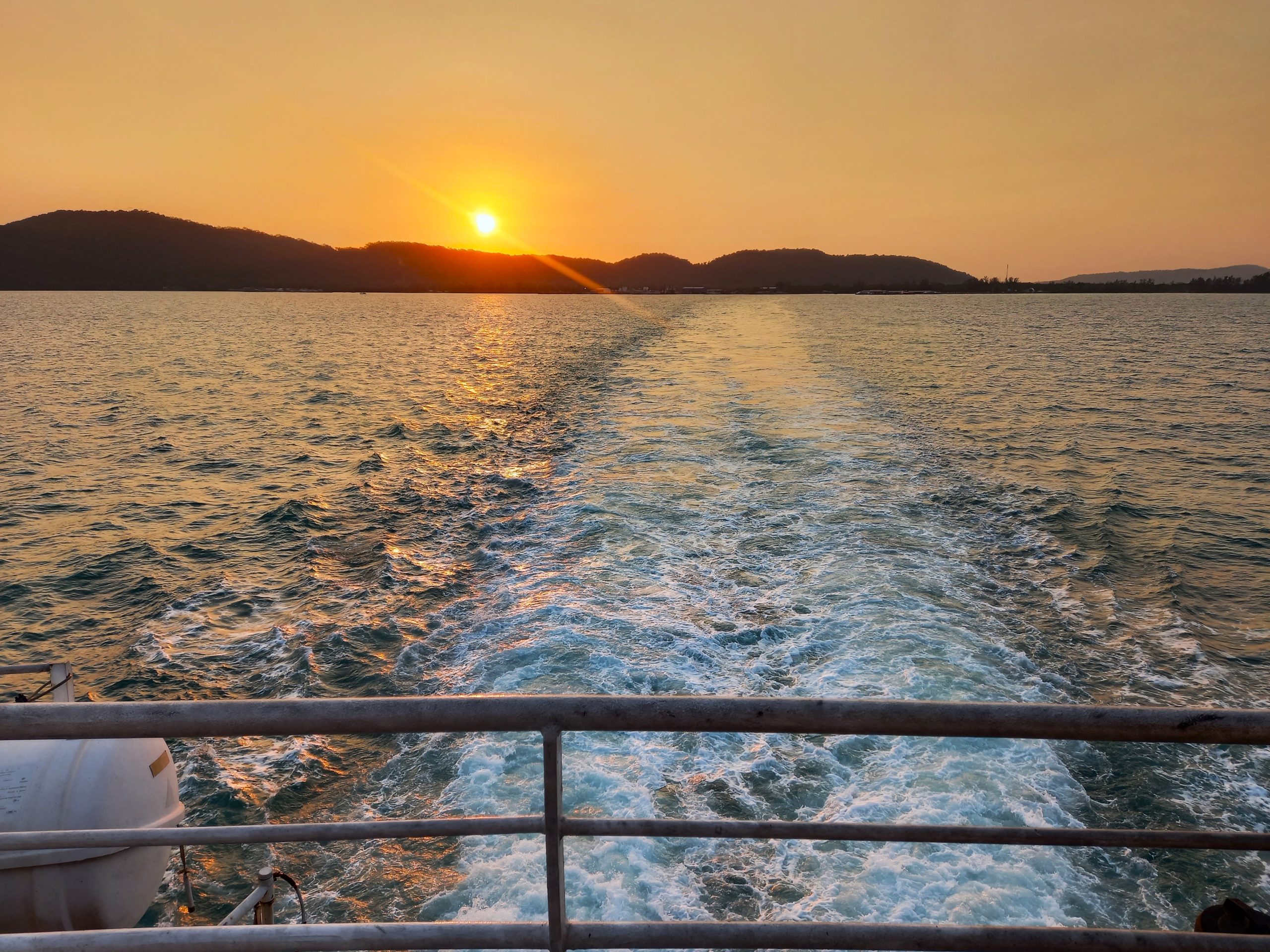
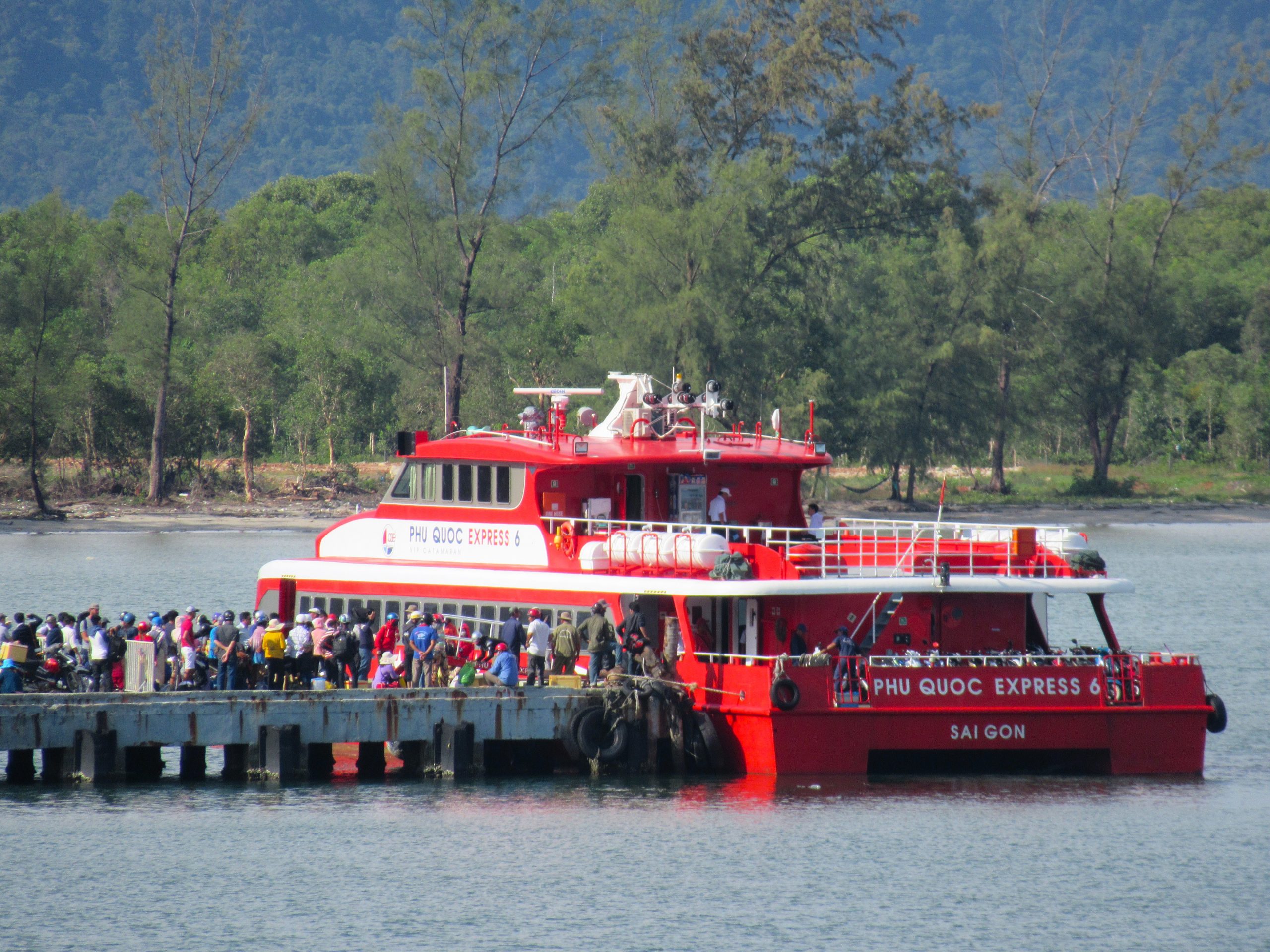
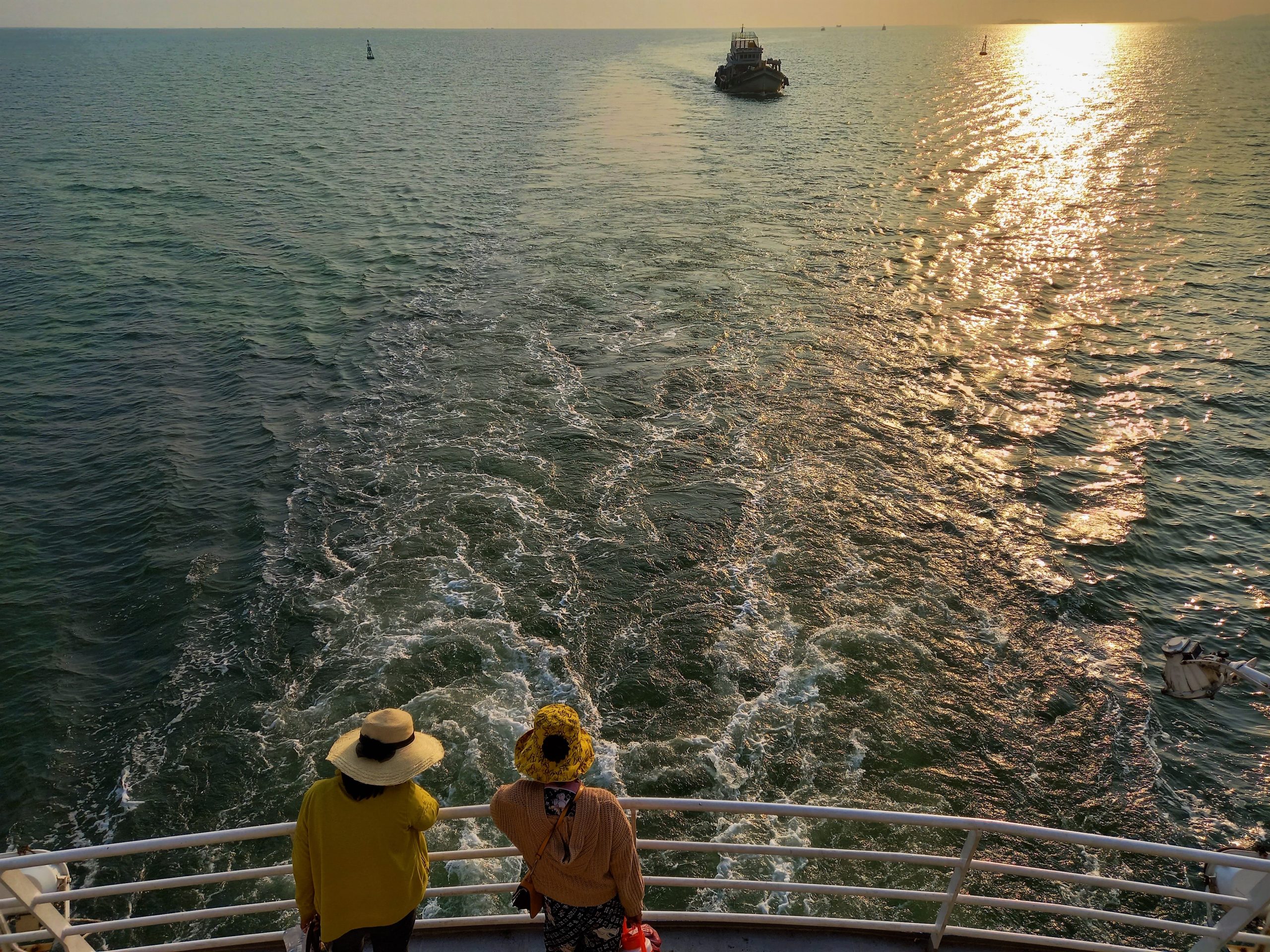
21. Vịnh Đầm Beach:
[View Map]
- Location: south-east coast
- See & Do: under construction
- Where to Stay: under construction
Description: A sheltered bay on the south-east coast, Vịnh Đầm is in the process of becoming a major port and naval base. The southern half of the bay is undergoing large construction for port and naval facilities, while the northern part of the bay has been partitioned off for large resort development. With access to the southern half controlled by the navy, and most of the northern half roped off for construction, it’s very difficult to actually get onto the bay at all. In short: there’s nothing much to see or do here at the moment, but it’s likely that Vịnh Đầm resort and entertainment complexes may open within the next couple of years.
Photos of Vịnh Đầm Beach:

*Disclosure: My content is always free and independent. I’ve written this guide because I want to: I like Phú Quốc’s beaches and I want my readers to know about them. For more details, see the Disclosure & Disclaimer statements and my About Page

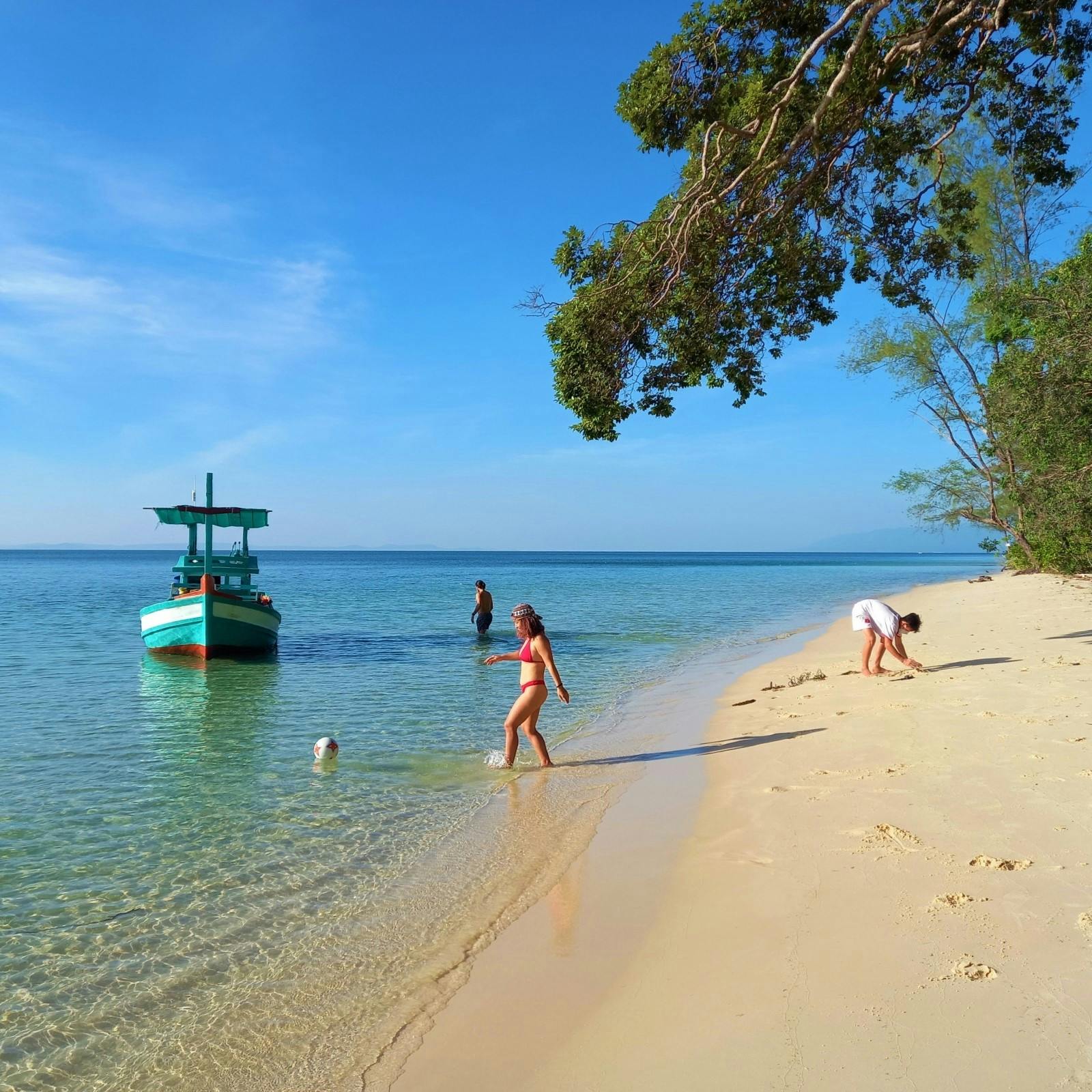
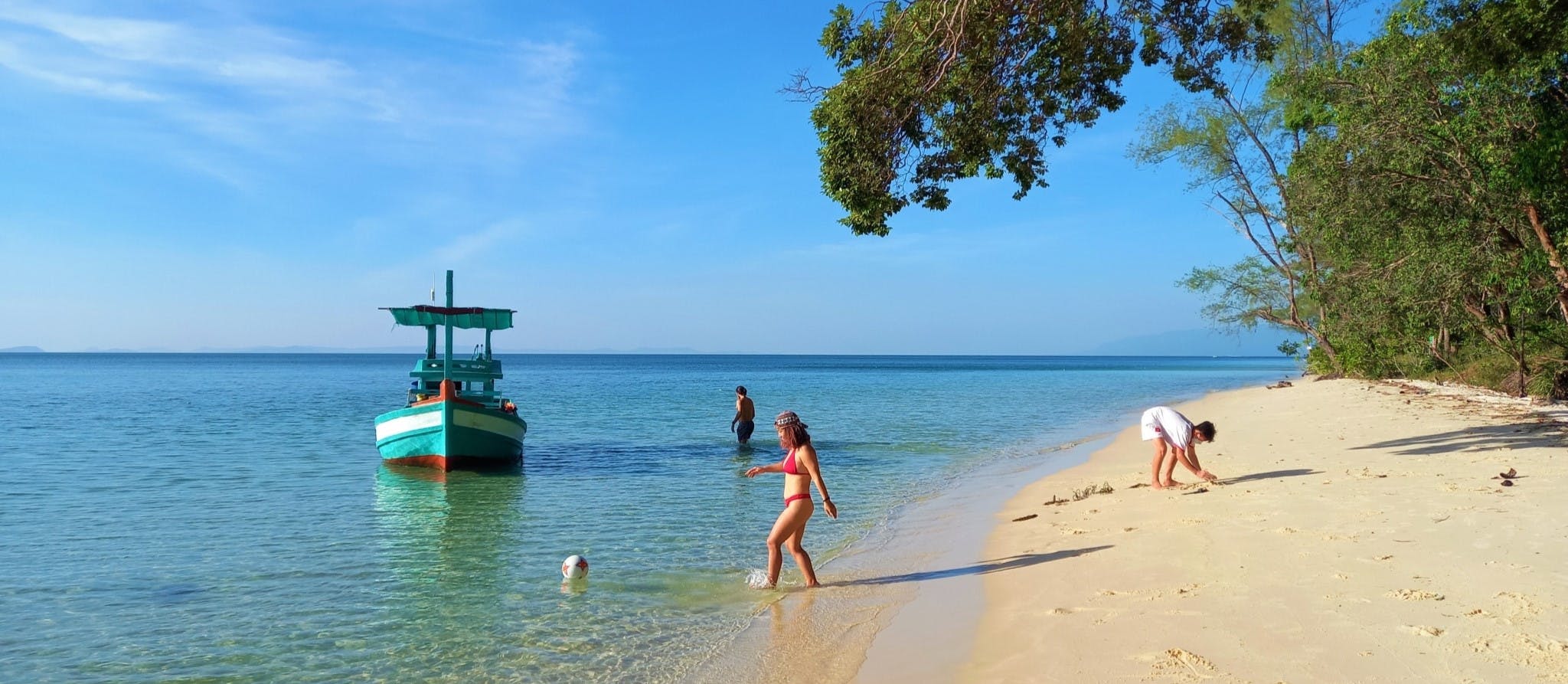


Hi there Tom. I have a much better understanding of the Island after reading these pages. We are two adults and 2 female teenagers travelling to Vietnam in July. Starting north and moving south (tickets already purchased).
Considering the weather in July, are there any particular hotels and/or resorts that stand out for you that are more unique than the larger ones? And any particular tour companies you suggest for island hopping if the weather allows? Is 4-5 nights too many in Phu Quoc in July?
Thank you so much
Brooke
Hi Brooke,
July on Phu Quoc can be OK, but of course it’s rainy season so there’s always the chance of some wet weather.
At that time of year the east and south coast are probably best. Check out the following beaches (including accommodation recommendations) above: Cây Sao, Bãi Bổn, Khem, and Sao.
Kiki Coconut is a very good little resort on the east coast.
Best,
Tom
Dear Tom,
Thanks so much for all of your hard work on this site. I’m a journo myself and have found myself referring to your site when I first went to Vietnam back in 2015, then again in 2018 and now as I research our next trip!
My husband and I wanted to go to Quy Nhon but we are due to be visiting this time in late December (Christmas) and I think it’ll potentially be too rainy in that area of Vietnam. So I’ve been considering Phu Quoc. We did Can Dao the last trip, but wanted somewhere beach to have a few days relaxing in between a visit to Malaysia and before heading up to Hanoi/Mai Chau/Trang An etc. We’re both very much into food (he’s a chef) and so mostly travel for food, but this time we are due to travel with our 20 month old son for the first time! As such, I’m trying to balance our love of traveling for food, with his needs.
Do you feel Phu Quoc is still quiet enough (ie: not so touristy) these days if we head to the north-western part of the island? I saw you’d updated this post last year so just wanted to get your feedback. My husband isn’t so keen, and I’m trying to convince him that some beach time will be worthwhile!
If you can give any steer I’d really appreciate it!
Thanks again,
Alwynne
Hi Alwynne,
Yes, Phu Quoc is nice in December. Prices are usually a bit higher then because it’s high season. Enjoying Phu Quoc is a lot about choosing where to say: if you stay in a good resort on a good beach, then you will almost certainly enjoy it. For example, the places on Ong Lang Beach, such as Mango Bay, are very good and it doesn’t get too crowded. Or somewhere like Gold Coast on Ganh Dau Beach. Both those resorts also have good food, and there are other restaurants and some street food within walking distance of them. There are some nice places to stay on Long Beach, but it can get quite busy. In the guide on this page, I recommend some places to say for each beach, plus links to Agoda so you can check prices and photos. Also, take a look at my Phu Quoc Resorts Reviews.
Phu Quoc is actually quite good for food: local seafood is good, and there are a few island specialites too, plus lots of street food in Duong Dong town and Ganh Dau village. Take a look at my Phu Quoc Food & Drink page.
Also, when you head to the north, you might consider Pu Luong Nature Reserve instead of/or as well as Mai Chau and Ninh Binh. It’s a really beautiful area with great accommodation.
Best,
Tom
Hi Tom,
Thanks so much for the feedback. I really appreciate this.
Would you say that Pu Luong offers enough difference to Mai Chau/Ninh Binh to warrant adding it on, or would you just do two of those?
We also looked at going north closer to the Chinese border (Ha Giang) but I wasn’t sure if it’s worth it with a toddler given we can’t go on motorbikes and it’ll be January. Let me know if you have any thoughts.
Thanks again,
Alwynne
Hi Alwynne,
Personally, I would choose to stay and explore Pu Luong and Mai Chau, and leave out Ninh Binh.
You could travel Ha Giang on a car tour, but it’s not as good as on a motorbike.
Best,
Tom
Dear Tom,
Thank you for this well-detailed guide. We’ll visit Phu Quoc in late October this year (26th-30th) and I wonder which beaches on which side of the island would be better to avoid the pollution that the current and wind bring in this period or any other negative factors that I’m not aware of. My other priority is to stay near a beach with public access, it would be a bummer to see a beautiful beach and not be able to reach it!
I appreciate any help you can provide. Best.
Hi Anilk,
Late October should be a good time to stay on the west coast beaches. Try Ong Lang, for example.
Best,
Tom
Thanks Tom!
you have a great web page!! after reading, I’m still unable to pick a area, wondering if you could help.. I want beach front (with quite laid back attitude) yet still close to a town for night markets etc, can you point me in the correct direction??
Hi Louis,
Try Ong Lang Beach.
Best,
Tom
Thanks
Hi. If I could I’d like to ask you a question or three please? We are a family of 4 with children 24 and 20. We like to both relax and also see what places have to offer and explore. We’re visiting in August. Would you say Phu Quoc or somewhere else like Nha Trang (we’ve been to Danang) would be best for weather and experience please? Open to ideas but I would like a paradise beach if possible. Thanks.
Hi Jane,
Phu Quoc isn’t at its best in August, unless you stick to the south of the island or the east coast. Although resorts are much cheaper at that time of year.
You should consider Con Dao Island, Quy Nhon and the beaches to the north and south of it, such as the Crown Retreat and Timothe Beach.
Nha Trang and Cam Ranh would also be good.
Best,
Tom
What a wonderful and informative website.
Why is Phucuoc in August not at its best?
Which southern beaches?
Hi Daniel,
Thanks.
August is the rainy season so the weather isn’t as good as the dry season and the sea can be rough.
For the southern beaches, take a look at the map.
Best,
Tom
Hi Tom
Congratulations on an awesome website, I am finding it very useful as I research my family’s upcoming trip
One question, I am planning on heading to Phu Quoc in July. I understand it’s not the best time to travel there but wondered if it’s rains for short bursts or whether it’s likely to rain for days on end
Any advice or insight would be greatly appreciated
Thanks
Rachelle
Hi Rachelle,
Yes, that’s the rainy season on Phu Quoc. I was actually living on the island at that time of year in 2021. There was quite a lot of rain, but the main issue is that the sea can be relatively rough and grey, which means that swimming isn’t that good/easy, especially on the west coast.
On the other hand, tourist numbers are fewer and hotel prices are lower. It’s difficult to make a decision. I think if you want to guarantee sun, sea, sand and swimming then July might not be the best month, and you might be better off choosing a different beach destination: Con Dao, Nha Trang, Quy Nhon, Hoi An, Da Nang all have better weather and sea conditions at that time of year.
Best,
Tom
Thanks so much, really appreciate your advice!
Hi Tom,
first of all thanks a lot for your amazing website. All the articles with the attached google maps are very useful. The best website and guide to Vietnam, we have found.
I would have a very specific question, if you wouldn’t mind. We are going to Phu Quoc an Tuesday and will be staying until Friday. Unfortunately, on Wednesday evening we have
to join a very important online meeting (a start-up pitching competition). We are searching for a place to stay, where they have a stable internet connection and maybe even a laptop, which we could borrow for the 1-hour long evening session (we have only phone with us). Would you have an idea, which hostel/homestay/place would be open to such a special wish and would have a good internet connection?
Thanks a lot!
Ladislav
Hi Ladislav,
The internet is pretty stable on the island. However, if you want to be more certain of a good connection and of being able to communicate successfully to staff what you need (a laptop, for example), I think you will find it much easier in a mid-range accommodation, rather that a budget one. Also, a place that’s nearer town, rather than on an isolated beach.
You should also buy a Vietnamese SIM card and get data, then you have a back up if the internet connection isn’t stable.
Best,
Tom
Hi Tom,
thanks a lot for your answer. All accommodations which we visited on Ong Lang beach had really fast wifi, so we ended up in one of those. And it went well eventually. 🙂
Best regards,
Ladislav
Hi Ladislav,
I’m glad to hear that.
Tom
Thank you so much for your amazing travel guides. I’ve a question about visiting Phu Quoc in late March/early April, and was hoping you could help. What is the weather typically like at that time of the year? Thank you in advance.
Hi Johanna,
Thanks for your message.
Usually the weather on Phu Quoc is March/April is very good: dry, sunny, bright and very hot 🙂
I hope this helps,
Tom
Thanks! Yes, helpful. Chúc mừng năm mới!
Hey! Just spent the day at Ham Ninh and the bridge to the floating fishing village collapsed. It’s very difficult to get there now. Very sad.
Hi Vanessa,
Sorry to hear that. And thank you for the update – much appreciated.
Tom
Hi Tom,
I spent 6 days at Gold Coast resort, Ganh Dau, with my wife and 2 kids. It was absolutely perfect, we loved it. Thank you so much for your good advice ! Clear water beach, snorkeling, kayak, free bike, 250k VND/day for a motorbike, this resort has everything needed !
Thanks again Tom !
Hi Tom,
Thanks for your comment. It’s great that you enjoyed Gold Coast with your family. That’s also where my parents and I like to stay too 🙂
Tom
Great piece of work you have done Tom. As usually your descriptions are detailed and fair. Thanks for showing the damage and dirt at some of the places. Last year we spent a week at the island and my comment could be summed up that it is a paradise turned into an environmental disaster area. Unless the authorities and local people do something to clean the place – not only the beaches but generally the island the charm of the place will be gobe for ever. The fact that resorts and hotels care just for what belongs to them and do not mind smelly waste containers just outside their parameter is a sorry picture. But the work you are doing to open potential visitors’ eyes so that they come well informed and prepared is just fantastic.
Hi Jerzy,
Yes, there’s non doubt that large parts of the island have been damaged irreparably by construction and litter. But it is a big island, and now that the north and east coasts are more easily accessible, they have plenty of charm, local character, local life, food and undeveloped beaches to explore. I’ve written in detail about that in this guide. Of course, it remains to be seen how the north and east coasts develop in the next few years, but there are plans to create a large eco-tourism area in the north. Also, even on the more developed west coast, there are some really lovely places to stay on beautiful stretches of beach: it’s all about choosing the right place and the right beach. That’s what this guide tries to help people to do.
Tom
Hi Tom,
Thank you for this great article, very well documented !
We booked 6 nights at Gold Coast Resort at Ganh Dau.
We really appreciate your work.
Thanks again Tom !
Hi Thomas,
Thanks! I hope you enjoy it there at Gold Coast.
Tom
It was absolutely fantastic!
Actually I think Gold Coast Resort is even more beautiful in real than what it looks like on photos. Staff is so friendly, the restaurant food is great, and I had big fun riding a motorbike (directly in the resort for 250KVND/day) through the jungle road 🙂 Location of the resort is perfect: 15mn from the village by walking, and the private beach is just awesome: quiet, calm and clean. Just one thing: beware of the sea urchins: their needles are damn long and there is heaps of them in some areas …
Thx again Tom!
Hi Thomas,
Really great to hear you enjoyed your time at Gold Coast – and thanks for the warning about the urchins 🙂
Tom
Hey, we want to travel to a beach between September 21 and 23 from saigon.. Would mui ne be better or would phu quoc be better. I’ve read literally all the comments and I’m basically more confused than ever
Hi Elizabeth,
Well, there’s no ‘right’ answer to that question. Phu Quoc is more beautiful than Mui Ne. But it really depends on where you stay – if you’re in a nice accommodation, I’m sure you’ll enjoy either.
Phu Quoc is an island whereas Mui Ne is just a beach, so Phu Quoc has more choice and variety. Personally, I would choose Phu Quoc.
I hope this helps,
Tom
Hi
Thank you for a thorough and enligtening post !!
We are coming in august and were looking for a wite sand quiet palm trees cristal water beach… witch is best recomended at this seoson ? (Rainy seoson ?)
Hi Gael,
That’s difficult to say, because the water quality isn’t the same during the rainy season, and the seas are often choppy. The good thing is that the prices go down significantly, because it’s the low season 🙂
Tom
What an awesome blog post and website! I just wanted to say how much I appreciated your thoroughly researched and very helpful post – my boyfriend and I used it to explore the island. I will be checking in again for more tips and advice! 🙂 Thanks!
Thanks, Iga.
It’s great to hear you enjoyed Phu Quoc and that my guide was useful.
Tom
Hi Tom,
It is indeed very useful article. I’m travelling to Phu Quoc on 13th April, we have 8 pax and thought of staying in VinOasis. Is there any street food/affordable restaurant nearby? Looking forward to hear from you.
Thanks.
Hi Eleen,
Not really. That area is almost all exclusively big resorts now. Ironically there is street food available on the main road there because that’s where all the construction workers (who are building the big resorts) go to eat. But it’s not especially good street food. Instead you can head into Ganh Dau village to the north for street food.
I hope this helps,
Tom
Thank you for your guide to the beaches. Totally spot on and I ended staying in your no 1 choice and absolutely loved it. Its the place away from the busy places I was looking for. Thanks for creating this guide!!
Hi Maja,
Really great to hear that. Glad you enjoyed it.
Tom